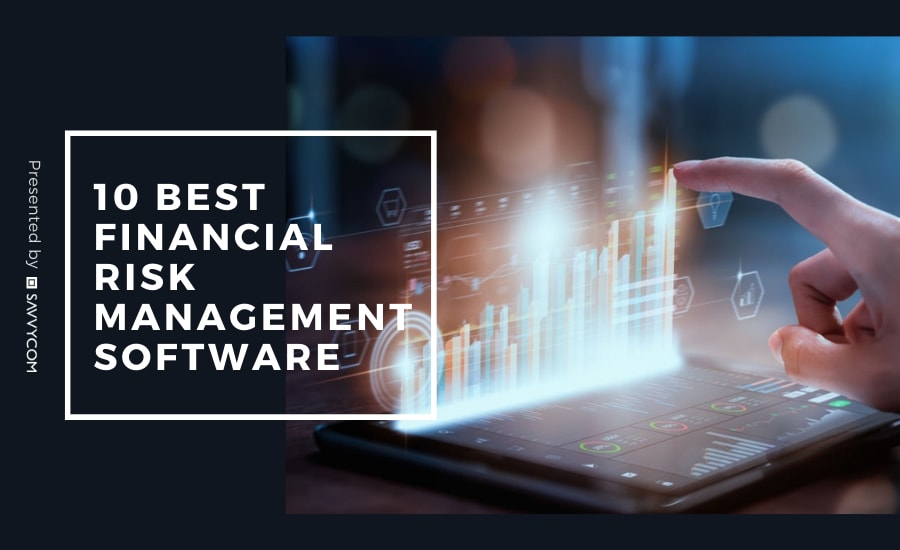
Financial Risk Management Definition
“Financial risk management is the practice of protecting economic value in a firm by using financial instruments to manage exposure to risk. Similar to general risk management, financial risk management requires identifying its sources, measuring them, and plans to address them. Financial risk management can be qualitative and quantitative. As a specialization of risk management, financial risk management focuses on when and how to hedge using financial instruments to manage costly exposures to risk.” – Wikipedia
To make it simple, financial risk management is minimizing risk negative impacts on assets by appropriate financial. instruments
10 Best Financial Risk Management Software
01. Kyriba
Kyriba empowers financial leaders and their teams to manage liquidity, generate value while shielding financial risks. Internal applications for treasury, risk, payments and working capital, with vital external sources such as banks, ERPs, trading platforms, and market data providers are all connected by Kyriba’s pioneering Active Liquidity Network. Based on a highly secure, 100% SaaS enterprise platform, Kyriba delivers superior bank connectivity and a seamlessly integrated solution set for handling complex financial challenges. Kyriba has become the financial risk management software provider for thousands of companies, including many of the world’s largest organizations in New York, Shanghai, London, Singapore, Tokyo, Paris and many more. The software is supported in Arabic, English, French, German, Spanish, Italian, Chinese, Polish, Portuguese, Japanese, Russian, Romanian, Serbian.
Main features:
- Treasury Management
- Fraud Detection
- Risk Management
- Supply Chain Finance
- Payments
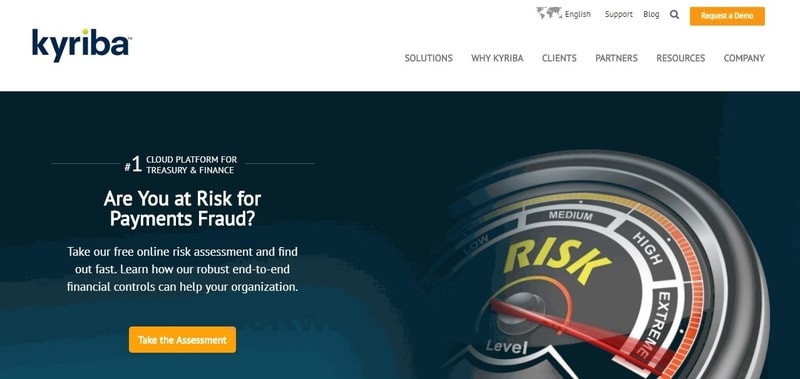
02. Murex
Murex’s MX.3 shortens the gap between the capital market operators and financial risk management systems. The platform enables financial services firms to participate in capital markets and efficiently manage the credit, liquidity risk and market across all asset classes despite complex and far-reaching regulatory requirements through offering cutting-edge risk solutions.
The software can deal across numerous asset instruments and classes, making it flexible and easily integrated within existing IT and risk infrastructure institutions.
“Strong end-to-end capabilities from front office, to middle office and back office. Project management team is solid; deliver team (and support) is responsive. Prices can be quite high compared to competitors.” Review by a Program and Portfolio Manager on Gartner
03. SmartRisk
SmartRisk is a financial risk management tool specially designed to support financial advisors in analyzing portfolio risk to motivate clients to make portfolio changes, retain clients during a down market and prevent clients from making investment mistakes. Clients are often not sensitive to market risk and don’t have precise downside expectations either too conservative or too reckless, resulting in inaccurate investment allocations. SmartRisk empowers advisors to communicate efficiently with clients to avoid investment mistakes.
Main Features:
- Portfolio Modeling
- Reporting
- Risk Analytics
- Market Risk Management
- Portfolio Management
- Portfolio Modeling
- Reporting
- Risk Analytics
- Stress Tests
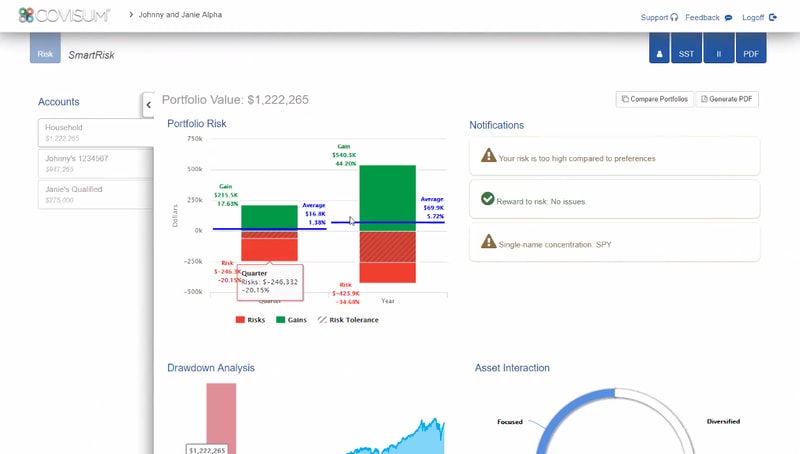
04. FactSet
FactSet is the financial risk management software focusing on time-management problems. The platform is equipped with multi-asset class portfolio analytics, saving advisors time in managing data. With advanced portfolio analytics, performance, and attribution, clients get an unparalleled combination of portfolio equity and fixed income analytics, data concordance management, workflow capabilities, and data distribution for internal and external clients.
Main Features:
- Portfolio Analytics:
- Performance & Attribution
- Connected Teams
- Unique Content
- Performance Drivers
- Flexible Reports
- Risk Analytics:
- Optimized Portfolios
- Risk Models
- Risk Over Time
- Connected Teams
- Stress Testing
- Quantitative Research:
- Portfolio Simulation
- Backtesting
- Data Exploration
- Characteristics Analysis
- Portfolio Optimization
- Performance Measurement & Attribution:
- Returns Analysis
- Relative & Absolute Performance
- Integrated Data
- Reporting & Distribution
- Attribution Models
- GIPS Compliance
- Client & Portfolio Reporting:
- Consistent Branding
- Trusted Analytics
- Commentary in Seconds
- End-to-End Reporting
- User-Empowered or Managed Services
- Oversight and Approvals
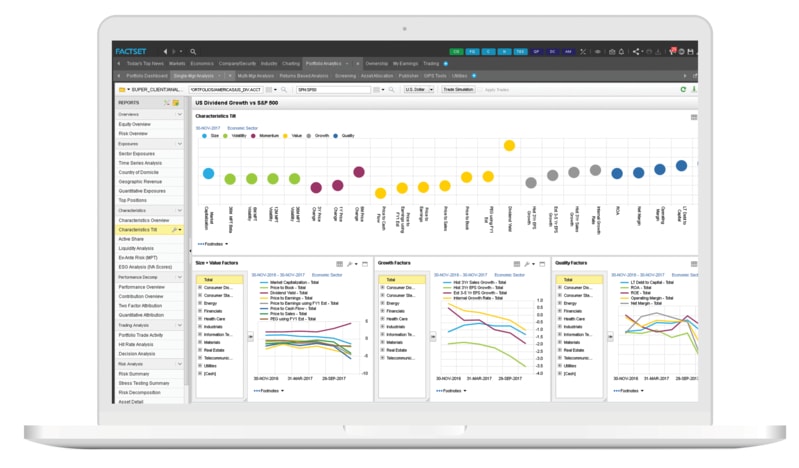
05. Calypso
Calypso delivers cross-asset solutions for trading, risk, processing, control derivatives, treasury and securities systems. The users of Calypso include sell-side financial institutions such as banks and prime brokers, buy-side firms such as investment managers, asset managers, hedge funds, family offices, insurers and corporations, as well as treasury services providers including exchanges, clearers and service consortiums.
Main features:
- Compliance Management
- Credit Risk Management
- For Hedge Funds
- Liquidity Analysis
- Market Risk Management
- Operational Risk Management
- Portfolio Management
- Reporting
- Risk Analytics
06. FINCAD
FINCAD is an integrated multi-asset portfolio and financial risk management software company. The platform is transparent with comprehensive cross-asset coverage and documentation of all models, calculation methodologies, and references. The clients of the software include firms such as investment managers, asset managers, hedge funds, pension funds, banks, auditors, insurers and corporations. With various tools, FINCAD enables financial firms to manage risk while complying with sophisticated regulations.
Main features:
- Portfolio management
- Portfolio analysis
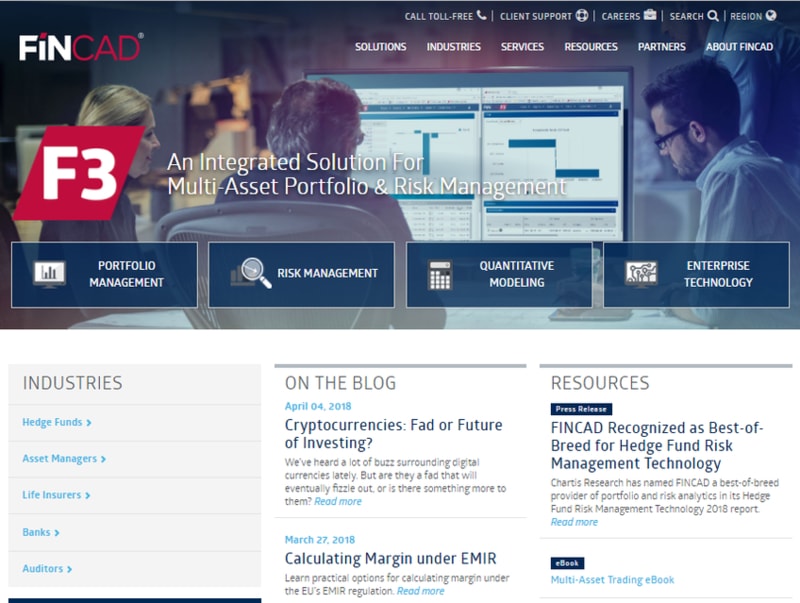
07. GTreasury
GTreasury is a platform that gives firms cloud access to an end-to-end workflow for integrated treasury management and financial risk management solutions and services. Its single database, connectivity and workflow unifies technology and makes working smarter. GTreasury offers a SaaS solution that can integrate Payments, Cash Management, Financial Instruments, Banking, Accounting, Risk Management, and Hedge Accounting.
Main features of this risk management product:
- Cash Management
- Financial Instruments
- Banking
- Accounting
- Funds Transfers
- SaaS & Installed Platforms
- Illuminating Liquidity
- Treasury
- Treasury Management
08. D&B Credit
D&B Credit is a cloud-based financial risk management software powered by Dun & Bradstreet’s industry-leading data and analytics. Finance and credit professionals can function more effectively and drive sustainable and profitable growth with the help of powerful portfolio segmentation tools, configurable alert tracking, and easy-to-read digital credit reports. The system supports multiple languages, currencies and provides customizable views, tagging options to flexibly manage customer portfolios.
“That recommended credit limit is paramount to us…I love the way that the data flows.” Paul Laska, Credit Manager, A.N. Deringer reviews on D&B Credit website.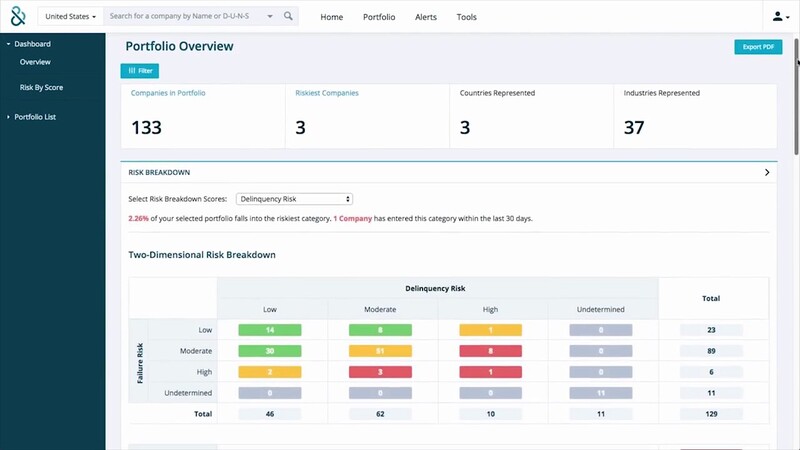
09. MetricStream
MetricStream is a leading provider of enterprise and cloud applications for governance, risk and compliance (GRC). M7 Operational Risk Management is a popular system developed by the company, supplying numerous tools to establish efficient operational risk management. The system is easily integrated into users’ companies’ risk management processes to enhance financial performance, protect investment capitals and equity.
“We’ve successfully rolled the tool out to all 3 lines of defense and are overall pleased with the realized value. Through MetricStream we’ve also purchased additional Tableau licenses, which allows us to manipulate, analyze, and present the data in ways that we weren’t capable of pre-MetricStream and common GRC framework.” – Reviewed by a Risk Analyst on Gartner
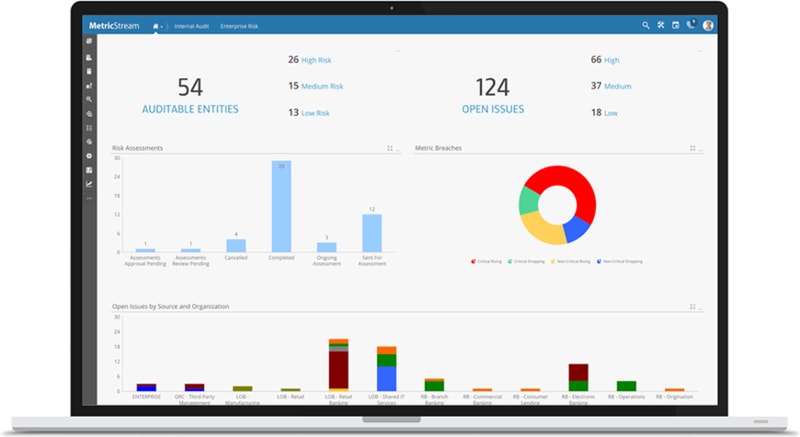
10. Reval
Reval is a leading treasury and risk management platform, including managing cash, liquidity and financial risk through its cloud-based offerings, helping clients with their usage of financial instruments and hedging activities. Thanks to the cloud platform, clients can optimize operational efficiency, security, control and compliance, enhancing the overall performance.
Main features:
- Risk Management
- Hedge Accounting And Compliance
- Cash And Liquidity Management
- Treasury Management System
- SaaS
Savvycom – Your Trusted Tech Partner
Savvycom offers expertise in tech consulting, end-to-end product development, and software outsourcing, utilizing digital technologies to drive business growth across industries. With a focus on delivering high-quality software solutions and products, we provide a wide range of related professional software development services tailored to your specific requirements.
Savvycom is right where you need. Contact us now for further consultation:
- Phone: +84 24 3202 9222
- Hotline: +84 352 287 866 (VN)
- Email: contact@savvycomsoftware.com
How often should risk assessments be performed?
Risk assessments should be performed regularly and whenever significant changes occur within a business or its external environment. Typically, businesses conduct these assessments annually, but more frequent assessments may be necessary in rapidly changing markets or industries.
Additionally, it's crucial to reassess risks when introducing new products or services, entering new markets, or experiencing major organizational changes, This ensures that all potential risks are identified and managed effectively.
What is financial software?
Financial software, also referred to as financial system software, serves as a specialized toolset aimed at streamlining and managing monetary activities across businesses, organizations, and personal finances. These solutions encompass a diverse array of functionalities, ranging from accounting systems and payment gateways to budgeting apps and financial forecasting tools.
By automating tasks and facilitating transactions, financial software significantly enhances efficiency and ensures accurate financial reporting. It empowers users to track expenditures, monitor revenues, manage budgets, and adhere to regulatory requirements, fostering financial transparency and accountability. As digitalization gains momentum, the demand for robust financial software grows, spurring innovation and evolution in the fintech industry.
We take pride in being one of the foremost software development companies and IT outsourcing services in the ASEAN region. Savvycom offers comprehensive assistance for your business in planning and developing financial analysis software solutions, all without the burden of excessive costs. Share your ideas with us today, and let’s work together to bring them to fruition! Feel free to reach out to us for further consultation today!
Who needs financial software?
Financial software is essential not only for finance experts or big companies but for a wide range of users. Individuals and families can use it to manage budgets and track expenses, gaining better financial control.
Small businesses and freelancers can benefit from features such as invoicing, tax preparation, and payroll management, which simplify finance tasks. Large corporations can utilize financial reporting software for detailed financial analysis and forecasting, aiding strategic decision-making.”+
Non-profit organizations can also benefit from financial software by simplifying donation tracking and fund allocation, ensuring transparency and accountability. Financial advisors and accountants can streamline operations, enhance client service, and ensure regulatory compliance with advanced financial software. In essence, almost anyone dealing with finances – which includes most of us – can benefit from using financial software in some capacity.
Importance of financial application development?
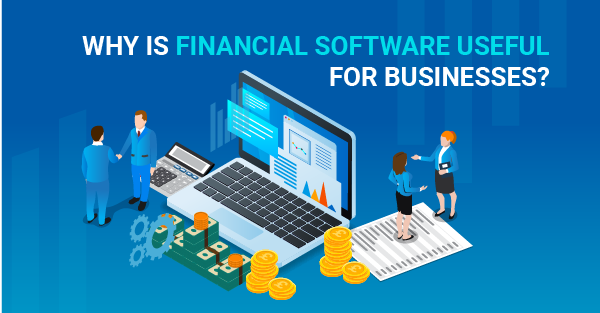
Financial software simplifies complex problems for individuals and businesses
Financial application development involves creating software that helps individuals or organizations manage, track, and analyze their finances. There are several reasons why it’s important:
- Audience: These applications serve different types of users like individuals, small businesses, large corporations, banks, or governments. Each group has unique needs, and financial apps offer tailored solutions.
- Process: Development includes planning, designing, coding, testing, deploying, and maintaining. Attention to detail, quality, and security is vital due to the sensitive data involved. Compliance with laws and regulations, like data protection and accounting standards, is necessary.
- Benefits: Financial apps improve efficiency, accuracy, security, and decision-making for users. They enhance user experience, satisfaction, and loyalty while boosting revenue and profitability.
In essence, financial application development is a crucial task demanding expertise, creativity, and innovation.
Types of financial software
There’s a variety of financial software available, offering businesses and individuals numerous choices. However, not all software enjoys widespread popularity. Let’s summarize and analyze some of the popular styles that garner high traffic and usage.
1. Accounting systems
Accounting systems are vital for effectively managing financial operations. They come in various forms, each tailored to specific business requirements:
- General Accounting Software: This software records and processes financial transactions such as invoices, payments, and expenses. It generates detailed reports and statements to evaluate a business’s financial status.
- Enterprise Resource Planning (ERP) Software: Financial planning software systems integrate different business functions like accounting, human resources, and inventory management. They offer a centralized platform to streamline operations and facilitate decision-making.
- Payroll Software: Designed to handle employee payroll, this software automates payroll processing, tracks work hours, and ensures compliance with tax regulations. ADP stands out as a notable example in this field.
- Billing and Invoicing Software: It will simplify the management of payable and receivable accounts by automating tasks and minimizing errors associated with manual data entry.
- Inventory Management Software: These systems help businesses monitor inventory levels, orders, and deliveries, optimizing stock control and cutting costs.
These software solutions cater to businesses of all sizes, enhancing efficiency, accuracy, and transparency in financial management.
2. Payments gateway
Payment gateways are crucial middlemen in online transactions, making it easy to process payments using credit and debit cards. They securely connect merchant and customer bank accounts, verifying banking and card details, ensuring enough funds, and transferring data between banks for safe transactions.
It’s impressive how payment gateways smoothly integrate with various software platforms for online payments, showing their flexibility. The global payment gateway market, valued at $32.52 billion in 2023, has grown steadily at a rate of 22.2%, highlighting their vital role in digital payment commerce.
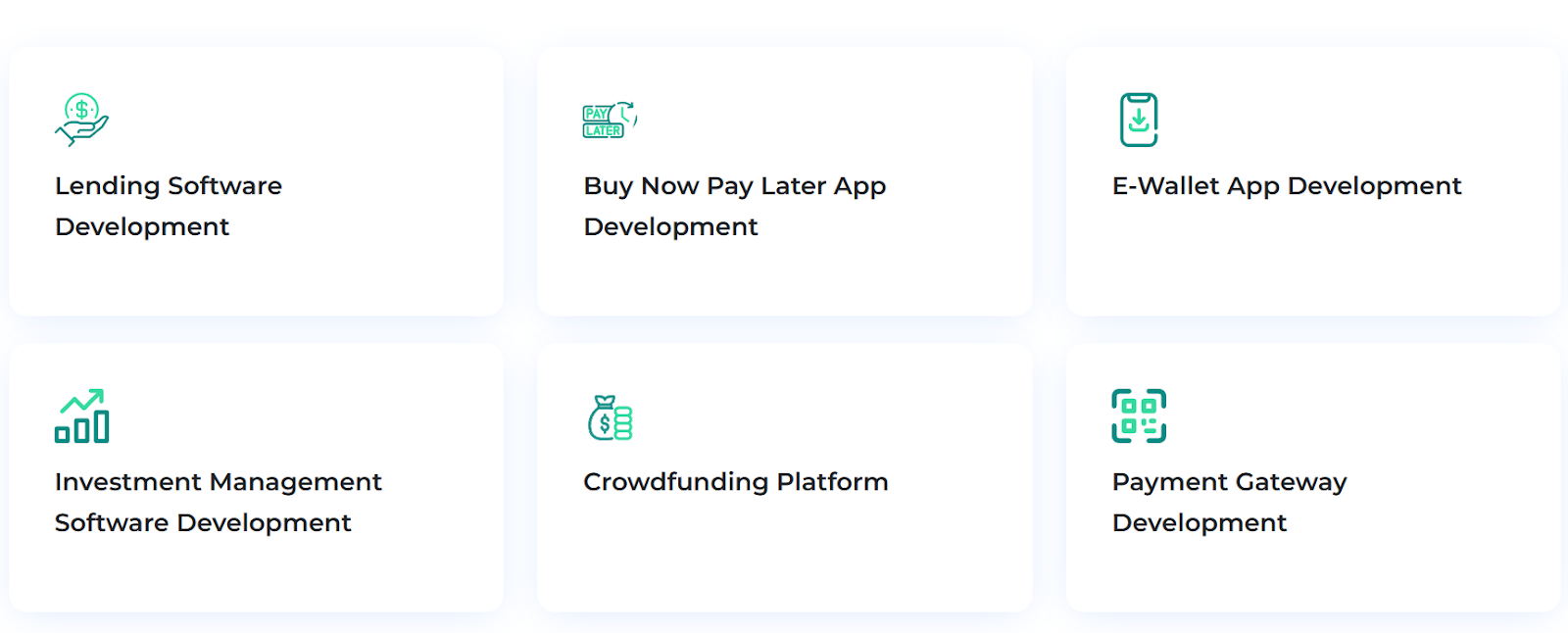
Savvycom, a trusted provider in designing and providing finance solutions
In addition, financial software development companies like Savvycom that offer financial software development services, lead the way in payment processing, using technology and adaptability to navigate the changing landscape of online business. The shift to online commerce due to the pandemic has pushed payment gateways even further into the spotlight of FinTech innovation, confirming their importance in modern financial systems.
3. Insurance
Insurance technology (InsureTech) is among the fastest-growing segments in financial applications, with an impressive Compound Annual Growth Rate (CAGR) of 34.4% and a projected value of $1.19 billion by 2027. The evolution of InsureTech has brought about a new wave of innovation, where data from wearables and similar devices play a crucial role in providing highly personalized services. This new generation of InsureTech platforms utilizes wearable data to offer dynamic insurance plans and personalized recommendations to customers.
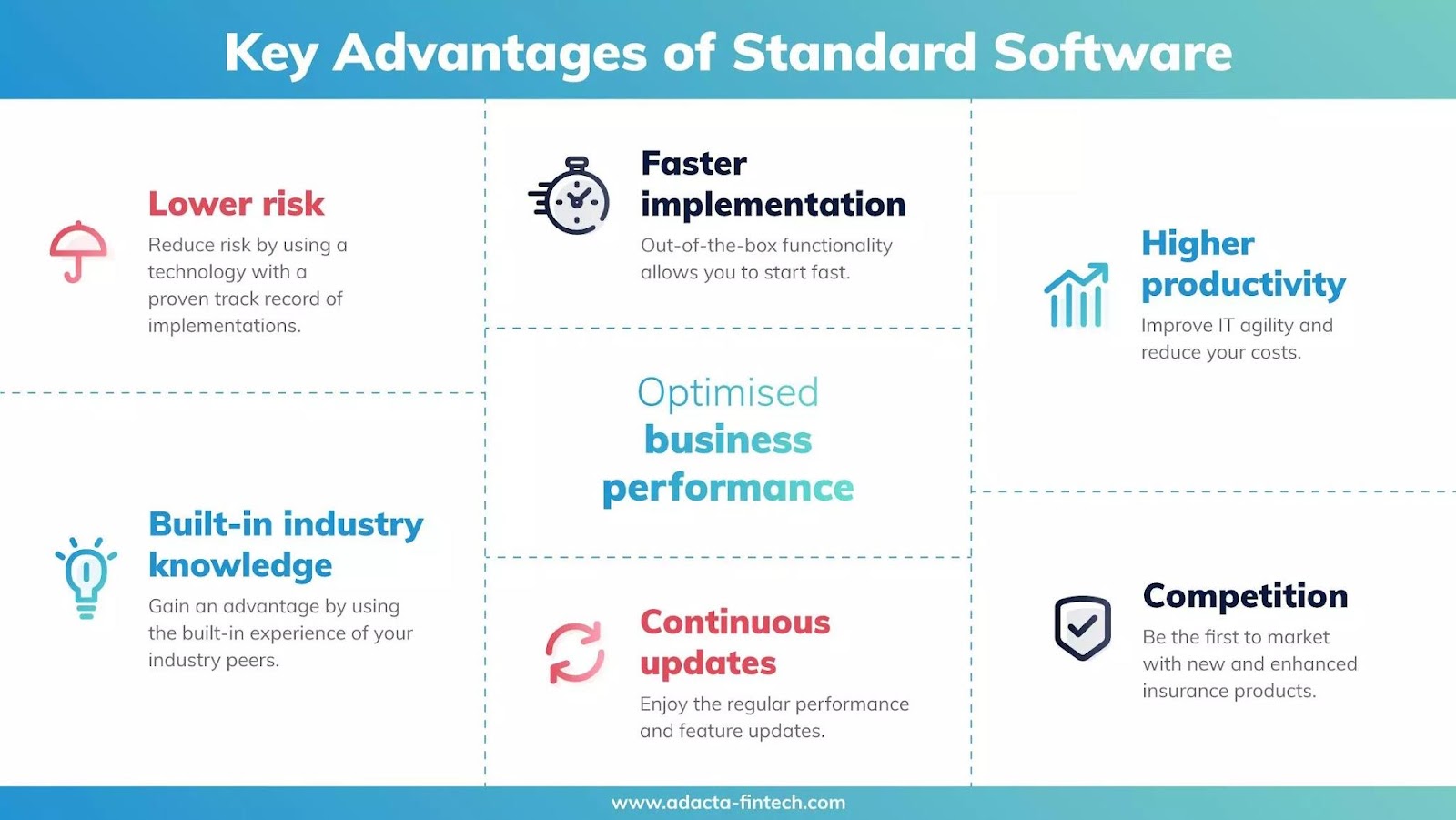
The insurance software market remains a valuable opportunity for businesses
Source: Adaca fintech
Interestingly, smaller insurance companies are embracing this trend, venturing into areas that larger peers traditionally avoided. In doing so, these smaller firms not only explore new opportunities but also reduce customer acquisition costs, thereby enhancing their competitiveness in the market.
4. P2P lending platforms
Peer-to-peer (P2P) lending platforms mark a significant shift in borrowing and lending, allowing individuals to borrow directly from others in a virtual marketplace. These platforms, driven by decentralization, connect borrowers with investors without traditional financial intermediaries. P2P lending platforms prioritize reducing operational costs, offering more attractive terms to investors than traditional banks.
According to Webisoft, the global P2P lending market is expected to reach $558.91 billion by 2027, with a growth rate of 29.7%, driven in part by pandemic-related challenges. As more companies adopt P2P lending, these platforms transform lending practices, making capital more accessible and promoting decentralized borrowing and lending.
Development cost?
Understanding the cost dynamics of financial software development involves considering various critical factors and estimation methodologies. The development cost is influenced by factors such as scope, complexity, technology stack, and human resources. These elements collectively determine the overall expenses of building software solutions.
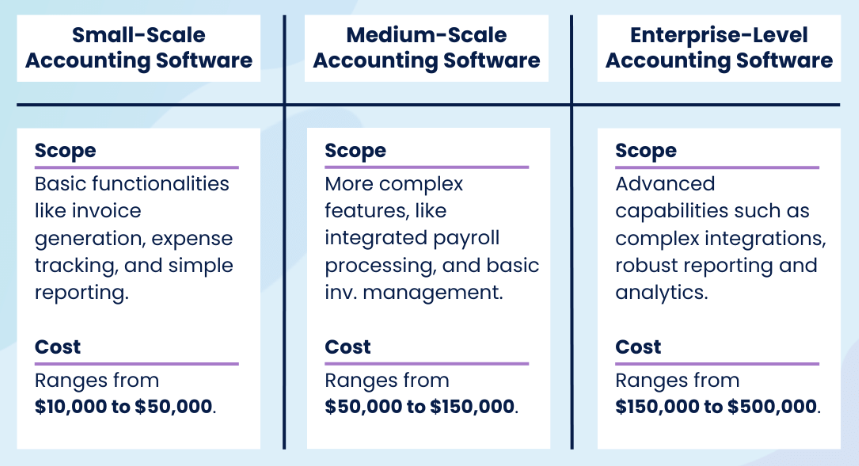
Latest price list on costs of building financial software
Estimating development costs entails analyzing project scope, complexity, and technology resources needed. Techniques like bottom-up estimation and analogous estimation help derive accurate cost projections. These methods take into account project size, duration, and required functionalities to establish a realistic budget framework.
For small-scale accounting software projects, costs typically range from $10,000 to $50,000, depending on project size and duration. Medium-scale projects may incur expenses ranging from $50,000 to $150.000, considering complexity and required features. Large-scale or enterprise-level accounting software development may involve significantly higher costs due to extensive integrations, scalability, and maintenance requirements.
How to build financial software?
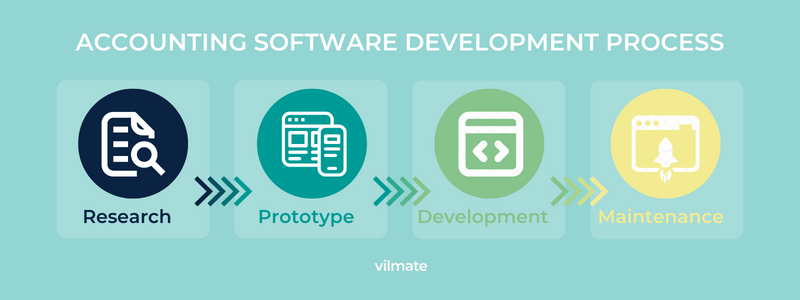
Quick steps to build financial software
Building financial software requires careful planning and execution to make sure it works well and is dependable. Here’s a clear plan to help you through the development process:
- Define Project Requirements: Start by understanding what your financial software needs to do. Think about things like managing accounts, processing transactions, generating reports, and keeping things secure.
- Market Research: Look closely at what users want, what your competitors are offering, and where the industry is heading. Find out what’s missing in current solutions so you can make your software fit the market better.
- Select Technology Stack: Choose the right tools and frameworks based on what your project needs and how big you expect it to get. Think about security, speed, and making sure it can grow with updates.
- Design Architecture: Create a strong plan for how everything in your software will fit together. Decide how data will be organized, what different parts of the system will do, and how new features can be added later on.
- Develop Core Features: Start building the most important parts first, like letting users log in, managing accounts, and handling transactions. Put the most useful things first, based on what users need and what’s standard in the industry.
- Implement Security Measures: Make sure your software keeps financial data safe from hackers and other threats. Use encryption, special logins, and check regularly to make sure everything stays secure.
- Test and Quality Assurance: Check your software thoroughly to find and fix any problems. Test how it works, how different parts fit together, and how secure it is to make sure users have a smooth experience.
- Deployment and Maintenance: Once your software is ready, launch it in a controlled way and keep an eye on how it performs. Keep updating and fixing it to make sure it keeps working well and meets users’ changing needs.
By following these steps, you can create financial software that’s reliable and meets the needs of users and the industry.
Conclusion
In summary, creating financial software is a strategic investment for organizations, enabling precise financial management and decision-making. The process, from planning to implementation, demands a focused approach to ensure that the software aligns with specific business needs and offers a secure, scalable, and efficient financial management solution. Ultimately, we hope the question “how to build financial software?” was clear for you.
Unlocking Digital Potential: Financial software, App Development, Cloud & DevOps Services and more! Since 2009, Savvycom has been at the forefront of leveraging digital technologies to empower businesses, mid and large enterprises, and startups across diverse industries. As a software development firm, let us guide you in crafting top-notch software solutions and products while offering an array of professional services tailored to your needs…
Savvycom is right where you need. Contact us now for further consultation:
- Phone: +84 24 3202 9222
- Hotline: +1 408 663 8600 (US); +612 8006 1349 (AUS); +84 32 675 2886 (VN)
- Email: contact@savvycomsoftware.com
Blockchain App Market Overview
Blockchain technology, a cornerstone of the Internet of Things (IoT), is revolutionizing industries worldwide with its decentralized ledger capabilities. From finance to healthcare, its applications offer transparency and heightened security, transforming how businesses operate. The blockchain app market is experiencing substantial growth, projected to reach $12.3 billion by 2030. This surge is propelled by the increasing adoption of cryptocurrencies and the integration of blockchain across diverse sectors such as retail and finance.
Emerging trends like DeFi (Decentralized Finance), NFTs (Non-Fungible Tokens), and enterprise adoption are reshaping the market landscape, paving the way for innovative solutions. Despite the evolving regulatory frameworks, which pose both challenges and opportunities for development and adoption, the blockchain market continues to expand. Successful ventures like Ethereum exemplify the immense potential of blockchain, contributing significantly to market growth.
With a remarkable Compound Annual Growth Rate (CAGR) of 57%, the future of blockchain technology is poised for robust expansion, promising sustained influence throughout the IoT ecosystem.
Looking For a Dedicated Team?
Looking to strengthen your manufacturing operations with state-of-the-art Blockchain technology? Look no further than Savvycom! With over 15 years of expertise in IT development, Savvycom specializes in providing customized Blockchain solutions to cater to the unique needs of your industry. Partner with us for expert Blockchain consulting, as Asia’s premier IT outsourcing company, and harness the power of innovative technology to streamline and secure your manufacturing processes. Let’s collaborate to enhance your operational efficiency and propel your business to new heights of success!
Criteria For Top 10 Blockchain App Developers
There are several factors that we have taken into consideration to compile this list. Some of these factors include:
- Experience: Prioritize firms with extensive experience, considering their tenure, successful projects, and client roster.
- Technical Expertise: Look for proficiency in various blockchain technologies like Hyperledger, Ethereum, and Solidity.
- Client Satisfaction: Value a strong reputation for client satisfaction, evidenced through positive feedback and testimonials.
- Product Quality: Emphasize commitment to delivering high-quality products, ensuring project success.
- Industry Recognition: Consider recognition, awards, and partnerships with leading companies as indicators of excellence and credibility.
- Team Size: Assess both larger teams for resource depth and smaller teams for personalized attention, based on project requirements.
- Flexibility: Prioritize firms that can adapt to changing project needs and timelines for successful project delivery.
- Cost-effectiveness: Evaluate competitive pricing while maintaining quality and adherence to timelines in the selection process.
The Top 10 Blockchain App Development Companies In Asia
With the amount of attention blockchain technology has been attracting, here is the list of the leading Blockchain app Development services you can work with.
1. Savvycom
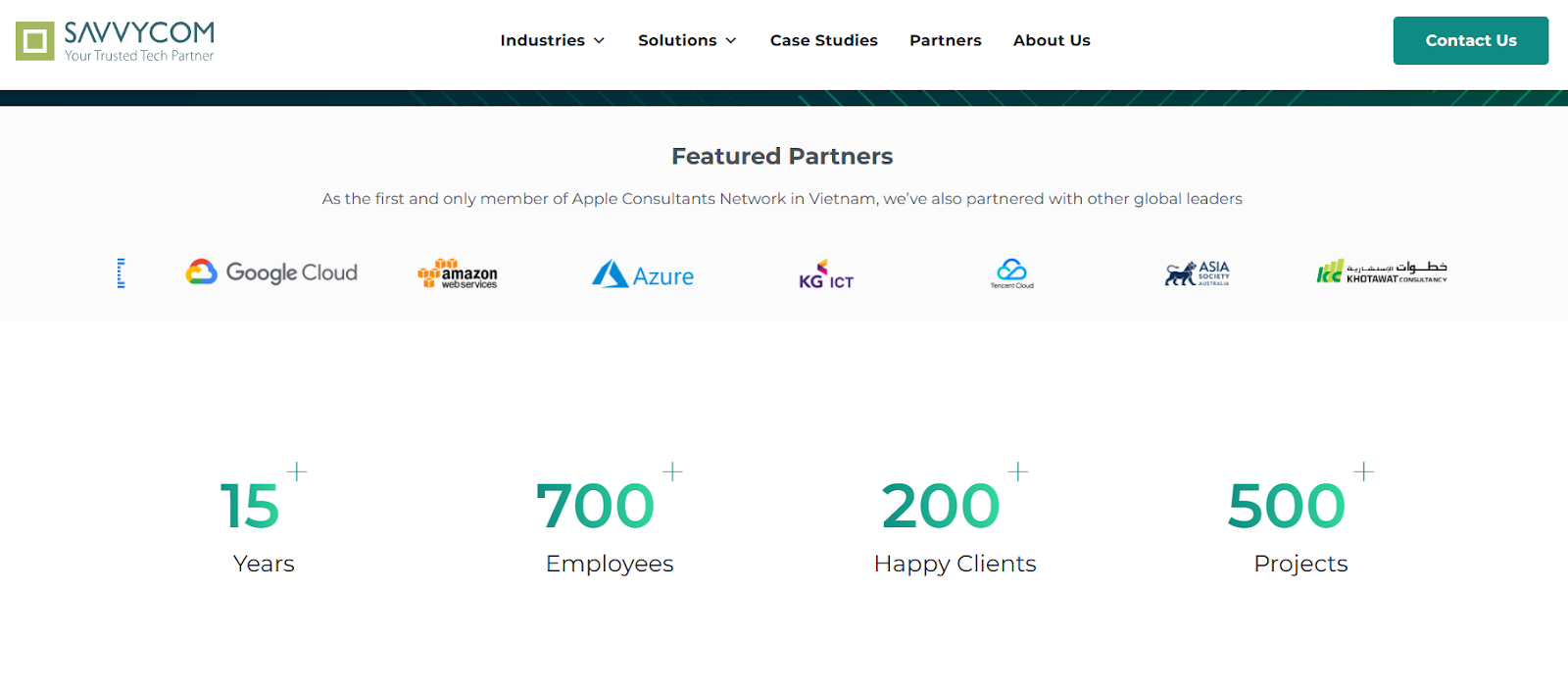
As the first and only member of the Apple Consultants Network in Vietnam, Savvycom has also partnered with other global leaders
The first on the top 10 list today is Savvycom, a leading custom blockchain app development firm in Vietnam that has established itself as an industry pioneer through a commitment to innovation and client satisfaction. With over 15 years of experience, Savvycom excels in providing tailored blockchain solutions for businesses of all sizes, leveraging expertise in platforms such as Hyperledger, EVM, Solidity, Cosmos, and Substrate. Their comprehensive services span consulting, design, and development, aimed at expediting time-to-market and optimizing ROI.
Highlighted projects, such as the collaboration with Morpheus Labs, underscore Savvycom’s prowess in executing successful blockchain initiatives, bolstering its credibility. Savvycom boasts a team of blockchain developers proficient in Ethereum, Tezos, and Hyperledger, having completed numerous 500 projects. Client testimonials further attest to Savvycom’s commitment to excellence.
Learn more about Savvycom
2. Creatix Technologies
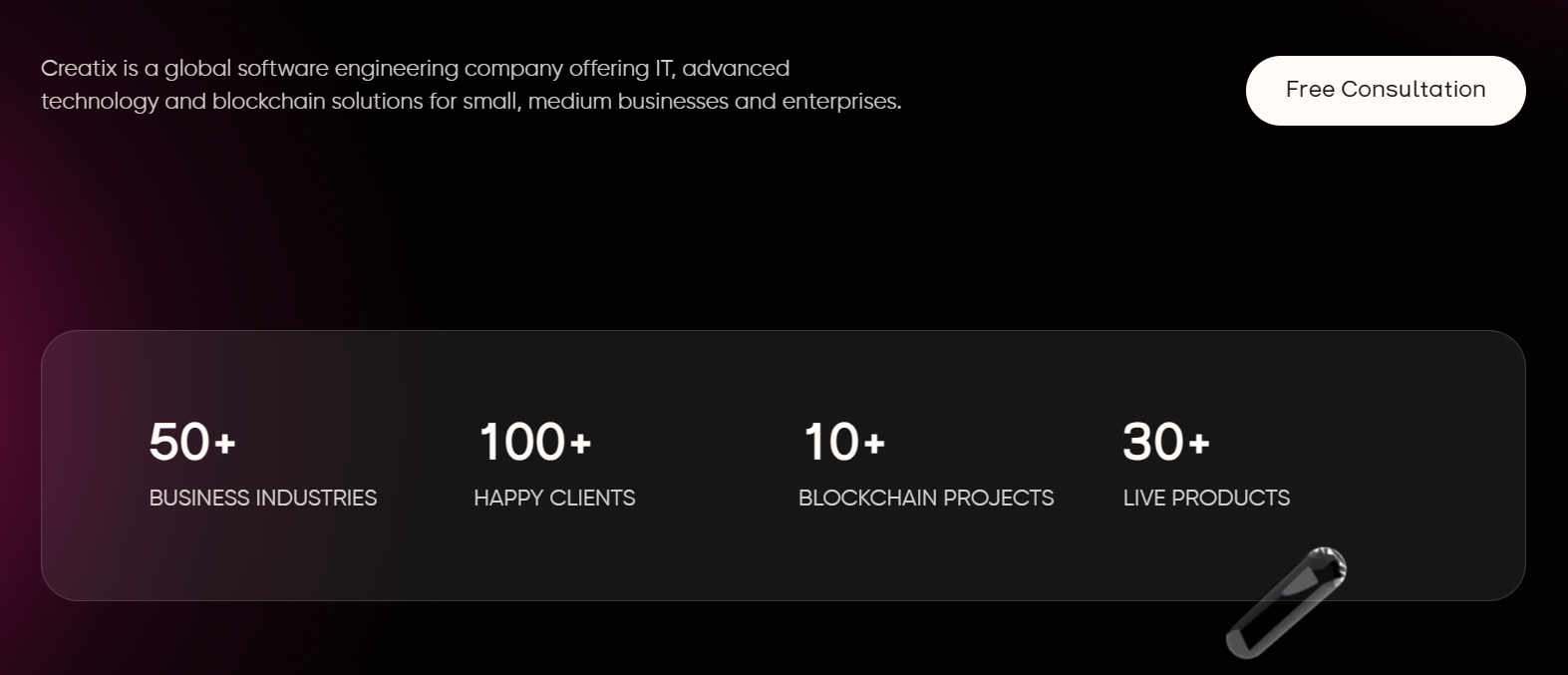
Creatix Technologies focused on helping businesses grow through digital transformation services
Creatix Technologies, headquartered in Armenia, is a leading company in blockchain consulting service, catering to various industries including finance, healthcare, and real estate. With a focus on creating custom blockchain solutions, Creatix adapts each project to meet the unique requirements of its clients, seamlessly integrating these solutions into existing business frameworks. The experienced team at Creatix is dedicated to delivering top-notch results, consistently surpassing client expectations.
By harnessing advanced technologies such as Ethereum, EOS, Solana, and NEAR, Creatix leads the way in innovative blockchain development, making complex concepts easy for businesses to navigate. Offering a full range of services from consultation to smart contract development and enterprise blockchain solutions, Creatix has a proven track record of successfully delivering projects that improve transparency, streamline processes, and generate tangible business value. With its impressive portfolio, Creatix Technologies is the preferred partner for startups and enterprises seeking cutting-edge blockchain solutions.
Learn more about Creatix Technologies
3. Appikr Labs
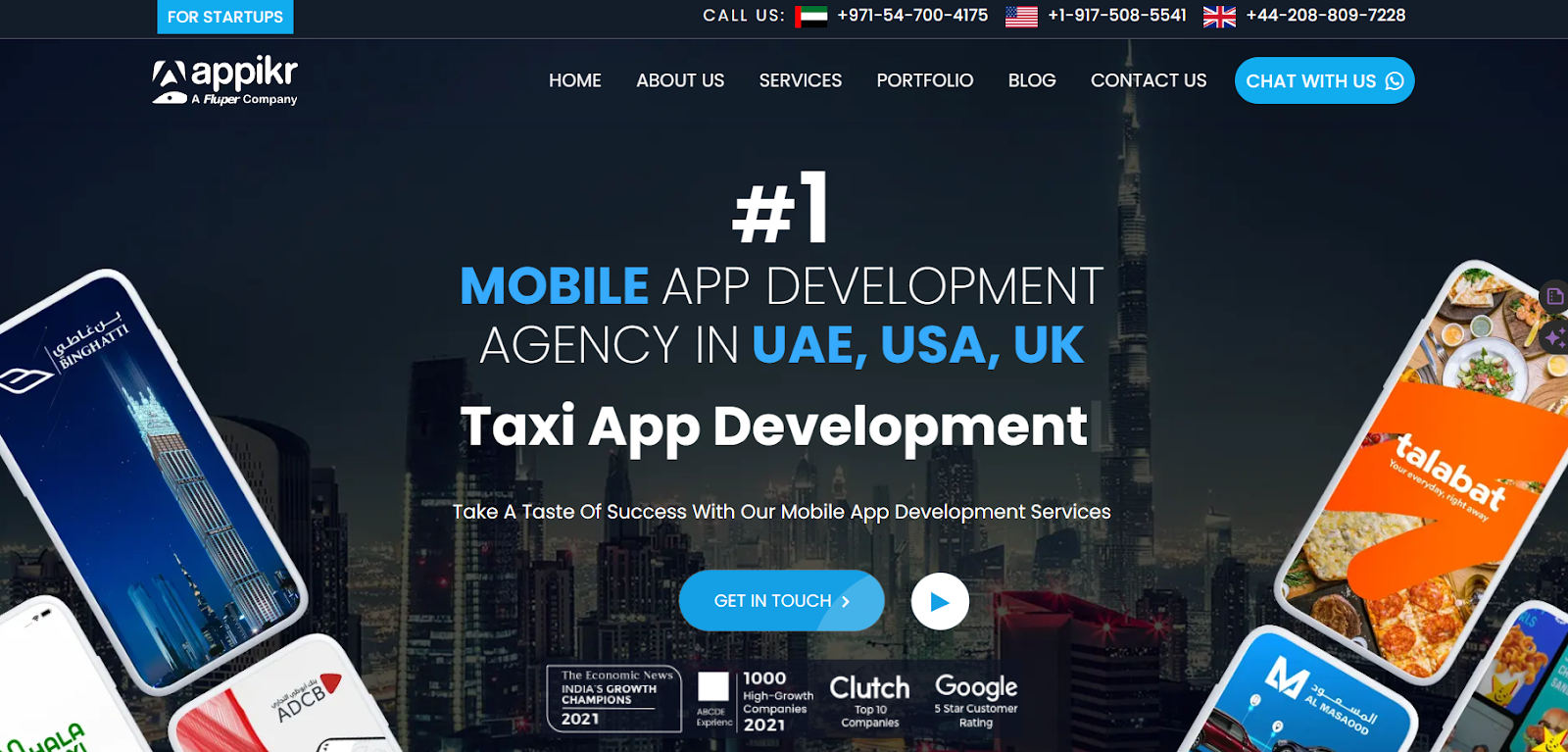
Appikr Labs Provides Mobile App Development Solutions For Brands And Companies With Objective To Generate Revenue In Billions Through “Fortune 500 Apps”
Appikr Labs, headquartered in Dubai, has been a leading figure in blockchain development services since its inception in 2015. They specialize in various areas including blockchain consulting, smart contract development, and decentralized application creation, serving industries such as finance, healthcare, and supply chain management. What sets Appikr Labs apart is its skilled team of experienced blockchain developers proficient in technologies like Ethereum, Hyperledger, and Corda. They have a notable track record of delivering innovative solutions like a voting system and a secure property title management platform for the real estate sector.
One of the key strengths of Appikr Labs is their ability to simplify complex blockchain concepts and transform them into easy-to-use applications. This has made them a preferred choice for both startups and established enterprises. With a commitment to delivering high-quality solutions that surpass client expectations, Appikr Labs continues to lead the way in blockchain innovation. Additionally, they offer educational services to help businesses harness the transformative potential of blockchain technology.
Learn more about Appikr Labs
4. Labrys
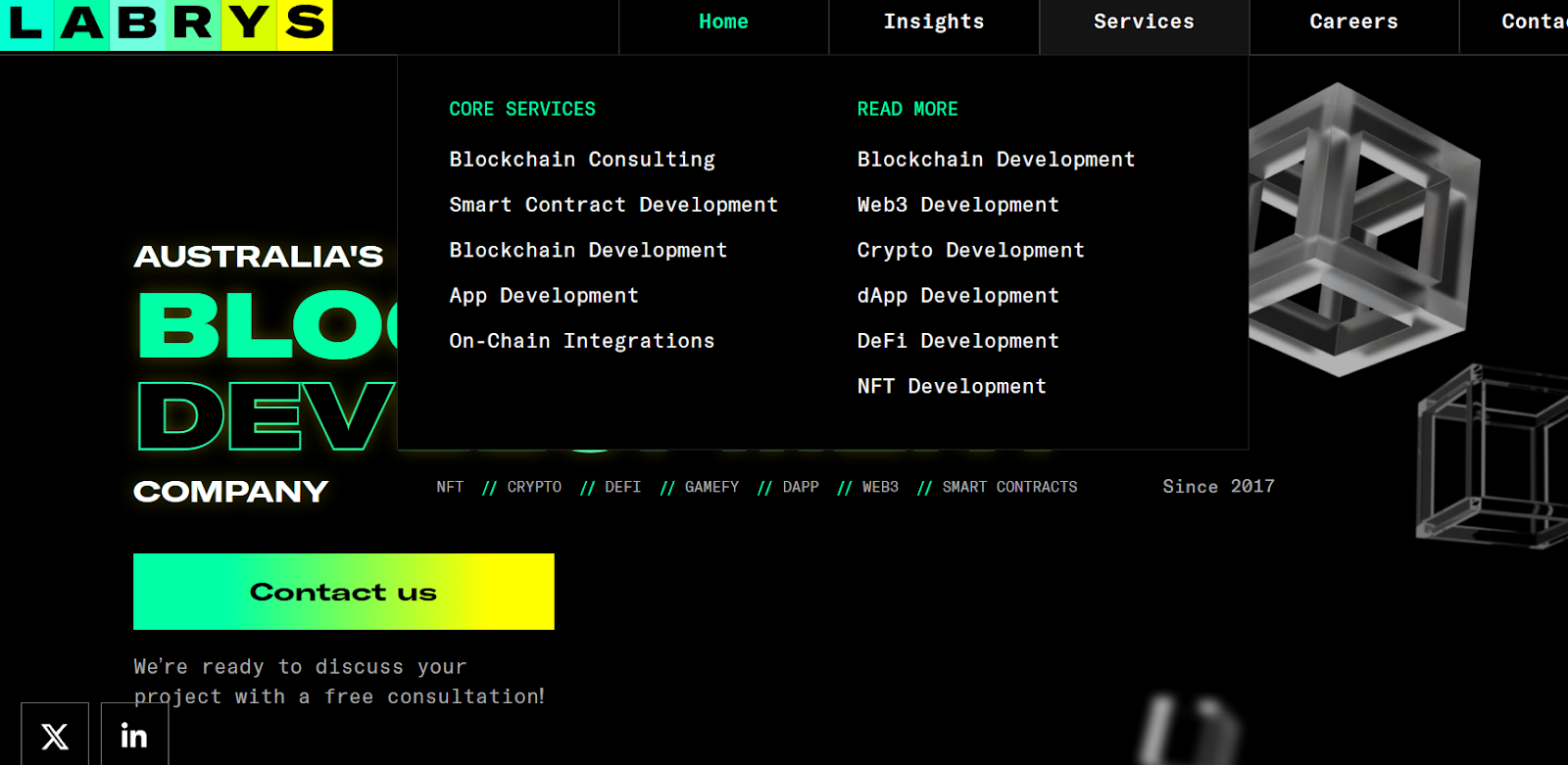
Blockchain services that Labrys provides
Labrys is Australia’s top spot for cutting-edge Web3 solutions. Since 2017, Labrys has quickly become the largest Web3 development agency in the country. They specialize in using blockchain infrastructure and Web3 technologies to create innovative products. Labrys takes a comprehensive approach, not only developing groundbreaking solutions but also building the necessary supporting infrastructure like web and mobile applications, APIs, and integrations to support any Web3 project.
What sets Labrys apart is its team of experienced blockchain developers and consultants. They’re experts in Ethereum, Hyperledger, Corda, and more. But Labrys isn’t just about delivering solutions; it’s also about educating and empowering businesses. Through their blockchain education services, Labrys helps organizations in various industries understand how to leverage blockchain’s potential, keeping them ahead in today’s digital world.
Learn more about Labrys
5. Sotatek
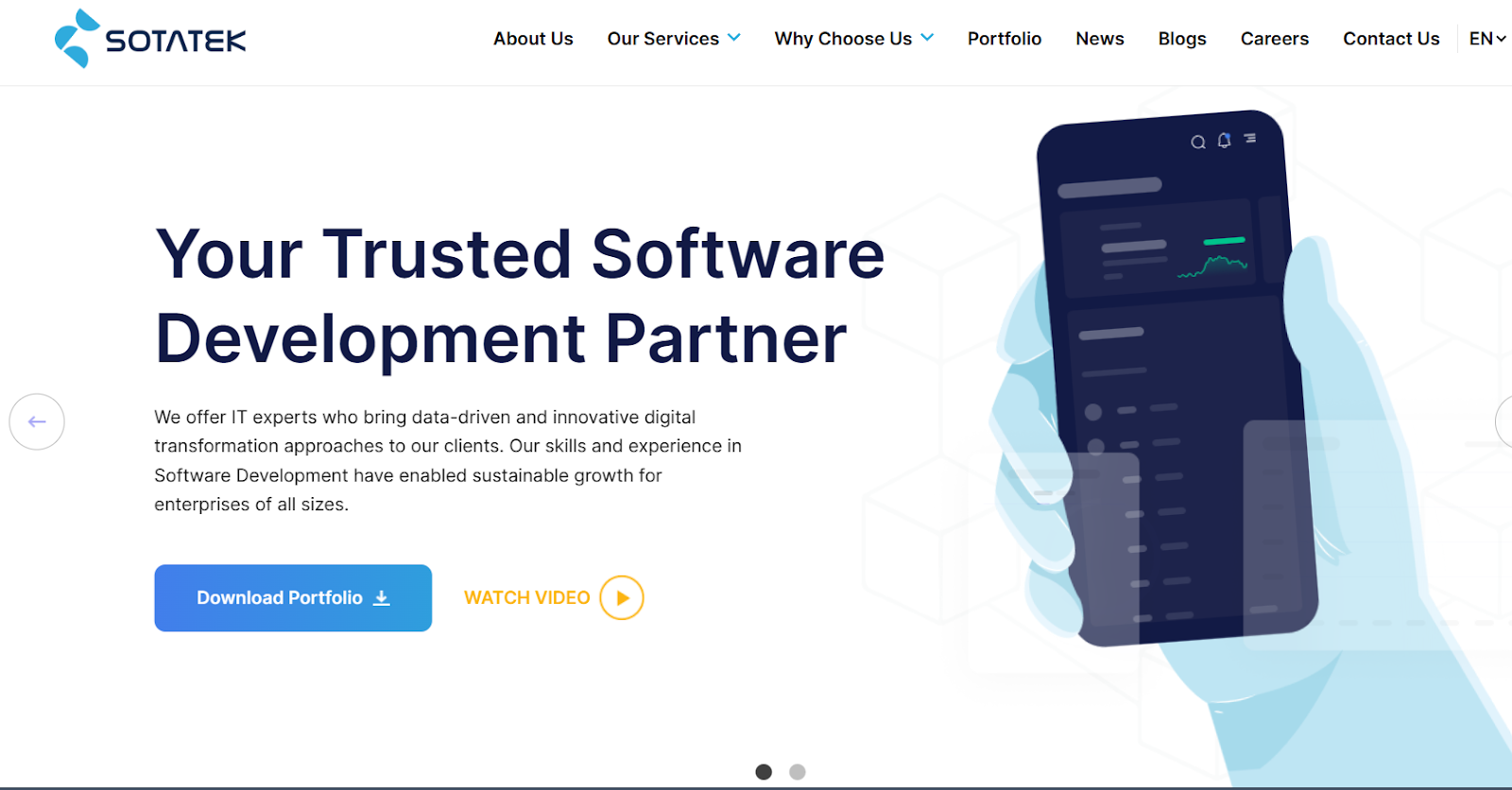
Embrace innovation, empower possibilities
SotaTek is a leading name in Blockchain Development and IT Consulting, with a global presence spanning seven offices worldwide and a strong team of over 500 skilled blockchain developers and consultants. Known for their versatile expertise, SotaTek offers a wide range of services, from full-stack public blockchain development to the creation of state-of-the-art NFT marketplaces, dex platforms, blockchain-based games, and essential infrastructure such as E-wallets and POS systems.
Their commitment to innovation and excellence shines through in their dynamic approach to crafting solutions tailored to various business needs. With a proven track record in payment processing, digital identity verification, and document management, SotaTek stands out as a leader in the Vietnamese blockchain development scene. They consistently set high standards for the industry and prioritize client satisfaction above all else.
Learn more about SotaTek
6. Cubix
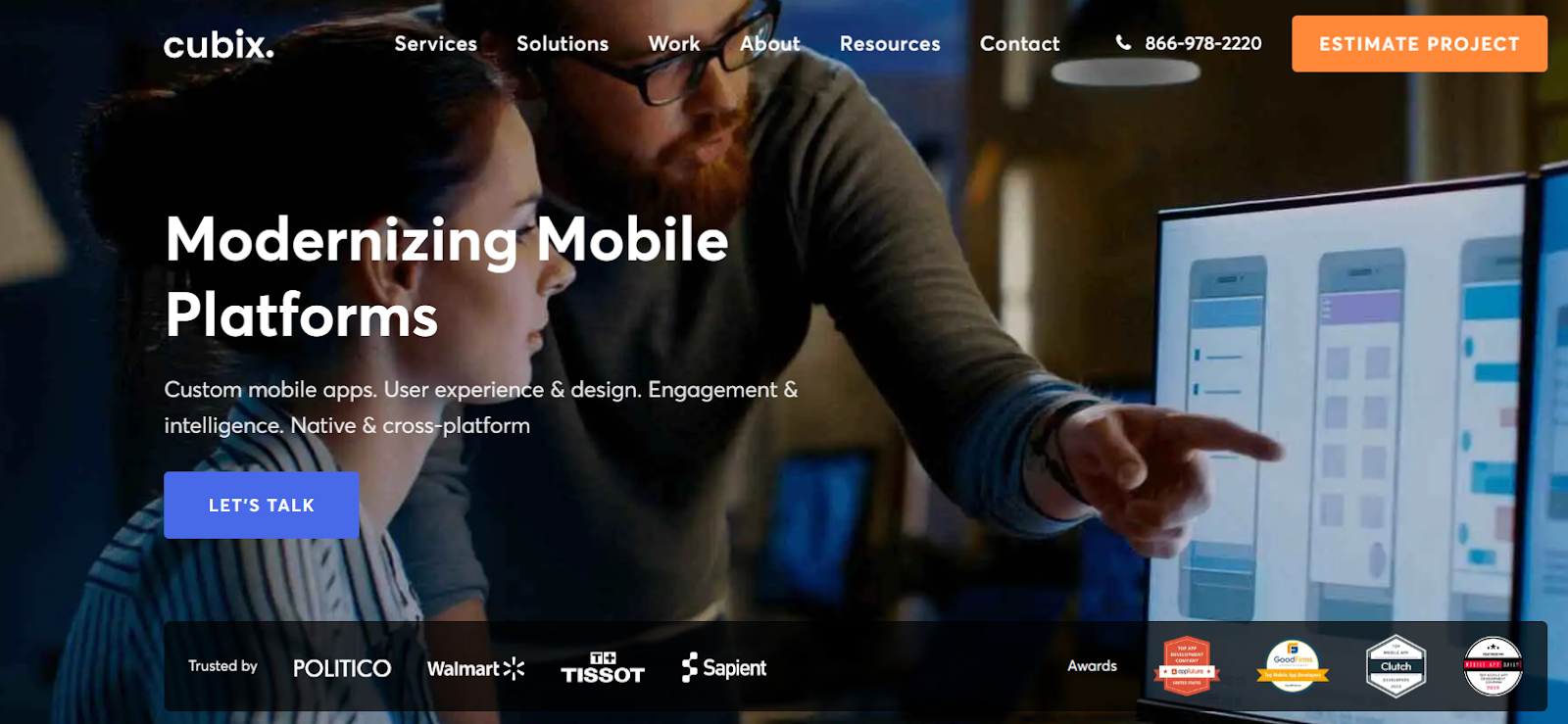
Unleashing the potential of blockchain, one block at a time
Cubix, based in Singapore, is a leading blockchain development company that’s making waves globally. With a team of over 250 experts, they’re delivering tailored and robust blockchain solutions to businesses in more than 50 countries. They specialize in key areas like blockchain supply chain, decentralization, and E-wallet platforms, drawing on their extensive experience to meet the unique needs of clients worldwide.
Having completed over 200 successful projects, Cubix has built a solid reputation for providing top-notch, dependable solutions in blockchain development, smart contract implementation, decentralized applications, and digital tokenization. Their commitment to excellence and innovation is evident, driving progress in the industry and helping businesses thrive in the digital.
Learn more about SotaTek
7. T-Mining

Empowering the digital future of logistics
T-Mining, a leading blockchain company based in Singapore, has been reshaping the digital world since its establishment in 2016. Focused on decentralized technologies, T-Mining has introduced its innovative Decentralized Technologies Framework (DTF). This framework aims to speed up the creation of decentralized applications (dApps) while keeping costs in check.
By utilizing reusable features, DTF makes it easy and quick to develop dApps, especially for supply chain purposes like Maritime, Port, and Logistics sectors. T-Mining is well-known for its expertise in building advanced trading systems and financial software, earning recognition in the financial industry. Collaborating with esteemed financial institutions, T-Mining excels in smart contract development, integrating blockchain technology, and tailoring blockchain solutions to specific needs.
Their proficiency extends across various blockchain platforms such as Ethereum, Bitcoin, and Hyperledger Fabric, solidifying their position as pioneers in blockchain innovation.
Learn more about T-Mining
8. Tradeline
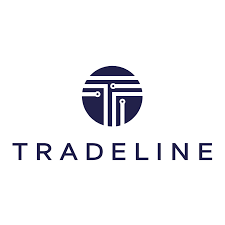
Transforming transactions, empowering trust through blockchain innovation
Tradeline is shaking up commodity trading with its innovative platform for automating post-trade workflows. Positioned at the forefront of this sector, Tradeline leads the pack with its cutting-edge technology, which not only streamlines communication and transparency within organizations but also ensures robust management of electronic contracts.
Drawing on its expertise as a blockchain development company, Tradeline delivers top-tier solutions tailored to diverse sectors, ranging from finance to supply chain management. Their seasoned team specializes in crafting blockchain-based solutions that place utmost importance on trust, transparency, and security.
By harnessing distributed ledger technology, Tradeline empowers businesses to streamline operations, slash costs, and bolster security measures. From initial consultation to full-scale implementation, Tradeline caters to businesses of all sizes, forming partnerships with industry titans like Visa and Nasdaq.
Learn more about Tradeline
9. Appsynth

Crafting digital experiences that transform businesses
Appsynth, a leading player in the blockchain arena across Thailand and Asia, is dedicated to pushing the boundaries of Distributed Ledger technology. With a fervent commitment to continual growth and innovation, the team focuses on unlocking the full potential of blockchain advancements.
Despite being headquartered in Bangkok, Thailand, expertise extends globally, offering tailored solutions for blockchain development. Specializing in Ethereum, EOS, and Hyperledger Fabric, a spectrum of services is delivered ranging from comprehensive consulting to end-to-end product development. From strategizing and feasibility studies to seamless integration planning, solutions prioritize security, scalability, and future-readiness. Beyond blockchain, proficiency extends to web and mobile app development, ensuring every client’s unique requirements are met.
At Appsynth, the mission is clear: to deliver unparalleled service and project management, empowering businesses to thrive in the ever-evolving digital landscape.
Learn more about Appsynth
10. Finwin Technologies

Empowering Financial Transformation
Finwin Technologies is a leading force in digital platform engineering and software development, offering top-notch IT solutions designed to adapt to the changing needs of businesses worldwide. Specializing in Fintech and AI, we help enterprises achieve rapid and cost-efficient growth. Renowned for our expertise in blockchain, we provide cutting-edge decentralized solutions such as cryptocurrency development, dApp creation, and ICO consulting.
Additionally, we excel in mobile app, AR/VR, and AI/ML development, showcasing our versatility across various industries. With a strong reputation for client satisfaction and proven success in healthcare, finance, logistics, and real estate, we are recognized for our excellence in IT innovation. Our commitment to delivering high-quality solutions has established us as a premier blockchain development company in Thailand.
Learn more about Finwin Technologies
Vietnam: A Rising Hub for Blockchain Outsourcing Endeavors
Vietnam is becoming a top choice for blockchain outsourcing, thanks to its skilled workforce, cost-effectiveness, and supportive government. With nearly 70% of its population under 35 and proficient in cutting-edge technologies like blockchain, Vietnam offers a rich talent pool. Its strong technology education system churns out over 600,000 IT engineers yearly, well-versed in coding and possessing good English skills.
Moreover, the government actively promotes entrepreneurship and digital transformation, boosting Vietnam’s appeal as a global tech hub. Thus, Savvycom, a prominent enterprise blockchain app development company with over 15 years of experience and more than 500 projects completed, offers top-notch blockchain solutions for businesses of all sizes.
Collaborating with firms like Savvycom ensures innovative and successful outcomes as Vietnam solidifies its position in the blockchain industry.
Conclusion
In Asia, the blockchain app development companies thrives with talent and innovation. The listed companies are top players in the industry, each offering distinct strengths. As blockchain tech progresses, these firms are poised to pioneer solutions that are both cutting-edge and practical. Whether you’re a startup or a big business, teaming up with these developers can unleash blockchain’s potential to revolutionize your operations.
Savvycom – Your Trusted Tech Partner!
Transforming Manufacturing with Cutting-Edge Blockchain Solutions with Savvycom, Asia’s Premier software development company, has been leading digital innovation since 2009. Drawing on our extensive experience, we specialize in developing cutting-edge Blockchain solutions customized to your requirements. Whether it’s supply chain optimization, smart contracts, or decentralized applications, we offer comprehensive solutions to revolutionize manufacturing processes. Partner with us to harness the power of Blockchain technology and drive innovation in your industry.
Savvycom is right where you need. Contact us now for further consultation:
- Phone: +84 24 3202 9222
- Hotline: +84 352 287 866 (VN)
- Email: contact@savvycomsoftware.com
Frequently Asked Questions
Which company is best for blockchain development?
Looking for top-notch companies in blockchain development? Here are some renowned names:
-
ConsenSys: Leading the pack with its expertise in Ethereum-based solutions and decentralized applications (dApps).
-
IBM: Known for its IBM Blockchain platform, catering to high-level blockchain applications for businesses.
-
Deloitte: Offers consulting and development services across various industries, providing tailored blockchain solutions.
-
Microsoft: With Azure Blockchain Services, it equips developers with tools and infrastructure on the Microsoft Azure cloud platform.
-
Chainyard: Specializes in offering comprehensive blockchain services, from consultation to implementation, specifically tailored for enterprises.
-
Accenture: Delivers blockchain solutions across different sectors like supply chain, finance, and healthcare, ensuring industry-specific needs are met.
-
Coinbase: Famous for its cryptocurrency exchange platform, it also extends its expertise to blockchain development services and developer tools.
Remember, before making a choice, ensure to thoroughly research each company’s track record, experience, and previous projects to find the best fit for your specific blockchain development needs.
This hype train was originally created by Bitcoin – the most famous application of Blockchain in cryptocurrency. Now, most leaders believe that Blockchain will be the most influential force in the transformation of industries practice as we know it. In fact, at the 2016 MedCity Converge conference, Nishan Kulatilaka – Merck associate director for applied technology, noted:
Blockchain In Healthcare
“Healthcare could be the second-largest sector to adopt the Blockchain technology, after financial services.”
Undoubtedly, positioning your business as the frontrunner in adopting the next major technological breakthrough promises to secure a significant share of the market and generate profits.
However, Blockchain remains an emerging technology with no predetermined formula for success. Therefore, engaging in haphazard experiments with Blockchain solutions lacking clear objectives and a feasibility assessment process is unlikely to yield substantial returns for your company.
In this piece, Savvycom Insight aims to assist you in comprehending: What exactly is Blockchain? How will its implementation unfold in the Healthcare industry? What obstacles should you anticipate? And if you opt to confront these challenges, what strategic approaches can you employ? This insight is particularly relevant for software development companies seeking to navigate the complexities of Blockchain integration.
1. Understanding Blockchain
1.1. The general definition:
Many of us know about ‘blockchain’ as this magical data storing mechanism where nothing can be lost, nothing can be hacked, and nothing can be wrong.
Well, we are close. Just not there yet.
So, what is Blockchain? Technically speaking, Blockchain is ‘a database, shared across a public or private computing network’. But simplistically speaking, imagen a series of blocks that link together in a chain. The chain is the network. Each block stands for a computer in that network. They also have ‘hash’ – their digital fingerprint. Every data transfer from one block to another is attached with the hash of the sender.
Now, the main thing that differencing Blockchain from a traditional database is the set of rules applied in the process of putting data into the database. Every piece of information, once uploaded, will be validated by a list of consensus protocol. Then, it will be mathematically encrypted, attached with the hash and added as a new ‘block’ to the ‘chain’. This creates a continuous chronical record and hence, displays the selling points of Blockchain.
First, the new data cannot be in conflict with another existing data in the historical record. Secondary, data can only be added, not remove or change. Thirdly, the data is attached with a hash – which always points to the owner and past owners in the chain. And lastly, it is decentralized. No single authority will be able to take away an asset and change “history” to suit their need. That is unless an authority can control 50% of the network-computing power and rewrite all previous transactions.
1.2. Types of Blockchain:
There are four types of Blockchain, divided by 4 blockchain – architecture options: Private vs Public; Permissionless vs Permissioned. Generally speaking, the Permissioned-Private option carries the highest possibility to be commercialized due to its nature of high security and lower capital investment.
2. Applications of Blockchain in Healthcare:
2.1 The opportunities:
Base on the advantages mentioned, Blockchain should not be applied only in cryptocurrency. This technology now has great powers and therefore, great responsibilities in the development of modern civilization.
According to McKinsey, in a bird-eye view, Blockchain can help in 2 manners:
a) Record keeping: Storage of static information
b) Transaction: Registry of tradeable information
In application to the healthcare industry, Blockchain can either revolutionize or at least improve the ways things are being handled, which in turns creates substantial values for both the business and the people.
We have come up with several examples for the potential application of Blockchain in Healthcare:
-
-
- Electronic health record: One’s electronic health record contained not only the health-related data but also citizen ID, personal description, and payment address. Hence, it is an ideal target for identity theft. In fact, just 4 days ago, 1.5 million health records of the Singapore citizens got hacked and stolen – including Prime Minister Lee Hsien Loong.
To prevent this situation, Blockchain in healthcare can monitor the accounts that gain access to the data in real time, making sure that every suspicious action is noticed and alarmed as soon as possible. In addition, blockchain can also give patients the ability to set different privacy settings on their medical information by breaking down records into components and granting access piece by piece. This will help to reduce the risk of over-privileging any potential recipient and enhance administrative efficiency. - Healthcare research: While most Blockchain in healthcare is safer to be built on a private server for the sake of security, healthcare research is likely to yield a higher level of social value with the public server. On one hand, using Blockchain, a clinical trial researcher or investigator could search candidates based on specific genetic, demographic, and geographic criteria without even knowing the patient’s name. On the other, by applying the rules of smart contract, patients could even charge pharmaceutical companies to access or use their data in drug research.
- Health Tracking: When combining Blockchain technology with IoT and medical devices, information about the wearer could be stored in a shared ledger accessible by other systems to automate maintenance and management of the wearer’s information. This is practically useful for people with chronic illness on are under end-of-life care.
- Payments infrastructure: The current payment infrastructure is mostly based on relies on file exchange between multiple parties which lead to a longer time to process and larger probability for error. With the power of blockchain, all parties in a financial trade can be connected – allowing faster processing while still ensure the audit trail. It is also impossible to manipulate data, hence limit security breach. Buyers of pharmaceutical will no longer need to depend on bank statements to reconcile their accounting ledgers.
- Drug supply chain: There is in-built vulnerabilities in the drug supply chain at many points on their way to patients, and pharma manufacturers and other stakeholders have little visibility to track the authenticity of products. Blockchain could provide significant benefits here, with barcode-tagged drugs scanned and entered into secure digital blocks whenever they change hands. This ongoing real-time record could be viewed anytime by authorized parties and even patients at the far end of the supply chain. Blockchain in healthcare can also be combined with IoT sensors to ensure the integrity of the cold chain for drugs, blood, and organs.
- Healthcare insurance: The healthcare insurance industry suffers from some major bad reputations, with one of the most prominent complain lies around insurance claims stagnant. With blockchain, organizations can speed up this process by having records posted to a private blockchain, reducing the need for transmitting the data from one host to another.
- Electronic health record: One’s electronic health record contained not only the health-related data but also citizen ID, personal description, and payment address. Hence, it is an ideal target for identity theft. In fact, just 4 days ago, 1.5 million health records of the Singapore citizens got hacked and stolen – including Prime Minister Lee Hsien Loong.
-
2.2 The difficulties:
The organization leaders always need to be a rational dreamer. So, as we have presented the good side of Blockchain in healthcare, here is the not-so-fun side: Blockchain is still more than five years away from feasibility at scale. Here’s why:
Based on the McKinsey’s model, there are four key factors that determine the level of the feasibility of Blockchain in Healthcare: asset, technology, the standard of regulations, and the ecosystem. Applying this 4 factors in the Healthcare industry for evaluation:
-
-
- Asset – Medium feasibility: Asset type determines the feasibility of improving record keeping or transacting via blockchain. Most will need to be digitization. With assets like healthcare record, which are digitally recorded and exchanged healthcare enterprises, can be simply managed end to end on a blockchain system. However, connecting and securing physical goods to a blockchain – for example, at-home health tracking devices – requires enabling technologies like IoT and biometrics. This connection can be a vulnerability in the security because while the blockchain record might be immutable, the physical item or IoT sensor can still be tampered with.
- Technology – Low feasibility: The immaturity of blockchain technology is a limitation to its current viability across any industries. Applying this kind of technology definitely demands a strong series of computer, high 24/7 energy consumption and fast connection speed. With healthcare enterprise which tends to run on an “off chain” database, the switching costs are high. In fact, most cost benefits will not be realized until old systems are decommissioned. Organizations also need a trusted solution provider. Currently, few start-ups have sufficient credibility and technology stability for government or industry deployment at scale.
- Standard of regulations – Low feasibility: The lack of common standards and clear regulations is a major limitation on blockchain applications. With healthcare, since medical data is a sensitive information with a high level of concern, regulations are of course stricter than most industries. For example, in the United States of America, HIPAA rules have multiple subchapters and healthcare entities are going to have to master them all for blockchain.
- The co-opetition paradox – Low feasibility: Blockchain’s biggest advantage lies in the network effect, but that advantages will be limited by the coordination complexity. To apply Blockchain in Healthcare, natural competitors need to cooperate, making sure that their data is correct, transferable and adaptable to the others system. The issue is agreeing on the governance decisions. Overcoming this issue often requires a credible sponsor, such as a regulator or industry body, to take the lead.
-
3. Pieces of Advice with Blockchain in Healthcare
To sum up. there are a plethora of use cases for Blockchain in healthcare, so, companies will definitely face some difficult tasks when deciding which opportunities to pursue. We want to help, and therefore, would love to provide you with a very general but useful step-by-step process:
Step 1: Investigating the true “pain points” — the frictions for customer experiences that blockchain could eliminate.
Step 2: Extensively analyzing the potential commercial value within the constraints of the overall feasibility of the blockchain solution. Considering the overall industry characteristics and regulation as well as a company’s expertise and capabilities.
Step 3: Brainstorming the company’s optimal strategic approach to Blockchain. This step will fundamentally be defined by two market factors:
1. Market dominance – the ability of a player to influence the key parties of a use case.
2. Standardization and regulatory barriers – the requirement for regulatory approvals or coordination on standards.
____
Savvycom has been a long time friend of the healthcare industry, considered our contribution in many projects such as Jio Health and Eva Diary. Recently, we also played a part in the creation of Consentium – the first blockchain-based crypto wallet and community app that reward for user engagement.
Now, our talented developers are looking for a chance to combine our knowledge in the healthcare applications and Blockchain technology to support SME that are particularly interested in being one of the pioneers in this industry revolutionary movement.
Savvycom – Your Trusted Tech Partner!
Leveraging over 25 years of expertise, Savvycom has utilized digital technology to facilitate the growth of businesses spanning diverse industries. Our offerings range from top-notch technology consulting and comprehensive product development to software development consultancy, all aimed at optimizing your business potential. This underscores our commitment to delivering exceptional software outsourcing services tailored to your needs.
Savvycom is what you need. Contact us now for more consultation:
- Phone: +84 24 3202 9222
- Hotline: +84 352 287 866 (VN)
- Email: contact@savvycomsoftware.com
Nowadays, with just a tap of your finger in mobile banking software, you can make your life a lot easier. In this article, we will guide you through Mobile Banking Application Development. Everything that you need to know before starting your project in a Mobile Banking App.
1. What Is A Banking App?
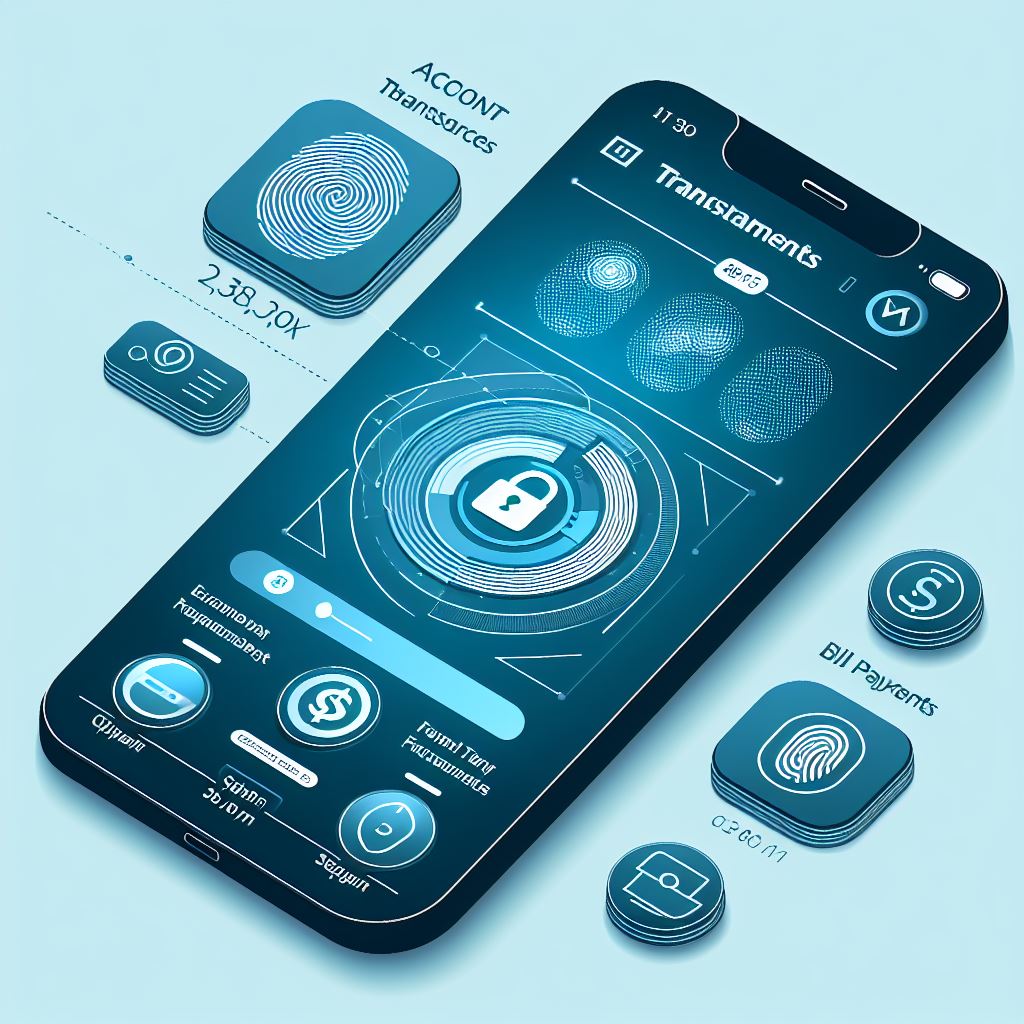
A banking app is a mobile app where you can access your bank account’s details and complete transactions directly from your phone, tablet, or mobile device. Based on the bank you’re accessing, you’ll be able to complete a variety of actions via your banking app.
Most banking apps allow you to view your current balance and transaction history; deposit checks up to a specific dollar value. Another thing you can do is to initiate transfers to other bank accounts, schedule payments or pay your bills, send person-to-person payments, and locate ATMs that are free for you to use.
Learn More On: The Essential Guide To Software Development Services
2. Why You Should Build A Mobile Banking App?
Imagine that almost one-third (32%) of the global population utilizes mobile banking software. Mobile Banking App is something that you cannot miss on your phone and here are the reason why:
-
- In January 2023, mobile devices excluding tablets accounted for nearly 57% of web page views worldwide. – Statista
- The worldwide number of mobile internet users is expected to rise by 908.4 million (+17.4%) between 2023 and 2028. – Statista
- 6 out of 10 mobile users prefer mobile apps over mobile websites and other platforms for account management. – Thinkwithgoogle
- According to latest research, 90% of individuals use mobile banking apps to check their account balance, and 79% use mobile banking apps to monitor recent transactions. – Statista
3. Benefits & Advantages of Mobile Banking Application Development
The benefits of banking app development are mutual:
- Customers benefit from such applications since they provide ease, simple access to a bank account, security, and a slew of other valuable features, which we’ll go over next.
- Having a mobile app means lower staff costs, lower operational costs, and even going paperless, which is more environmentally friendly.
Let’s take a deeper look at the top business perks.
Reduced expenses
Banks save a lot of money by using mobile apps. Here’s how it’s done:
- Expand your coverage. Your company is not bound by branches, regional centers, and so forth.
- Handle heavy workloads. Requests cannot be processed 24 hours a day, seven days a week. They eventually weary and make mistakes, but automation does not have this problem.
- Increased precision. Human mistakes and operational risks are decreasing.
- Reduce the cost of customer service. You require fewer personnel and do not need to rent an office space or incur other connected costs.
Mobile transactions, for example, are 10 times less expensive than ATM transactions, costing only 0.08 cents apiece. In comparison, an ATM transaction costs 0.85 cents while a branch transaction costs $4.00.
Improved customer experience
Mobile apps simply provide more benefits to clients. They’re more secure and convenient: you can’t use fingerprint login with a chatbot or keep a PC in your pocket. Remember that 6 out of 10 people prefer using a mobile banking app over a mobile banking website.
Furthermore, mobile banking app development enables on-the-go 24/7 access to all banking services. Constant accessibility saves time. For example, you may monitor deposits, see recent transactions, schedule bill payments, and so forth, whether at home or when abroad.
Higher return on investment (ROI)
To make a mobile banking app concept a reality, much market research, time, money, and resources are required. Every company anticipates a positive return on their investment in the creation of a mobile banking app.
A mobile banking app owner might anticipate outcomes in a variety of ways. It might be in the form of higher user involvement, a larger customer base, increased revenues, or enhanced market reputation.
There are various case studies of top financial organizations that have seen excellent benefits from building and using mobile banking apps into their procedures.
Better security
Customers’ security is one of the top priorities. Both internet and mobile banking have their own set of vulnerabilities, but added hardware security makes mobile banking more safe than online banking.
Banks utilize gesture patterns and biometric data such as fingerprint and retina scans in addition to standard passwords and two-factor authentication to maximize security. Almost all financial institutions employ encryption to safeguard financial information and privacy, ensuring worry-free mobile banking. Furthermore, because of the proliferation of platforms, malware is less likely to threaten an app. Even if your consumer loses their phone, their financial information is secure.
Additional Revenue Streams
According to Fiserv, mobile banking apps boost return on investment in a variety of ways. According to the survey, banks might see a 72% increase in income from mobile banking users when compared to clients who solely use branches. Customers are also more likely to raise the quantity and value of their debit and credit card, ATM, and ACH transactions after three months of utilizing mobile banking apps.
Banks may increase income with mobile apps by incorporating value-added offerings such as lending, insurance, or BNPL.
Advanced data analytics
Continuous data collection can yield fantastic outcomes. Using advanced data analytics in customer care, sales, and marketing may assist create individualized product offerings that appeal to individuals individually at certain moments.
Furthermore, intelligent data management and analytics provide businesses with valuable insights into their customers’ problems and needs, allowing them to resolve them more accurately and quickly.
Better user engagement and retainment
Push and in-app notifications provide several advantages to you and your users. They educate clients about appropriate offers and discounts, as well as higher credit limits or interest rate information.
Banks who have already put this option in place have a competitive edge over other financial institutions. For example, BNP Paribas reports that after implementing targeted push and in-app alerts, the bank’s App Store rating increased by 60%.
In short, mobile Banking Application Development provides valuable advantages for both the bank and the client.
4. Mobile Banking Development Trends
To get the best outcome from mobile banking application development, let’s examine the current market tendencies, what customers demand from banking software.
4.1. Mobile Banking Trends
Removal of ATM cards for cash withdrawal
Cardless ATM withdrawals are one of the most popular next developments in mobile banking. This function has already been added to several banks’ ATMs.
Debit cards won’t be required going forward if this functionality is used. Users will be able to log onto their bank accounts and complete transactions using the Banking app. Around 70,000 banks will eventually allow cardless withdrawals in the US, according to a Small Business Trends survey.
Growth of Biometric authentication
The mobile banking future is concentrating on increasing the use of biometric authentication in mobile apps to protect your financial information and bank balance. Many banking apps have begun to implement these mobile banking trends 2023.
Instead of PINs or passwords, customers are expected to check in to the banking app using their fingerprint via the smartphone’s touchpad. However, it will also necessitate the use of fingerprint-compatible devices.
AI-powered customer service
The application of artificial intelligence (AI) is one of the most recent advancements in mobile banking. Many financial services have begun to use Artificial Intelligence to answer to enquiries more quickly.
Furthermore, these AI-powered chatbots are intelligent enough to answer basic financial questions.
Voice banking facility
Voice commands are now a part of the current mobile banking trends, which answers the question, Will mobile technology affect the future of the banking industry?
Voice commands are being used as instructions to conduct app operations by banks utilizing technologies such as Google. Furthermore, voice commands can be used to add an extra layer of security. If activated, users will be required to use their voice to gain access to the information protected within their banking app.
A-B-C-D verification process
One of the most promising future mobile banking developments will be seamless Know Your Customer (KYC) verification. ABCD stands for artificial intelligence, blockchain security, cloud space, and data. Banking applications will acquire certain types of personal information throughout this procedure, such as transactions, ID, utility bills, and so on.
Furthermore, the data will be secured in a blockchain-protected cloud space. Finally, AI will provide a report on the user’s eligibility for loans and other financial services.
Digital-Only Banks and Blockchain
Banks with no network/no brick-and-mortar branches are becoming increasingly popular. Virtual banks focus on cloud-based infrastructure and the benefits given by digital networks. These characteristics make current online banking systems ideal for blockchain deployment. This technology enables untrusted parties to reach an agreement on the status of a database without the use of an intermediary. Blockchain enables the provision of numerous financial services without the involvement of banks.
4.2. Target Audience of Mobile Banking Development
Nowadays, smartphones have become more accessible in almost every part of the world, thanks to low-cost budget phone series even from the most popular vendor like Apple with their iPhone XR or Samsung with their Samsung Galaxy A Series. These markets have started to invest heavily in mobile banking development.
The markets in Asia and Africa have had a boost of 50% among the inhabitants who utilize banking applications. The McKinsey mentioned above study notes that even impoverished people in the Philippines showed a surprisingly high interest in mobile banking technology.
These days, the highest growth in acceptance of modern banking can be observed in emerging markets, namely:
- Southeast Asia – The number of users of digital banking has doubled over the past three years here. Countries like Malaysia, Singapore, Cambodia, Laos, the Philippines, and Vietnam, and Indonesia will adopt more mobile banking services in the nearest future.
- Latin America – The market has not yet exploited the advantages of mobile banking. Banks have only just begun to digitize their services. The number of banking apps users is predicted to account for 47% of the population in 2019.
- Eastern Europe – The most adoptive market of financial mobile applications currently, and this trend is still growing.
Looking For a Trusted Tech Partner?
We’ll help you decide on next steps, explain how the development process is organized, and provide you with a free project estimate.
The latest research points out that the current target for banking apps is the tech-savvy millennials. The generation most interested in digital banking is millennials (79.3%), while baby boomers are the least interested (33.8%).
So, what do users expect from mobile banking application development? According to a report from Statista, the most common operations performed with apps for banking are as follows:
- 90% of users check their account balance
- 79% to view recent transactions
- 59% to make bill payments
- 57% to transfer funds
- 20% to contact customer service
- 19% to open a new account
- 17% to reorder check
All in all, by 2020, the number of clients engaging with apps for banking increased to over 2 billion. This means that the financial sector has undergone changes characterized by reducing human interactions like visiting a branch or contacting a call center.
And with the recent development regarding Covid-19 and the global pandemic, people are more likely to find alternative method like banking app rather than going to a branch. For instance, all iOS, Android, and other mobile banking apps maintained around 15% to 20% monthly interactions, with a monthly response rate of 80% to 94% across the three main sub-industries.
4.3. Best Banking Apps of 2023
Ally Mobile puts everyday banking and investing tasks at your fingertips.
So what is now considered a cutting-edge mobile banking application? Some apps let you track accounts from different financial institutions. Others offer built-in financial wellness and budgeting platforms. Some even turn your mobile device into a digital wallet.
It’s an exciting time in the world of mobile banking, and if mobile offerings are a deciding factor for you in choosing a bank, we’ve assembled this list of the best banking apps.
- Ally Bank: Best Online Mobile Banking App
- Capital One: Best Mobile Banking App in Customer Service
- Bank of America: Best Mobile Banking App for Security
- Varo: Best Mobile Banking App for Money Management
- Wells Fargo: Best Mobile Banking App for Monitoring Investments
- Chase: Best Mobile Banking App for Prepaid Cards
- Chime: Best Mobile Banking App User Experience
- Discover: Best Mobile Banking App for Rewards
- PNC Bank: Best Mobile Banking App for Cardless Purchases
- Synchrony Bank: Best Mobile Banking App for Managing Multiple Accounts
5. Functionalities for Mobile Banking Application Development
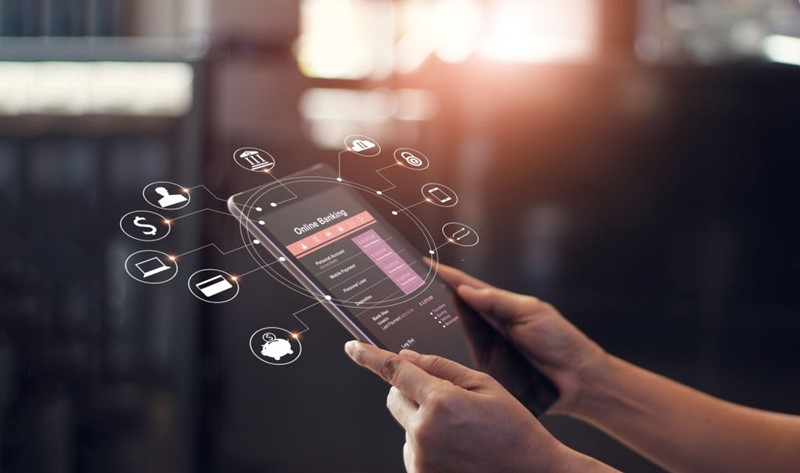
Main Mobile Banking Features
For efficient mobile banking application development, most users (86%) are interested in two features – checking balances and exchanging funds between accounts.
5.1. Essential Features of Mobile Banking
The general features used in mobile banking development that are hard-to-avoid are as follows:
- Account creation
It is imperative to build a secure and quick authorization process. Multi-factor authentication is a safe sign-in option but takes some time to fill in the necessary information.
Alternatively, biometric authentication using physical user metrics (appearance, voice, even gestures) is far quicker and even fun.
A MasterCard study indicates that users have become more willing to use personal biometrics as their passwords. The Wells Fargo app has a verification feature that scans the iris of their corporate customers.
- Account management
This point may include a range of mobile banking features. Users can check their cards, bank accounts, review account balance and record history, etc.
It is even possible to implement some additional functionality. For instance, the ABN AMRO Bank in the Netherlands included a unique mobile banking feature for personalized account management.
This feature allows users to set a savings goal, create investment plans, and perform repeat payments.
- Bill payments
Users have the option to schedule one-time or monthly payments within the app, pay when notified through email or push notification, or both. Alerts, for instance, will work well if customers deal with utility bills and variable amounts. While fixed payments like mortgages benefit greatly from recurrent payments.
UI/UX designers will likely break this action down into several steps if there are numerous information or large forms to fill out. By doing this, the procedure is less intimidating than filling out a huge form all at once.
- Customer support
Although automation is the main focus of banking app development, some human assistance is still required. Staff support or additional verification may be needed for some operations. When you need to adjust your credit card limit or unblock a card, for instance.
Users need to be able to speak with a bank representative or a personal manager, submit requests, and get their questions answered. If your customer service crew isn’t available around-the-clock, you may at least include a FAQ section or deploy an AI-powered chatbot.
Learn More On: Fitness App Development: Features, Trends and Costs
- ATM & bank branch locations
Mobile Banking Application Development should not skip this fundamental feature of mobile banking services. In order to improve the user experience, it is possible to apply VR technology. This is a unique feature of mobile banking implemented by RBC. It allowed the bank to increase the number of its app downloads tremendously.
- Secure payments and transactions
P2P transactions, payments for services, and fund exchanges should be processed securely and conducted anytime and anywhere with the help of a banking app.
An alternative variant of this feature in mobile banking application development is using QR codes for goods and services payments. Scanning QR codes is a fast and easy way to conduct these operations inside the app. Only a few banks have offered this mobile banking feature to their clients.
- Push notifications
Mobile banking application development should utilize reminders and alerts to increase customer engagement and app promotion. It is necessary to control this aspect and plan the communication strategy with your client in advance because most users would not appreciate receiving intrusive notifications.
5.2. Extra Mobile Banking Features
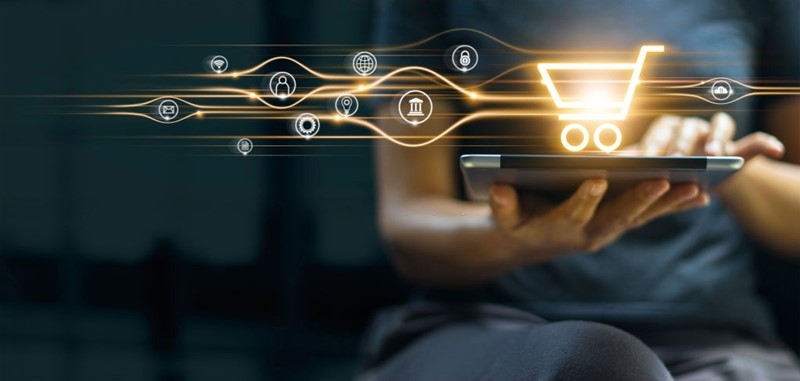
Enhance your application with these features
The app features mentioned earlier create the core of mobile banking application development. To increase user traction and interest, you should be thinking about some innovative mobile banking features which might ultimately be the deciding factor of your app likes:
- Spending trackers
Mobile banking development should focus on user needs, even if they are not explicit. This functionality can control personal budgets and set some goals for desired purchases. The system can create a customized dashboard based on user information, give necessary motivation, and inform users regarding progress.
Alternatively, users can set some scheduled payments and bills in advance not to miss an important transaction. This mobile banking feature is utilized in a significant way in the Simple App. The app is used to track spending habits, plan budgets, and save on each expense.
- Cash back service
Cashback means receiving a tiny percentage of the money spent by customers. Many banking apps offer automatic payback on numerous brands or services such as entertainment, shopping, and car maintenance.
- Personalized offers
It makes sense to create special offers, discounts, or coupons with a mobile banking app. The opportunity lies in partnering with restaurants, cafes, coffee houses, and so on for the provision of particular discounts or coupons. This feature stimulates sales and, at the same time, engages the user with your mobile banking software.
- QR code scanner
In 2020, more than 27% of respondents in the United States and the United Kingdom utilized a QR code as a payment option. And this feature has become increasingly for banking apps in Asia as the result of the advancement in payment method.
QR payments are secure because of their distinctive design and are simple to set up: all consumers need is a smartphone with a camera and a QR code to read.
- Money converter
The number of tech-savvy foreign exchange companies is rapidly increasing, and banks must stay up. Some banking apps only display in-app exchange rates, whilst others go the extra mile and include a full-fledged in-app converter.
For example, combining multi-currency spending and money transfers in a simple app is what made the Revolut app popular.
- Apps for smartwatches
Although just a few banks provide wearable apps, smartwatches continue to be the most popular wearable gadget. Offering such could provide you a competitive edge.
The first banking app for smartwatches was developed by the Australian Bank of Melbourne. Customers might use their smartwatch to pay for goods and services, receive push notifications, check their balance, and locate the closest ATM.
Mobile Banking App Made Easy With Savvycom
Reach out to Savvycom for complimentary software development services consultation. We’ll assist you in determining the next course of action, elucidate the organization of the development process, and furnish you with a no-cost project estimate.
- Unique services
Mobile banking application development can include other non-traditional services. These services can consist of purchasing tickets, ordering a taxi, reserving a table, delivery, and more.
For example, a Polish bank (Zachodni WBK) reached out to new users with the functionality of paying for public transport, shopping, and taxi-hailing directly from its mobile app.
- Finance sharing feature
Visa research indicates that to attract millennials, it makes sense to concentrate on mobile banking application development for budgeting. This mobile banking app may include sharing finances and splitting bills.
For instance, the app from Emirates NBD has a bill-splitting feature where each user has to include some sum and indicate the number of people participating in the operation via social networks.
Final recommendation: It is better to develop a couple of apps with distinct mobile banking features rather than complex software with lots of operations, details, and data. Try to ask your target users about their priorities in banking procedures and focus on providing a solution for them first.
6. Mobile Banking Application Development Processes
6.1. Conduct Research And Make A Plan
The preliminary stage is crucial and shouldn’t be skipped at any cost. The first task is to conduct market research. You need to identify your competitors, check alternative solutions on the market, and learn what is popular among the crowd. Without doing this, you may go in the wrong direction.
Once you’ve got the research results, continue with defining your target audience. Your application may be for corporate clients, families, individuals, or institutions. Knowing your clientele will help you find out their pain points, which are crucial for sketching an app toolkit.
In this step, you should make a detailed plan for mobile banking development, including expenditure projections that will become a foundation for your budget.
6.2. Create A Prototype
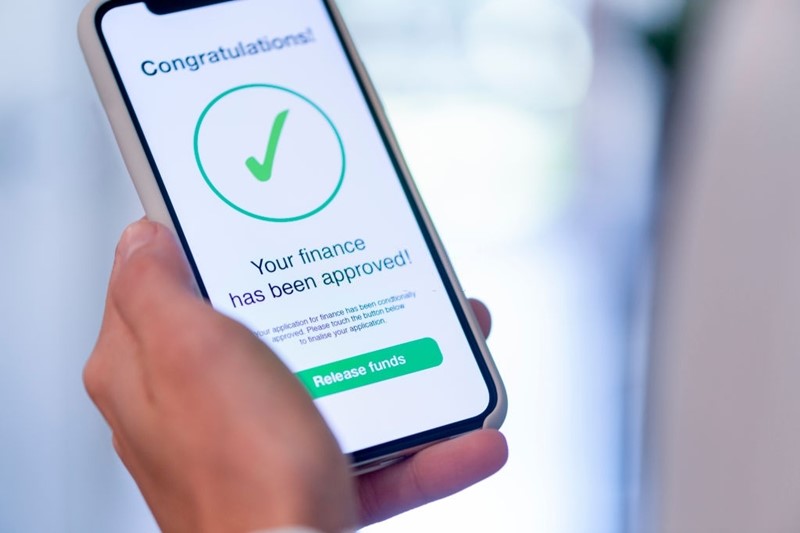
A mobile app prototype demonstrates how a product will function
Every Application starts with an idea in your mind. To turn it into reality, you need to create a sketch or prototype explaining in general terms the structure and order of design elements, visuals, and content. You may start with low-fidelity wireframing to sketch a home screen, users’ accounts, personal dashboards, and the layout for a landing page.
As a rule, wireframes consist of boxes, lines, and texts made in the white and black color scheme. You can use an app wireframe to validate your concept and collect early feedback. Next, you can turn your wireframe into a hi-fi prototype that will include a graphic presentation of a product, layout, interface components, the color scheme, and micro-interactions.
Just like wireframes, use your app prototype to demonstrate its toolkit to your focus group, test functionality, and interface. You can add default texts, placeholders, and test data so that people can feel how your app works.
6.3. Make A Graphic Design
Be ready for hard work in this step as your app’s design is its business card that should be recognizable. There are tons of tips on how to make a perfect design for a mobile application. We have created a shortlist of essential recommendations. Check them below.
- make sure that typography, icons, color palette, buttons, and forms of your solution match your corporate style and brand;
- the navigation should reflect the logical architecture of your solution;
- all the design elements – buttons, links, forms, icons – should be clear and comprehensive;
- choose colors, images, video files that evoke certain emotions and feelings;
- consider cultural differences if you’re going to operate globally;
- adjust your app to iOS and Android standards to efficiently market it earlier on;
- your app icon should be unique and make your solution stand out;
- think about extra bells and whistles like sticker packs for messengers.
Learn More On: All You Need To Know About Telemedicine App Development
6.4. Choose A Technology Stack
When choosing a technology stack for your Mobile Banking App, you should concentrate on four areas: front-end, back-end, cross-platform frameworks, and other prerequisites such as robustness and security. Make a checklist that would include the following criteria
- project scope, complexity, and scalability;
- the number of specialists and the level of their competence;
- necessary tools and software;
- outside solutions;
- docs and specs.
There are different kinds of applications: native apps, hybrid solutions, cross-platform applications. Each has its pros and cons and unique features. Native apps are robust and demonstrate high performance. They’re ideal for an established business. Native apps allow specialists to use the native functionality of Android and iOS devices without utilizing third-party APIs.
Hybrid apps are developed using web technologies and can be built for different platforms thanks to a unified codebase. Based on HTML, CSS, and JavaScript, hybrid apps can function as progressive web apps.
6.5. Develop And Test

The benefits of Mobile App Testing include optimizing in-app experiences, boosting core metrics, and experimenting with the existing mobile app features in production
The most efficient mobile banking app development path you can choose from is contacting an outsourced team. If your idea is brand-new and requires a custom approach, you can’t do it without external help.
The development process allows building a well-thought-out architecture, developing life-like user paths and journeys, creating a user-friendly interface that won’t have analogs, and choosing a technology stack that suits best. The most challenging part is to get a team together, as the quality of work will influence the overall outcome.
6.6. Market Your App And Get Feedback
The most popular app marketplaces – Google Play Market, AppStore, and Microsoft Store – have different requirements for applications you should follow to avoid rejection. In case you opt for an outsourcing team, you can be sure that your off-the-shelf product will adhere to these standards by default.
6.7. Improve And Update
The app launch is just the beginning. To get valuable feedback and learn what to improve and update, ask the mobile audience for feedback, contact app review sources, ask influencers and bloggers to test your product.
If you focus on Apple users, you may submit your application to Apple’s editorial team to get an expert review. Another good idea is to apply your app to Top Apps lists or mobile app awards.
Once you’ve got feedback, you can define the weak and vital aspects of your product and decide how to make it better.
7. Mobile Banking Application Development Cost
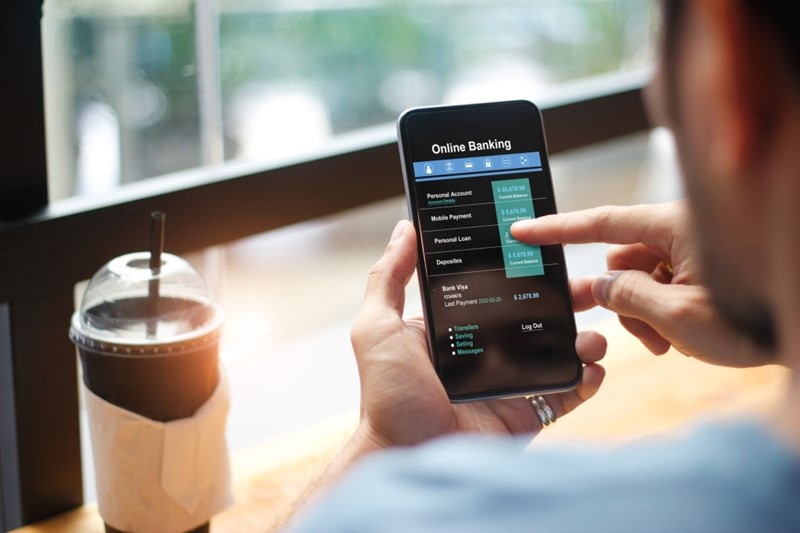
Clutch’s study indicates that the cost of complex solutions, including mobile banking application development, ranges from $200,000 to $500,000
However, the cost of making an app depends on its processes and features. We will give you a rough estimation of how much it will take for you to build a mobile banking application.
You may wonder why banks are investing in mobile banking application development. This is the most efficient method of customer engagement, which definitely outweighs the traditional methods that still involve resellers, support staff, and agents. As well, mobile banking development acts as an effective communication point with the possibility to get up-to-date market insights and improve banking services.
7.1. Discovery
We conduct a thorough business analysis to determine how the app will work in detail, what users can do, and whether third-party services are required.
What you get: functional specification with user flows, diagrams, and wireframes.
Cost: USD 2,400 – 3,200.
7.2. UI/UX Design
Based on the user flows and features we determine during the discovery stage, we’ll come up with user experience design to make sure we’ve covered all the business requirements and user needs at the same time. Then we’ll produce a user interface design of the app that includes the visual representation.
What you get: high-fidelity prototypes ready for implementation, along with a style guide.
Cost: USD 16,800 – 24,800.
7.3. Web Development
Mobile apps require administration and it’s usually a web-based admin dashboard.
What you get: a user-friendly admin back-office with functionality to manage the mobile app.
Cost: USD 135,000 – 153,000.
Your Next Best Mobile Banking App Is Waiting!
Get in touch with Savvycom for a free consultation. We’ll help you decide on next steps, explain how the development process is organized, and provide you with a free project estimate.
7.4. Mobile Development
We develop an API to communicate with the server-based app developed in Phase 3.1 and put all things together: design, functionality, API.
What you get: a fully-working app ready to upload on Google Play Market or AppStore.
Cost: USD 45,000 – 64,000.
In general, mobile banking development and all mobile app development services can be split into two stages, Discovery and Development. The discovery stage includes all the preparatory work for the project performed by a business analyst, who is responsible for the development of your app from a business perspective, and a software architect, who aligns business aspects with technical implementation.
8. How to Create a Mobile Banking App Project Successfully
It is absolutely certain that the banking sector will only become more and more digital. Mobile banking application development allows the industry to increase efficiency in operations, reduce bureaucracy, and enhance customer experience while promoting banking services. So what makes a good banking application?
Applicable and user-friendly functionality that is secure and easy to access. These can include, but may not be limited to:
- Checking the account balance without login
- Integrations with device info and tools (e.g. address book)
- User customization based on recent actions and regular transactions
- Customizable offers
- Creation of personalized and useful notifications
Application of advanced, innovative technologies like AI, Big Data, AR, VR, and Blockchain to enhance the user experience
Adding new functionality and scale software in accordance with upcoming mobile banking trends, namely:
- Use of voice user interface (VUI) to increase customer engagement
- Use of artificial intelligence and machine learning for self-service in banking industry
- Use of advanced verification technology with biometrics to avoid data breaches
All this shows that mobile banking application development offers many opportunities to create a customer-centric experience in the banking sphere. This niche still has room for useful banking apps, so it is time to plan yours today.
Savvycom – Your Trusted Tech Partner
Since 2009, Savvycom, a software development company, has been utilizing Digital Technologies to fuel business expansion across diverse industries. Offering a spectrum of services from Tech Consulting and End-to-End Product Development to IT Outsourcing, Savvycom specializes in crafting high-caliber software solutions and products, supplemented by an array of professional services tailored to meet your needs.
Savvycom is right where you need. Contact us now for further consultation:
- Phone: +84 24 3202 9222
- Hotline: +84 352 287 866 (VN)
- Email: contact@savvycomsoftware.com
What are The Advantages of Mobile Banking App Development?
- Users love banking apps because they're convenient, secure, and have tons of valuable features, making it easy to access a personal bank account at any time, from anywhere.
- For Banks, having a mobile app means lowering staff expenses and operational costs and even going paperless and thus environmentally friendly.
What Features to Include in a Mobile Banking App?
The core features most banking apps share:
- Account creation & account management
- Payments and transactions
- Bill payments
- Push notifications
- Personal manager/customer support
Nice-to-have features:
- ATM & bank branch locations
- Spending trackers
- QR code scanner
- Cashback service
- Money converter
- Apps for smartwatches
Best Technology Stack For Mobile Banking App Development
Teamwork makes the dream work! That's why having the right team with the suitable Technology Stack often results in an App that could last for a long time. But are you sure? You already have the right Tech Stack. Here are the tools and technologies we at Savvycom recommend for Mobile Banking App Development.
Native App Development
If you create a banking app solely for iOS or Android, you should opt for native app development. Regarding iOS-based mobile banking software solutions, the best technology includes Swift, XCode, and iOS SDK. If we're talking about Android-based mobile banking development, then Java, Kotlin, Android Studio, and SDK are the tools of choice.
Cross-platform App Development
Cross-platform app development is a winning approach that allows banking app developers to use a single code base for different operating systems. React Native, Flutter, and Xamarin will aid in building cross-platform apps.
Hybrid App Development
Hybrid mobile apps blend native mobile app development and web development. They are usually built using HTML5, CSS, JavaScript, etc.
Another Step-by-Step Guide on Mobile Banking Development
- Step 1: Conduct research and make plan
- Step 2: Build and verify prototype
- Step 3: Lay the groundwork for security
- Step 4: UI/UX Design
- Step 5: Choose Technology Stack
- Step 6: App Coding
- Step 7: Integrate with third-party solutions
- Step 8: Release and maintain
- Step 9: Market your app and get feedback
- Step 10: Improve and update
How Much Does Mobile App Development Cost
The cost of mobile app development can vary widely depending on several factors, including the complexity of the app, features, platform (iOS, Android, or both), design, and the development team's location and expertise.
Simple apps with basic functionality might cost anywhere from $5,000 to $20,000, while more complex apps with advanced features can range from $20,000 to $150,000 or more. High-end, sophisticated apps, such as those with complex functionalities, extensive backend systems, and high-quality design, can exceed $150,000.
It's important to note that these are rough estimates, and costs can vary significantly based on individual project requirements and the development team's rates. Additionally, ongoing maintenance and updates may incur additional expenses after the initial development.
With such rapid growth, it goes without saying that the LMS market is hotter than ever. Hence, the question “How to build a learning management system?” is becoming increasingly prevalent.
Savvycom, the leading software development company in Vietnam IT hub, are here to provide you with a complete answer, including everything from the many types of LMS to its fundamental features and the specific procedures in this process.
What is Learning Management System?
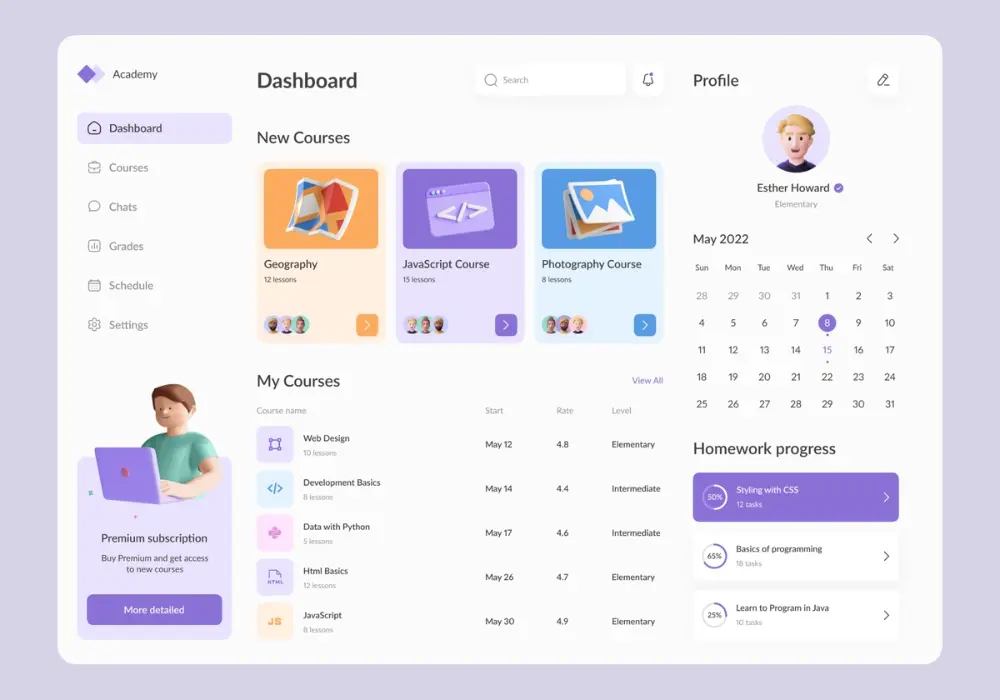
A learning management system (LMS) is software that allows educators to develop, share, and manage various training courses and programs. LMSs offer numerous tools that simplify the creation of educational resources such as scripts, presentations, audio, and video materials and establish the complete learning process through pacing, various assessments, grading systems, and more.
An LMS, like other software, is often composed of two parts:
- CMS and administration: Educators use this interface to engage with the learning management system. This interaction includes managing existing courses, developing new courses, adding students, analyzing progress, connecting with students, and various other tasks.
- User interface: This interface may alter depending on the device on which it is launched. However, all platforms share one feature. Students enroll in the course and interact with the educator’s content via this interface.
Creating an LMS for your business
Building an LMS may bring a plethora of benefits to your company. Let’s see the main reasons you should consider developing a Learning Management System.
Managing partner training: This is an excellent way to improve affiliate programs and provide more value to counterparties. Partner training is another great approach for enhancing affiliate programs.
Client education: Customer learning management leads to greater product value and helps prevent user loss. Companies that want to attract clients effectively may want to consider acquiring this sort of training.
Staff training: LMS can boost the educational process’s importance by centralizing training resources and encouraging employee participation through digital learning. Furthermore, constructing a remote learning system for individuals operating in remote locations has become imperative.
Assessing employees: A learning management system is commonly used for receiving mandatory training and testing one’s knowledge, tolerances, regulatory documents, and certifications.
Supporting HR: The system offers the chance to convert paper documents and records into digital format, develop software that caters to the needs of your employees, and automate tasks that are typically performed by human resources.
6 Types Of LMS
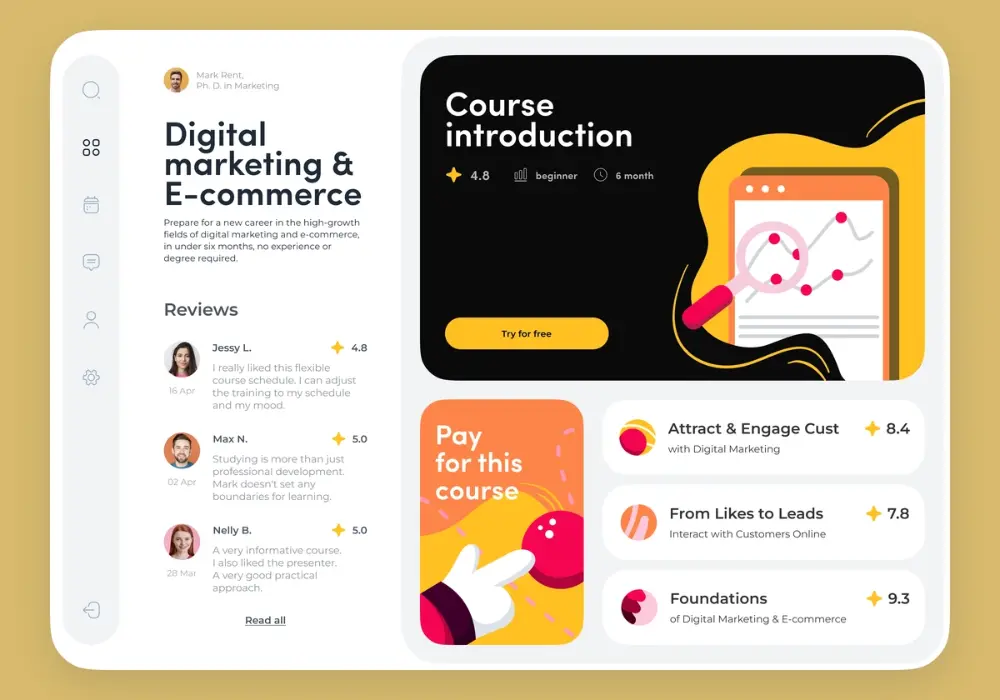
Before we move on to the process of designing a bespoke learning management system, let’s explore the main types of learning management systems.
Open-source
A free, open-source learning management system may be tailored to meet any needs. It also implies you’ll need an accredited expert to create a custom learning management system out of free code. Reliable support may also be lacking.
Commercial LMS
Commercial LMS software is expensive and can only be modified by the firm that owns it. If you are a customer, you may be missing out on certain desired functionalities. On the other side, you get consistent and dependable support.
Installed LMS
An installed or hosted LMS operates on your premises and stores data on your own servers. Therefore, it is highly secure and completely customizable. However, you will want an in-house server rack for installed LMS development and maintenance.
SaaS LMS
The vendor hosts and maintains the software-as-a-service learning management system in the cloud. You, as a customer, will pay a membership fee and focus exclusively on training. There is minimal room for customization. This might be one of the reasons for developing your own LMS system.
Integrated LMS
Integration with third-party apps may be necessary during the development of a learning management system. Some of the most common apps to integrate with an LMS include social networks, calendars, talent management systems for HR function support, email, and other tools.
Non-integrated LMS
Some LMS systems may limit their features to the fundamentals. These LMS kinds’ only purpose is to give users a single source of important information.
Have a Project Idea in Mind?
You are more than welcome to contact our Partnership Manager for a free consultation.
Fundamental features of an LMS
What are the key features of an LMS that any learning system should have? When you decide to create a learning management system, include the features listed below when you begin your LMS creation quest.
Course Builder
The capacity to build courses that will be used to train people in your company is the most critical part of an LMS. It should be able to develop various courses, ranging from themes to quizzes for testing students.
Content management
One of the most crucial roles of LMS systems is that it serves as the foundation for everything. Educators can use it to manage current courses (alter tags and descriptions, conceal or add ready-made courses to the list) and create new ones.
User and group management
This feature is critical for creating a smooth learning experience. It enables teachers to divide students into groups, give assignments to entire groups or individual students, send students private messages and alerts, and much more. As a result, contact with the platform will become more comprehensive and convenient.
Report and analytics
LMS reporting features provide you instant access to actionable learning data. View individual and group aggregated reports. In the shape of a grade book, these reports provide a birds-eye perspective of your pupils’ results. You may also filter reports by time, such as today, yesterday, and the last seven days. View only the required information without having to scroll up and down a report.
Testing and assessment
The most crucial training step is assessment, which allows you to determine how the pupils mastered the new educational content. This module should provide the ability to build a wide range of assessments, from basic one-answer exams to multi-answer quizzes and activities needing a detailed answer. Moreover, options for defining deadlines and time restrictions for a specific test should be introduced.
Reminders and announcements
Other important aspects of a training LMS include reminders and announcements. They allow students to meet course completion or credential expiration deadlines. This feature allows instructors to define a completion date for courses or quizzes. They can also specify certificate expiration dates. This is a simple way to assure ongoing compliance and a greater course completion rate.
User roles and permission
Safety comes first. Editors can configure access to certain course blocks, information, and functionality using user roles and permissions to maintain data security. This will increase confidence among users in your platform.
Gamification
Classic online learning may be tedious, especially if you’re creating an LMS website or app for a younger audience. Gamification solves this problem by making learning more fun and engaging. You may, for example, build a simulated transition to the next level, implement a system of rewards for task completion, and so on. As a result, user engagement will rise.
Mobile learning
One of the most helpful features of a Learning Management System is the ability to access training materials and assessments on mobile devices such as smartphones and tablets. Furthermore, it encourages individuals to finish their courses on schedule and aids with retention. This powerful technology is very beneficial since it enables self-paced microlearning on mobile devices without needing a place to study. Remove typical scheduling concerns by allowing students to learn at their own speed if they meet deadlines.
8 steps to build a learning management system
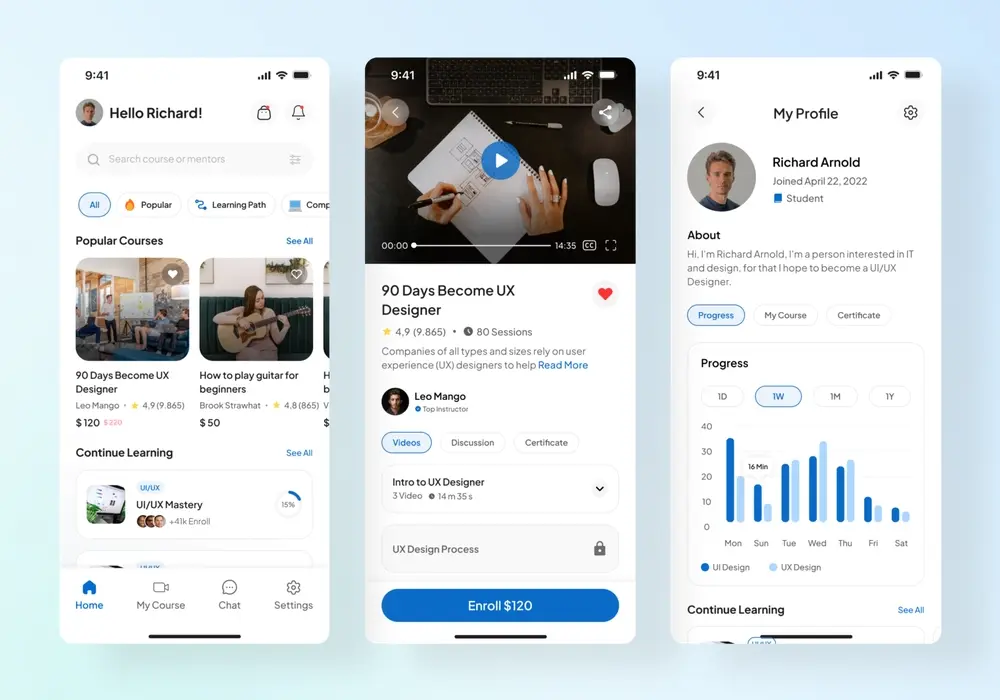
Now, let’s go through a step-by-step procedure to get a learning management system that will be a trusted assistance for you and your company’s employees.
Step 1. Analyze and improve your idea
This is the foundation step for all following development decisions. The future shape of your LMS is defined at this point.
Ask yourself the following questions to determine a project idea:
- Why do you need an LMS?
- What are your organization’s problems that this LMS may solve?
- Who will develop and implement the LMS?
- What are the required resources for LMS development?
- How much will you invest in the LMS?
Based on our expertise, the two most prevalent issues that users may encounter with an LMS are complex systems and unoptimized UX/UI design, both of which provide an imperfect experience.
Furthermore, the monetization strategy should not be overlooked when designing the future LMS. Many LMS systems are frequently paid to remove adverts or banners that may distract students from the learning process.
You may take into account the following monetization alternatives:
- Paid software with a trial period: Although commercial LMS systems are widely available, they compete hard in the market with free systems. To get people to start buying your platform, you must first create your own LMS system, which must be a high-quality product that provides users with unique solutions that no competitors have.
- Freemium software: At its core, this software is free; you provide certain functionality for free, but the user must pay to unlock any additional useful features. For example, your LMS may include chat functionality for basic communication, but video calling with screen capture may be a premium feature that requires payment.
Step 2. Select an experienced vendor
A competent LMS platform development requires extensive experience to integrate all key features effectively for a faultless user experience. You may decide to cooperate with an expert education app development business to outsource your product. They will consult you on any technical concerns and carefully lead you through the software development process, from idea validation to development and support.
Step 3. Consider your LMS’s features
You can’t start developing a learning management system unless you know what features it will include. As a result, you must define all functionality in advance.
We have already discussed the essential components of an LMS.
Step 4. Work on responsive design
When designing a learning management system, you should have a well-thought-out design of the future system since it affects half of the user experience. In addition to the carefully chosen color scheme and block design, the system should seem perfect on all existing devices. Responsive design, which implies automated adaptation to any device, is important for such solutions.
The ability to utilize the platform on mobile devices is critical nowadays since it speeds up the learning process. As a result, developing a responsive online resource or mobile application design is critical. So, users may quickly access instructional resources from any location. Also, remember that the LMS should be easy to use for all participants, whether instructors, students, or administrators.
Step 5. Sort information into the specification
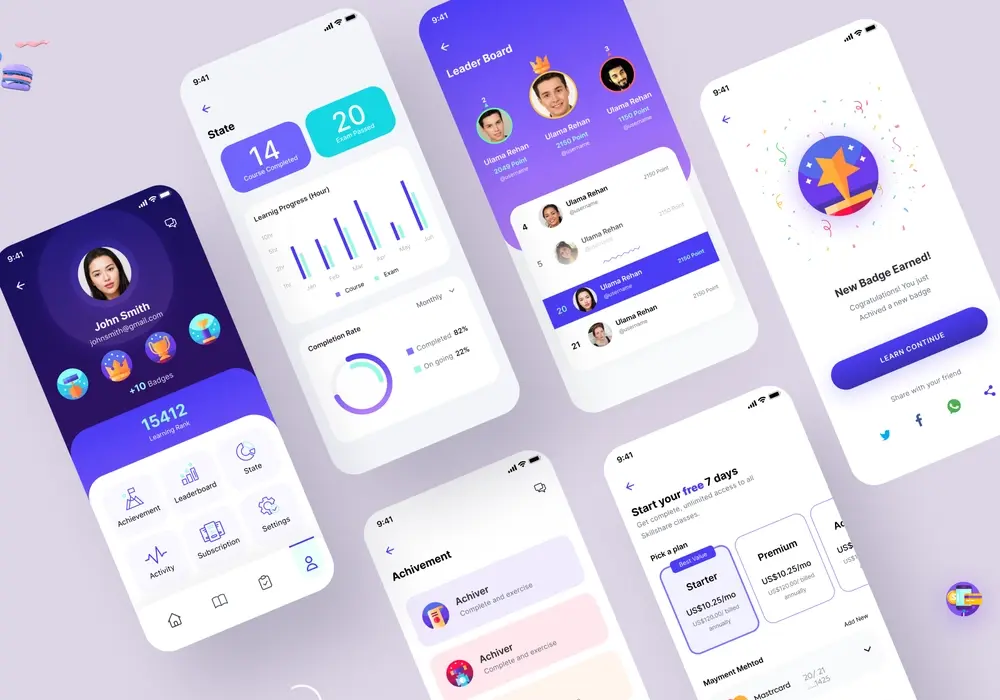
The next step is creating a specification – a document that fully covers all information about the business, business goals, the concept of the LMS system, its needs, its features and technologies, and the technologies on which future development will be based. Your software provider compiles this document under your control. After you have approved all the specifics, you may go on to the development step.
Step 6. Develop the LMS
In this stage, UI/UX designers start to build screen prototypes for the LMS using specifications and wireframes. After the design phase is completed, designers hand over all layouts to the development team. Developers employ their technical knowledge to transform appealing designs into functional products. The development process consists of sprints. During each sprint, which typically lasts two weeks, developers must implement a certain aspect of the product’s functionality.
Step 7. Release LMS
When all of the features have been produced, and the LMS has been polished, it is time for the release stage. You should hire a marketing business to help it grow.
The firm should be launched around a month before the release for the optimum effect. You may begin by advertising your brand’s social networks by making publications about your product’s upcoming release in which you advertise your LMS in-depth and explain how your solution is superior to rivals. Also, don’t forget to purchase contextual advertising. It will assist in making your products visible for an extended period. Announce the release on social media, buy adverts inviting people to sample your product, and submit prerelease posts.
Step 8. Support based on user feedback
Your product is now live and earning money. You can now start thinking about LMS support and enhancements. This is where user reviews can help. Analyze user feedback to determine what you successfully implemented and which areas of the LMS require improvement. This will help you plan for future improvements.
Furthermore, you may immediately begin integrating new features to increase the platform’s functionality and enhance the user experience. The Savvycom team provides technical support and software updates to keep your product up to date with new technologies. Furthermore, our professionals can assist you in expanding the functionality or developing LMS from the ground up.
Looking For a Trusted Tech Partner?
We’ll help you decide on next steps, explain how the development process is organized, and provide you with a free project estimate.
Costs of developing a learning management system
The LMS system typically costs between $40,000 to $400,000 or more. The exact pricing can be tricky to calculate at this time because it is affected by numerous aspects such as project scope, feature complexity, third-party integrations, etc.
If we divide the LMS solution by its level of complexity and size, we get the following picture:
- Simple LMS: $40,000 – $60,000+
This kind of LMS is better as an MVP.
- Medium complexity LMS: $60,000 – $150,000+
This is suited to those who want to create a functional solution with a basic set of features.
- Complex LMS: $150,000 – $400,000+
If you want to produce a high-quality product with complex features, go with this one.
In short, the number and complexity of the LMS’s features are what impact the final costs the most. Below are factors that have a significant impact on an educational system:
- Registration and installation fees
Cloud-based learning management systems charge for the initial download or registration. Some LMS providers charge monthly subscription fees rather than upfront payments. If it is unclear, contact your LMS provider for an overview of all LMS software prices and due dates.
- Platform support and maintenance
Support costs approximately 15-20% of the original cost. There is no direct cost because the LMS supplier often manages this internally. Integration of an LMS into your learning and development plan, as well as software updates, frequently incur extra fees.
- Annual licenses renewal fees
You may swap LMS platforms or renew your licensing when your agreement expires. Check the license agreement with the LMS vendor again. Do changes and extra materials cost money? What kind of support is available?
- Learning content development
Without online tutorials to download, building a new LMS is pointless. Consider online learning development costs or the expense of a certain material.
- Personnel training expenditures
To build an effective working procedure, you must thoroughly train the employees. This could involve online lectures and step-by-step instructions and engaging an LMS provider to dispatch an expert technician to reduce the learning curve. Your team’s experience and the intricacy of your LMS platform are key factors to consider.
- User prices
Some LMS providers charge per user. For this reason, you must take into account the LMS’s online learner count. The majority of LMS software pricing is determined by the number of active users.
Besides the above costs, you should also be aware of:
- Third-party integration: Connecting your LMS to Grammarly, Amazon, or other internet services will incur costs.
- Hosting fees: Users can access an LMS after it is published on a hosting site. There may be an additional cost if a larger repository is required to hold all the media files.
- Strict deadlines: A larger crew may be required to complete the project within the specified time frame, resulting in a salary increase.
- Software development method: If your technology partner adopts an Agile development approach, as Savvycom does, you can collaborate with the entire team, which may provide more opportunities for negotiation.
Savvycom – Your Trusted Tech Partner
Since 2009, Savvycom has been leveraging the potential of digital technologies to assist business growth in a number of industries. We can assist you in developing high-quality software development services and products, as well as providing a comprehensive range of related professional services, including Tech Consulting, End-to-End Product Development, and IT Outsourcing Services.
Savvycom is right where you need. Contact us now for further consultation:
- Phone: +84 24 3202 9222
- Hotline: +84 352 287 866 (VN)
- Email: contact@savvycomsoftware.com
Nowadays, with just a tap of your finger in mobile banking software, you can make your life a lot easier. As a software development company, Savvycom will guide you through Mobile Banking Application Development. Everything that you need to know before starting your Mobile banking application project.
In this article, we will help you find out what is mobile banking and how does it work.
1. What Is A Banking App?
A banking app is a created mobile app for business where you can access your bank account’s details and complete transactions directly from your phone, tablet, or mobile device. Based on the bank you’re accessing, you’ll be able to complete a variety of actions via your banking app.
Most banking apps allow you to view your current balance and transaction history; deposit checks up to a specific dollar value. Another thing you can do is to initiate transfers to other bank accounts, schedule payments or pay your bills, send person-to-person payments, and locate ATMs that are free for you to use.
2. Why You Should Build A Mobile Banking App?
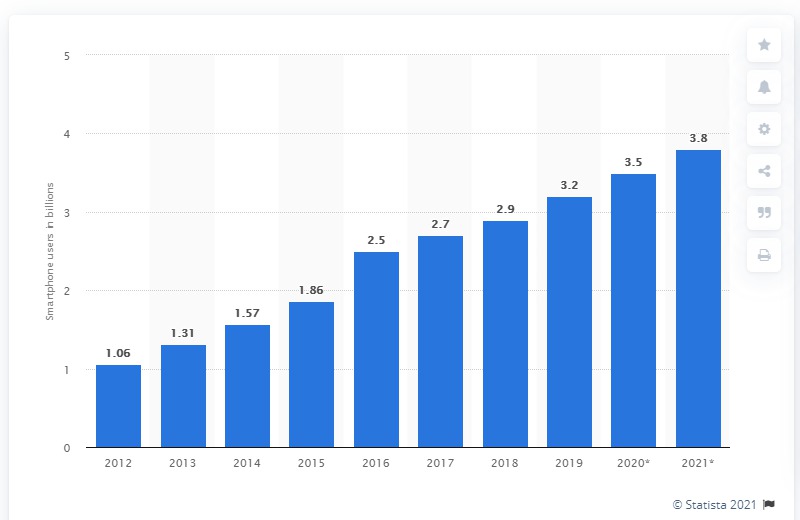
Number of smartphone users worldwide from 2016 to 2021 (in billions)
Imagine that almost one-third (32%) of the global population utilizes mobile banking software. Mobile Banking App is something that you cannot miss on your phone and here are the reason why:
- In January 2023, mobile devices excluding tablets accounted for nearly 57% of web page views worldwide. – Statista
- The worldwide number of mobile internet users is expected to rise by 908.4 million (+17.4%) between 2023 and 2028. – Statista
- 6 out of 10 mobile users prefer mobile apps over mobile websites and other platforms for account management. – Thinkwithgoogle
- According to latest research, 90% of individuals use mobile banking apps to check their account balance, and 79% use mobile banking apps to monitor recent transactions. – Statista
3. Benefits & Advantages of Mobile Banking Application Development
The benefits of banking app development are mutual:
- Customers benefit from such applications since they provide ease, simple access to a bank account, security, and a slew of other valuable features, which we’ll go over next.
- Having a mobile app means lower staff costs, lower operational costs, and even going paperless, which is more environmentally friendly.
Reduced expenses
Banks save a lot of money by using mobile apps. Here’s how it’s done:
- Expand your coverage. Your company is not bound by branches, regional centers, and so forth.
- Handle heavy workloads. Requests cannot be processed 24 hours a day, seven days a week. They eventually weary and make mistakes, but automation does not have this problem.
- Increased precision. Human mistakes and operational risks are decreasing.
- Reduce the cost of customer service. You require fewer personnel and do not need to rent an office space or incur other connected costs.
Mobile transactions, for example, are 10 times less expensive than ATM transactions, costing only 0.08 cents apiece. In comparison, an ATM transaction costs 0.85 cents while a branch transaction costs $4.00.
Improved customer experience
Mobile apps simply provide more benefits to clients. They’re more secure and convenient: you can’t use fingerprint login with a chatbot or keep a PC in your pocket. Remember that 6 out of 10 people prefer using a mobile banking app over a mobile banking website.
Furthermore, app making companies enable on-the-go 24/7 access to all digital banking solution services. Constant accessibility saves time. For example, you may monitor deposits, see recent transactions, schedule bill payments, and so forth, whether at home or when abroad.
Higher return on investment (ROI)
To make a mobile banking app concept a reality, much market research, time, money, and resources are required. Every company anticipates a positive return on their investment in the creation of a mobile banking app.
A mobile banking app owner might anticipate outcomes in a variety of ways. It might be in the form of higher user involvement, a larger customer base, increased revenues, or enhanced market reputation.
There are various case studies of top financial organizations that have seen excellent benefits from building and using mobile banking apps into their procedures.
Better security
Customers’ security is one of the top priorities. Both internet and mobile banking have their own set of vulnerabilities, but added hardware security makes mobile banking more safe than online banking.
Banks utilize gesture patterns and biometric data such as fingerprint and retina scans in addition to standard passwords and two-factor authentication to maximize security. Almost all financial institutions employ encryption to safeguard financial information and privacy, ensuring worry-free mobile banking. Furthermore, because of the proliferation of platforms, malware is less likely to threaten an app. Even if your consumer loses their phone, their financial information is secure.
Additional Revenue Streams
According to Fiserv, mobile banking apps boost return on investment in a variety of ways. According to the survey, banks might see a 72% increase in income from mobile banking users when compared to clients who solely use branches. Customers are also more likely to raise the quantity and value of their debit and credit card, ATM, and ACH transactions after three months of utilizing mobile banking apps.
Banks may increase income with mobile apps by incorporating value-added offerings such as lending, insurance, or BNPL.
Advanced data analytics
Continuous data collection can yield fantastic outcomes. Using advanced data analytics in customer care, sales, and marketing may assist create individualized product offerings that appeal to individuals individually at certain moments.
Furthermore, intelligent data management and analytics provide businesses with valuable insights into their customers’ problems and needs, allowing them to resolve them more accurately and quickly.
Better user engagement and retainment
Push and in-app notifications provide several advantages to you and your users. They educate clients about appropriate offers and discounts, as well as higher credit limits or interest rate information.
Banks who have already put this option in place have a competitive edge over other financial institutions. For example, BNP Paribas reports that after implementing targeted push and in-app alerts, the bank’s App Store rating increased by 60%.
In short, mobile Banking Application Development provides valuable advantages for both the bank and the client.
Looking For a Trusted Tech Partner?
We’ll help you decide on next steps, explain how the development process is organized, and provide you with a free project estimate.
4. Mobile Banking Development Trends
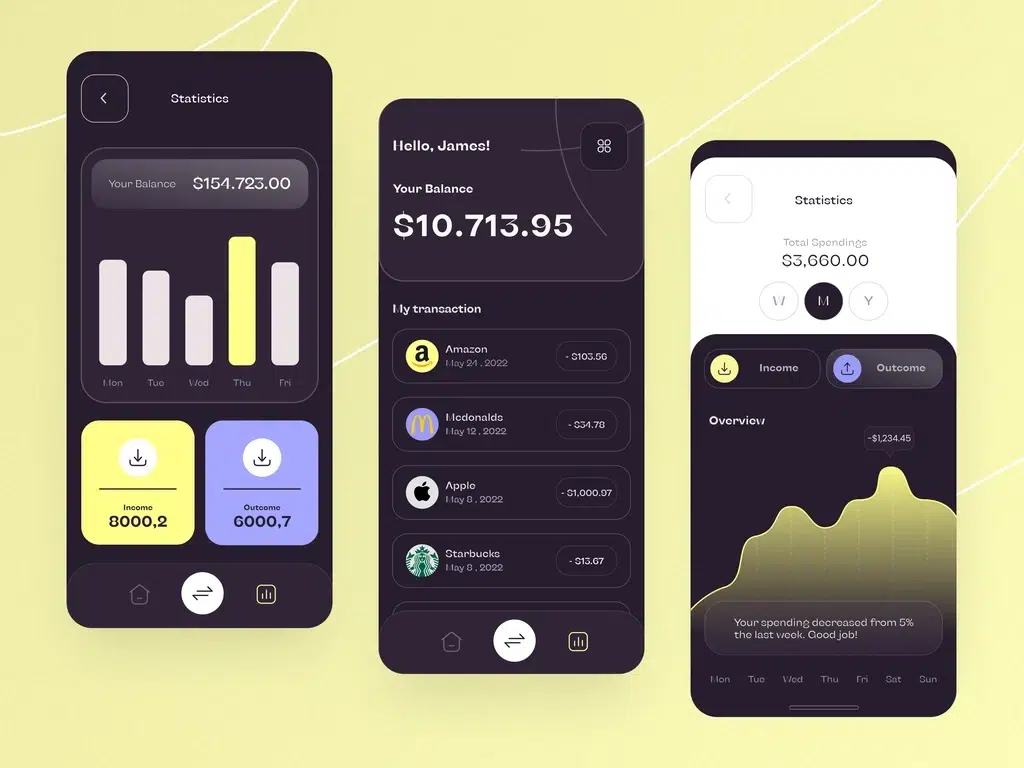
To get the best outcome from mobile banking application development, let’s examine the current market tendencies, what customers demand from banking software.
4.1. Mobile Banking Trends
Removal of ATM cards for cash withdrawal
Cardless ATM withdrawals are one of the most popular next developments in mobile banking. This function has already been added to several banks’ ATMs.
Debit cards won’t be required going forward if this functionality is used. Users will be able to log onto their bank accounts and complete transactions using the Banking app. Around 70,000 banks will eventually allow cardless withdrawals in the US, according to a Small Business Trends survey.
Growth of Biometric authentication
The mobile banking future is concentrating on increasing the use of biometric authentication in mobile apps to protect your financial information and bank balance. Many banking apps have begun to implement these mobile banking trends 2023.
Instead of PINs or passwords, customers are expected to check in to the banking app using their fingerprint via the smartphone’s touchpad. However, it will also necessitate the use of fingerprint-compatible devices.
AI-powered customer service
The application of artificial intelligence (AI) is one of the most recent advancements in mobile banking. Many banking and financial services have begun to use Artificial Intelligence to answer to enquiries more quickly.
Furthermore, these AI-powered chatbots are intelligent enough to answer basic financial questions.
Voice banking facility
Voice commands are now a part of the current mobile banking trends, which answers the question, Will mobile technology affect the future of the banking industry?
Voice commands are being used as instructions to conduct app operations by banks utilizing technologies such as Google. Furthermore, voice commands can be used to add an extra layer of security. If activated, users will be required to use their voice to gain access to the information protected within their banking app.
A-B-C-D verification process
One of the most promising future mobile banking developments will be seamless Know Your Customer (KYC) verification. ABCD stands for artificial intelligence, blockchain security, cloud space, and data. Banking applications will acquire certain types of personal information throughout this procedure, such as transactions, ID, utility bills, and so on.
Furthermore, the data will be secured in a blockchain-protected cloud space. Finally, AI will provide a report on the user’s eligibility for loans and other financial services.
Digital-Only Banks and Blockchain
Banks with no network/no brick-and-mortar branches are becoming increasingly popular. Virtual banks focus on cloud-based infrastructure and the benefits given by digital networks. These characteristics make current online banking systems ideal for blockchain deployment. This technology enables untrusted parties to reach an agreement on the status of a database without the use of an intermediary. Blockchain enables the provision of numerous financial services without the involvement of banks.
4.2. Target Audience of Mobile Banking Development
Nowadays, smartphones have become more accessible in almost every part of the world, thanks to low-cost budget phone series even from the most popular vendor like Apple with their iPhone XR or Samsung with their Samsung Galaxy A Series. These markets have started to invest heavily in mobile application development for banking.
The markets in Asia and Africa have had a boost of 50% among the inhabitants who utilize banking applications. The McKinsey mentioned above study notes that even impoverished people in the Philippines showed a surprisingly high interest in mobile banking technology.
These days, the highest growth in acceptance of modern banking can be observed in emerging markets, namely:
- Southeast Asia – The number of users of digital banking has doubled over the past three years here. Countries like Malaysia, Singapore, Cambodia, Laos, the Philippines, and Vietnam, and Indonesia will adopt more mobile banking services in the nearest future.
- Latin America – The market has not yet exploited the advantages of mobile banking. Banks have only just begun to digitize their services. The number of banking apps users is predicted to account for 47% of the population in 2019.
- Eastern Europe – The most adoptive market of financial mobile applications currently, and this trend is still growing.
There is often an assumption that the target audience of banking apps are tech-savvy millennials, but you might be surprised by the real result.
45% of Baby Boomers (People who were born from 1946 to 1964) between the ages of 50 and 60 actively use online smart banking apps. iPads and tablets are their second most used devices.
The younger generation is pretty demanding of technology and, at the same time, the most engaging group. In 2016, a poll conducted by MX Technology identified that 60% of users are prone to switch to another bank if a mobile banking service is inefficient.
So, what do users expect from mobile banking application development? According to a Federal Reserve Board report in 2016, the most common operations performed with apps for banking are as follows:
- 94% of users check their account balance and recent transactions
- 61% transfer money between bank accounts
- 57% receive alerts from their banks
- 48% deposit checks electronically with the help of a device’s camera
- 48% use an app or banking website to pay their bills
- 40% find the closest ATM or bank branch
- 25% transfer money to another person’s account
All in all, by 2017, the number of clients engaging with apps for banking or online banking had increased from 27% to 46%. This means that the financial sector has undergone changes characterized by reducing human interactions like visiting a branch or contacting a call center. And with the recent development regarding Covid-19 and the global pandemic, people are more likely to stay at home instead of going to a local bank.
4.3. Best Banking Apps of 2023

Ally Mobile puts everyday banking and investing tasks at your fingertips.
So what is now considered a cutting-edge mobile banking application? Some apps let you track accounts from different financial institutions. Others offer built-in financial wellness and budgeting platforms. Some even turn your mobile device into a digital payment wallet.
It’s an exciting time in the world of mobile banking, and if mobile offerings are a deciding factor for you in choosing a bank, we’ve assembled this list of the best banking apps.
- Ally Bank: Known for its user-friendly interface and robust features, Ally Bank’s online mobile banking app offers a seamless banking experience. With intuitive navigation and a range of tools, customers can easily manage their accounts, transfer funds, deposit checks, and even access investment options. Ally Bank prioritizes customer satisfaction, making it a top choice for individuals seeking a convenient and efficient mobile banking solution.
- Capital One: Recognized for its exceptional customer service, Capital One’s mobile banking app goes beyond traditional banking features. With a strong emphasis on personalized assistance, customers can reach out to a dedicated support team directly through the app for quick and efficient resolution of any issues or inquiries. Capital One’s commitment to delivering top-notch customer service sets it apart in the mobile banking industry.
- Bank of America: Focusing on security, Bank of America’s mobile banking app incorporates advanced security measures to protect customers’ financial information. It employs multi-factor authentication, encryption, and real-time fraud monitoring to ensure secure transactions and safeguard against unauthorized access. Bank of America’s commitment to providing a secure environment for mobile banking has earned it a reputation as a trusted institution in the industry.
- Simple: As the name suggests, Simple’s mobile banking app is designed to simplify money management. It offers robust budgeting tools, expense tracking features, and goal-setting options to help users gain better control over their finances. Simple’s app provides a comprehensive overview of spending habits, allows for easy categorization of expenses, and even offers personalized financial insights to assist users in achieving their financial goals.
- Wells Fargo: With a focus on investment monitoring, Wells Fargo’s mobile banking app offers comprehensive tools for users to track and manage their investment portfolios. It provides real-time market data, personalized investment insights, and easy access to account information, allowing users to stay informed about their investments and make informed decisions. Wells Fargo’s mobile banking app is ideal for individuals looking to monitor and optimize their investment strategies.
- Chase: Recognized for its prepaid card features, Chase’s mobile banking app is tailored for customers who prefer prepaid card options. It offers seamless integration of prepaid cards into the app, allowing users to manage their funds, track transactions, and set spending limits. Chase’s mobile banking app is an excellent choice for individuals who rely on prepaid cards for their day-to-day financial transactions.
- Chime: Chime’s mobile banking app prioritizes user experience, providing a sleek and intuitive interface. It offers a range of features, including mobile check deposit, instant transaction alerts, and real-time balance updates, making it easy for users to stay on top of their finances. Chime’s app aims to provide a hassle-free and enjoyable banking experience, catering to individuals seeking a user-friendly interface.
- Discover: Known for its rewards program, Discover’s mobile banking app offers a seamless integration of banking and rewards features. Users can earn cashback rewards on qualifying purchases, view their rewards balance, and conveniently redeem rewards directly through the app. Discover’s mobile banking app is an excellent choice for individuals who value earning rewards while managing their finances.
- PNC Bank: PNC Bank’s mobile banking app stands out for its cardless purchase feature. It allows users to make secure payments at participating merchants without the need for physical cards. The app generates a unique QR code or numerical code that can be scanned or entered at the point of sale, providing a convenient and secure payment option for users.
- Charles Schwab: Recognizing the need for managing multiple accounts, Charles Schwab’s mobile banking app offers comprehensive tools to oversee various financial accounts. Whether it’s checking, savings, investment, or retirement accounts, users can conveniently access and manage all their accounts through a single platform. Charles Schwab’s mobile banking app is ideal for individuals with diverse financial portfolios and the need for centralized account management.
Have a Project Idea in Mind?
You are more than welcome to contact our Partnership Manager for a free consultation.
5. Functionalities for Mobile Banking Application Development
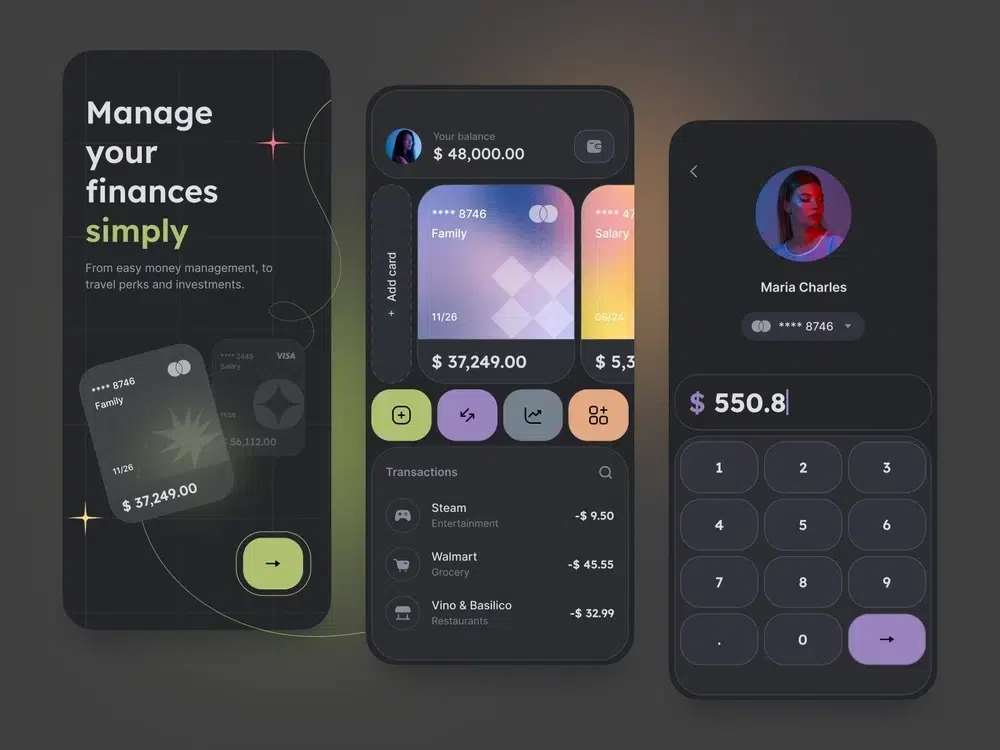
For efficient mobile banking application development, most users (86%) are interested in two features – checking balances and exchanging funds between accounts.
5.1. Essential Features of Mobile Banking
The general Mobile banking app features used in mobile banking development that are hard-to-avoid are as follows:
- Account creation
It is imperative to build a secure and quick authorization process. Multi-factor authentication is a safe sign-in option but takes some time to fill in the necessary information.
Alternatively, biometric authentication using physical user metrics (appearance, voice, even gestures) is far quicker and even fun.
A MasterCard study indicates that users have become more willing to use personal biometrics as their passwords. The Wells Fargo app has a verification feature that scans the iris of their corporate customers.
- Account management
This point may include a range of mobile banking features. Users can check their cards, bank accounts, review account balance and record history, etc.
It is even possible to implement some additional functionality. For instance, the ABN AMRO Bank in the Netherlands included a unique mobile banking feature for personalized account management.
This feature allows users to set a savings goal, create investment plans, and perform repeat payments.
- Customer support
Being able to provide constant support is one of the core mobile banking features, as the client should be able to address a bank representative and ask questions 24/7. Alternatively, it is possible to advance and personalize the user experience by using Artificial Intelligence in a chatbot.
- ATM & bank branch locations
Mobile Banking Application Development should not skip this fundamental feature of mobile banking services. In order to improve the user experience, it is possible to apply VR technology. This is a unique feature of mobile banking implemented by RBC. It allowed the bank to increase the number of its app downloads tremendously.
- Secure payments and transactions
P2P transactions, payments for services, and fund exchanges should be processed securely and conducted anytime and anywhere with the help of a banking app.
An alternative variant of this feature in mobile banking application development is using QR codes for goods and services payments. Scanning QR codes is a fast and easy way to conduct these operations inside the app. Only a few banks have offered this mobile banking feature to their clients.
- Push notifications
Mobile banking application development should utilize reminders and alerts to increase customer engagement and app promotion. It is necessary to control this aspect and plan the communication strategy with your client in advance because most users would not appreciate receiving intrusive notifications.
5.2. Extra Mobile Banking Features
The app features mentioned earlier create the core of mobile banking application development. To increase user traction and interest, you should be thinking about some innovative mobile banking features which might ultimately be the deciding factor of your app likes:
- Spending trackers
Mobile banking development should focus on user needs, even if they are not explicit. This functionality can control personal budgets and set some goals for desired purchases. The system can create a customized dashboard based on user information, give necessary motivation, and inform users regarding progress.
Alternatively, users can set some scheduled payments and bills in advance not to miss an important transaction. This mobile banking feature is utilized in a significant way in the Simple App. The app is used to track spending habits, plan budgets, and save on each expense.
- Cash back service
M-commerce sales increased to 300M in 2017, and the sum is expected to more than double in 2019. Therefore, with the cashback possibility, users are stimulated to use your bank account to pay for services and goods. This small feature or promotion can be an excellent foundation for your loyalty program. Soon, this mobile banking feature will be included in the majority of banking apps.
- Personalized offers
It makes sense to create special offers, discounts, or coupons with a mobile banking app. The opportunity lies in partnering with restaurants, cafes, coffee houses, and so on for the provision of particular discounts or coupons. This feature stimulates sales and, at the same time, engages the user with your mobile banking software.
- Unique services
Mobile banking application development can include other non-traditional services. These services can consist of purchasing tickets, ordering a taxi, reserving a table, delivery, and more.
For example, a Polish bank (Zachodni WBK) reached out to new users with the functionality of paying for public transport, shopping, and taxi-hailing directly from its mobile app.
- App for smartwatches
Smartwatches have begun to substitute smartphones in many operations. Why not consider developing a banking application for these wearables?
The Australian Bank of Melbourne was the first to create a banking app for smartwatches. The functionality included payments for services and goods, receiving notifications, balance checking, and finding ATMs.
- Finance sharing feature
Visa research indicates that to attract Millenials, it makes sense to concentrate on mobile banking application development for budgeting. This mobile banking app may include sharing finances and splitting bills.
For instance, the app from Emirates NBD has a bill-splitting feature where each user has to include some sum and indicate the number of people participating in the operation via social networks.
Final recommendation: It is better to develop a couple of apps with distinct mobile banking features rather than complex software with lots of operations, details, and data. Try to ask your target users about their priorities in banking procedures and focus on providing a solution for them first.
6. Banking Mobile App Development Processes
6.1. Conduct Research And Make A Plan
The preliminary stage is crucial and shouldn’t be skipped at any cost. The first task is to conduct market research. You need to identify your competitors, check alternative solutions on the market, and learn what is popular among the crowd. Without doing this, you may go in the wrong direction.
Once you’ve got the research results, continue with defining your target audience. Your application may be for corporate clients, families, individuals, or institutions. Knowing your clientele will help you find out their pain points, which are crucial for sketching an app toolkit.
In this step, you should make a detailed plan for mobile banking development, including expenditure projections that will become a foundation for your budget.
6.2. Create A Prototype
Every Application starts with an idea in your mind. To turn it into reality, you need to create a sketch or prototype explaining in general terms the structure and order of design elements, visuals, and content. You may start with low-fidelity wireframing to sketch a home screen, users’ accounts, personal dashboards, and the layout for a landing page.
As a rule, wireframes consist of boxes, lines, and texts made in the white and black color scheme. You can use an app wireframe to validate your concept and collect early feedback. Next, you can turn your wireframe into a hi-fi prototype that will include a graphic presentation of a product, layout, interface components, the color scheme, and micro-interactions.
Just like wireframes, use your app prototype to demonstrate its toolkit to your focus group, test functionality, and interface. You can add default texts, placeholders, and test data so that people can feel how your app works.
6.3. Make A Graphic Design
Be ready for hard work in this step as your app’s design is its business card that should be recognizable. There are tons of tips on how to make a perfect mobile banking app design. We have created a shortlist of essential recommendations. Check them below.
- Make sure that typography, icons, color palette, buttons, and forms of your solution match your corporate style and brand;
- The navigation should reflect the logical architecture of your solution;
- All the design elements – buttons, links, forms, icons – should be clear and comprehensive;
- Choose colors, images, video files that evoke certain emotions and feelings;
- Consider cultural differences if you’re going to operate globally;
- Adjust your app to iOS and Android standards to efficiently market it earlier on;
- Your app icon should be unique and make your solution stand out;
- Think about extra bells and whistles like sticker packs for messengers.
6.4. Choose A Technology Stack
When choosing a technology stack for your Mobile Banking App, you should concentrate on four areas: front-end, back-end, cross-platform frameworks, and other prerequisites such as robustness and security. Make a checklist that would include the following criteria
- Project scope, complexity, and scalability;
- The number of specialists and the level of their competence;
- Necessary tools and software;
- Outside solutions;
- Docs and specs.
There are different kinds of applications: native apps, hybrid solutions, cross-platform applications. Each has its pros and cons and unique features. Native apps are robust and demonstrate high performance. They’re ideal for an established business. Native apps allow specialists to use the native functionality of Android and iOS devices without utilizing third-party APIs.
Hybrid apps are developed using web technologies and can be built for different platforms thanks to a unified codebase. Based on HTML, CSS, and JavaScript, hybrid apps can function as progressive web apps.
6.5. Develop And Test
The benefits of Mobile App Testing include optimizing in-app experiences, boosting core metrics, and experimenting with the existing mobile app features in production
The most efficient mobile banking app development path you can choose from is contacting an software outsourcing company. If your idea is brand-new and requires a custom approach, you can’t do it without external help.
The development process allows building a well-thought-out architecture, developing life-like user paths and journeys, creating a user-friendly interface that won’t have analogs, and choosing a technology stack that suits best. The most challenging part is to get a team together, as the quality of work will influence the overall outcome.
6.6. Market Your App And Get Feedback
The most popular app marketplaces – Google Play Market, AppStore, and Microsoft Store – have different requirements for applications you should follow to avoid rejection. In case you opt for an outsourcing team, you can be sure that your off-the-shelf product will adhere to these standards by default.
6.7. Improve And Update
The app launch is just the beginning. To get valuable feedback and learn what to improve and update, ask the mobile audience for feedback, contact app review sources, ask influencers and bloggers to test your product.
If you focus on Apple users, you may submit your application to Apple’s editorial team to get an expert review. Another good idea is to apply your app to Top Apps lists or mobile app awards.
Once you’ve got feedback, you can define the weak and vital aspects of your product and decide how to make it better.
7. Mobile Banking Application Development Cost
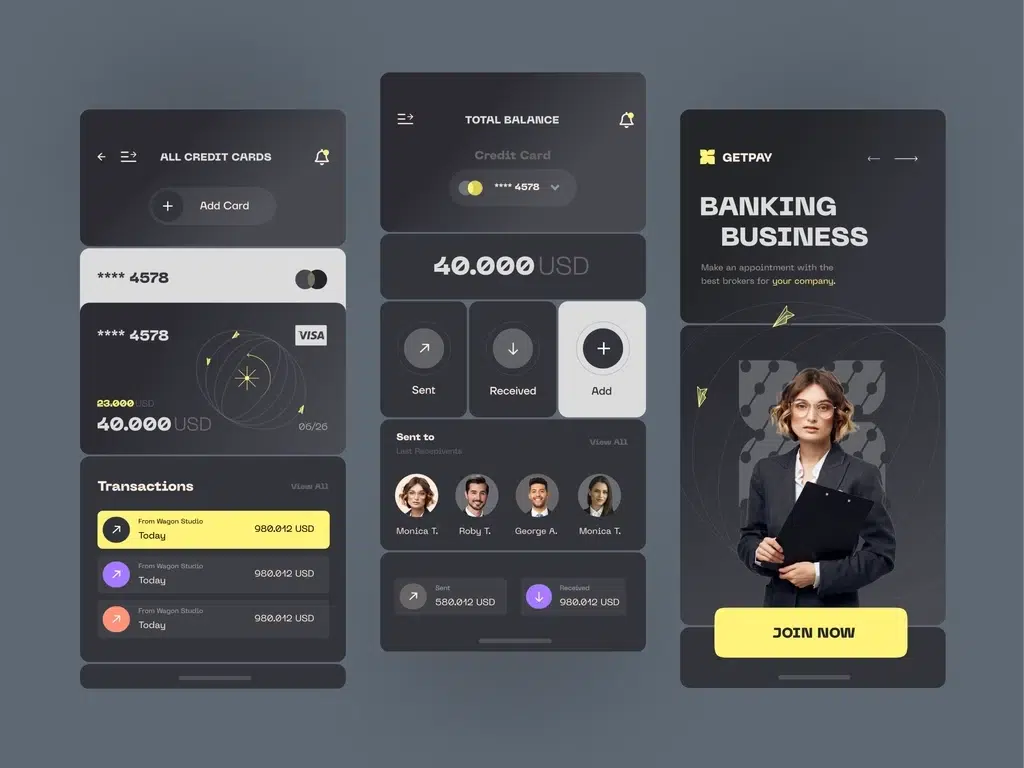
Clutch’s study indicates that the cost of complex solutions, including mobile banking application development, ranges from $200,000 to $500,000
However, the cost of making an app depends on its processes and features. We will give you a rough estimation of how much it will take for you to build a mobile banking application.
You may wonder why banks are investing in mobile banking application development. This is the most efficient method of customer engagement, which definitely outweighs the traditional methods that still involve resellers, support staff, and agents. As well, mobile banking development acts as an effective communication point with the possibility to get up-to-date market insights and improve banking services.
7.1. Discovery
We conduct a thorough business analysis to determine how the app will work in detail, what users can do, and whether third-party services are required.
What you get: functional specification with user flows, diagrams, and wireframes.
Cost: USD 2,400 – 3,200.
7.2. UI/UX Design
Based on the user flows and features we determine during the discovery stage, we’ll come up with user experience design to make sure we’ve covered all the business requirements and user needs at the same time. Then we’ll produce a user interface design of the app that includes the visual representation.
What you get: high-fidelity prototypes ready for implementation, along with a style guide.
Cost: USD 16,800 – 24,800.
Looking For a Dedicated Team?
A Dedicated Team might be the best solution in your case. Get in touch with us and we’ll help you choose the best IT outsourcing model based on your business needs and requirements.
7.3. Web Development
Mobile apps require administration and it’s usually a web-based admin dashboard.
What you get: a user-friendly admin back-office with functionality to manage the mobile app.
Cost: USD 135,000 – 153,000.
7.4. Mobile Development
We develop an API to communicate with the server-based app developed in Phase 3.1 and put all things together: design, functionality, API.
What you get: a fully-working app ready to upload on Google Play Market or AppStore.
Cost: USD 45,000 – 64,000.
In general, mobile banking development and all mobile app development services can be split into two stages, Discovery and Development. The discovery stage includes all the preparatory work for the project performed by a business analyst, who is responsible for the development of your app from a business perspective, and a software architect, who aligns business aspects with technical implementation.
8. How to Create a Mobile Banking App Project Successfully
It is absolutely certain that the banking sector will only become more and more digital. Mobile banking application development allows the industry to increase efficiency in operations, reduce bureaucracy, and enhance customer experience while promoting banking services. So what makes a good banking application?
Applicable and user-friendly functionality that is secure and easy to access. These can include, but may not be limited to:
- Checking the account balance without login
- Integrations with device info and tools (e.g. address book)
- User customization based on recent actions and regular transactions
- Customizable offers
- Creation of personalized and useful notifications
Application of advanced, innovative technologies like AI, Big Data, AR, VR, and Blockchain to enhance the user experience
Adding new functionality and scale software in accordance with upcoming mobile banking trends, namely:
- Use of voice user interface (VUI) to increase customer engagement
- Use of artificial intelligence and machine learning for self-service in banking industry
- Use of advanced verification technology with biometrics to avoid data breaches
All this shows that mobile banking application development offers many opportunities to create a customer-centric experience in the banking sphere. This niche still has room for useful banking apps, so it is time to plan yours today.
Savvycom – Your Trusted Tech Partner
Since 2009, Savvycom has been harnessing the potential of digital technologies to support business growth across diverse industries. Specializing in tech consulting, end-to-end product development as a software outsourcing company, we offer high-quality software solutions and products. Our expertise also extends to providing a wide range of professional software development services tailored to meet your unique needs.
Savvycom is right where you need. Contact us now for further consultation:
- Phone: +84 24 3202 9222
- Hotline: +84 352 287 866 (VN)
- Email: contact@savvycomsoftware.com
What are The Advantages of Mobile Banking App Development?
- Users love banking apps because they're convenient, secure, and have tons of valuable features, making it easy to access a personal bank account at any time, from anywhere.
- For Banks, having a mobile app means lowering staff expenses and operational costs and even going paperless and thus environmentally friendly.
What Features to Include in a Mobile Banking App?
The core features most banking apps share:
- Account creation & account management
- Payments and transactions
- Bill payments
- Push notifications
- Personal manager/customer support
Nice-to-have features:
- ATM & bank branch locations
- Spending trackers
- QR code scanner
- Cashback service
- Money converter
- Apps for smartwatches
Best Technology Stack For Mobile Banking App Development
Teamwork makes the dream work! That's why having the right team with the suitable Technology Stack often results in an App that could last for a long time. But are you sure? You already have the right Tech Stack. Here are the tools and technologies we at Savvycom recommend for Mobile Banking App Development.
Native App Development
If you create a banking app solely for iOS or Android, you should opt for native app development. Regarding iOS-based mobile banking software solutions, the best technology includes Swift, XCode, and iOS SDK. If we're talking about Android-based mobile banking development, then Java, Kotlin, Android Studio, and SDK are the tools of choice.
Cross-platform App Development
Cross-platform app development is a winning approach that allows banking app developers to use a single code base for different operating systems. React Native, Flutter, and Xamarin will aid in building cross-platform apps.
Hybrid App Development
Hybrid mobile apps blend native mobile app development and web development. They are usually built using HTML5, CSS, JavaScript, etc.
Another Step-by-Step Guide on Mobile Banking Development
- Step 1: Conduct research and make plan
- Step 2: Build and verify prototype
- Step 3: Lay the groundwork for security
- Step 4: UI/UX Design
- Step 5: Choose Technology Stack
- Step 6: App Coding
- Step 7: Integrate with third-party solutions
- Step 8: Release and maintain
- Step 9: Market your app and get feedback
- Step 10: Improve and update
How Much Does Mobile App Development Cost
The cost of mobile app development can vary widely depending on several factors, including the complexity of the app, features, platform (iOS, Android, or both), design, and the development team's location and expertise.
Simple apps with basic functionality might cost anywhere from $5,000 to $20,000, while more complex apps with advanced features can range from $20,000 to $150,000 or more. High-end, sophisticated apps, such as those with complex functionalities, extensive backend systems, and high-quality design, can exceed $150,000.
It's important to note that these are rough estimates, and costs can vary significantly based on individual project requirements and the development team's rates. Additionally, ongoing maintenance and updates may incur additional expenses after the initial development.
Yet, understanding blockchain technology can be daunting, even for those well-versed in technical concepts. This perceived complexity often deters individuals from exploring or transitioning into blockchain development. However, the reality is that blockchain technology is more accessible than commonly believed. In this article, we’ll unravel the mysteries surrounding blockchain technology and development, catering to all levels of expertise. Keep reading to discover insights on career paths, job requirements, and frequently asked questions.
Understanding Blockchain Technology
Exploring the world of blockchain technology is crucial to fully comprehend its far-reaching effects across different industries, spanning from finance to supply chain management and more. This introduction serves as a starting point to delve into the basics of blockchain, uncovering its core concepts, practical uses, and the significant influence it wields in revolutionizing conventional methods and operations.
What is Blockchain?
Basically, Blockchain is a technology that fundamentally transforms how we handle data security and management. Unlike the traditional centralized databases we’re accustomed to, blockchain operates on a decentralized model, spreading data across a vast network of servers known as nodes. This ingenious design makes it exceedingly challenging for any single entity to tamper with or deceive the system.
Every transaction, which we refer to as a ‘block’, is meticulously recorded and replicated across all nodes within the network. This meticulous duplication ensures that every piece of data remains consistent and secure at all times. By embracing this decentralized approach, blockchain not only enhances resilience but also promotes transparency in transaction recording, offering a dependable alternative to the conventional methods we’ve relied on for so long.
In addition, blockchain offers real-time updates and a unified ledger view, establishing itself as a reliable source for every transaction. This isn’t just about data perception; it’s paving the way for a digitally secure future.
Blockchain market overview
The blockchain market is booming, surpassing its initial ties with cryptocurrencies to establish itself as a pivotal technology across diverse sectors. Valued at USD 12.3 billion in 2023, it’s anticipated to maintain an impressive Compound Annual Growth Rate (CAGR) of 57% from 2023 to 2030.
This remarkable growth stems from blockchain’s unmatched capacity to facilitate secure and transparent transactions, attracting attention from fields spanning finance to healthcare and beyond. As various industries acknowledge blockchain’s potential for tasks like supply chain management and voting systems, its market is poised to revolutionize how data integrity and security are upheld in our increasingly digitized world.
What is Blockchain Development?
Blockchain application development is the craft of constructing a secure, unchangeable network of digital transactions and asset monitoring. It involves creating a Distributed Ledger Technology (DLT) that serves as the foundation of blockchain’s integrity. This technology isn’t just a safe repository for cryptocurrencies; it’s a versatile tool swiftly demonstrating its value across diverse industries.
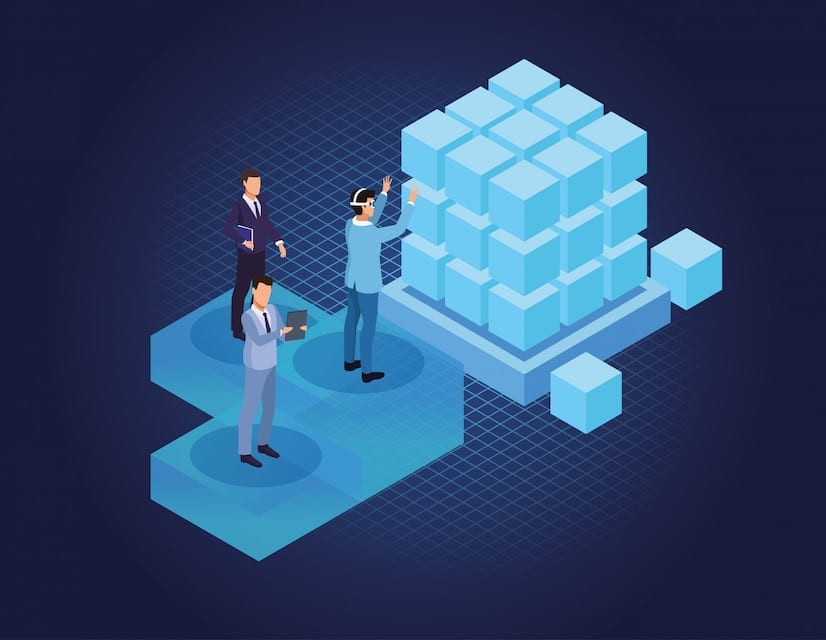
Exploring the essence of Blockchain Development
From finance to healthcare, blockchain development is transforming how we exchange information—quickly, accurately, and without compromising security. It revolves around constructing a network where transactions are transparent, and every participant has a clear view of the ledger. grasping blockchain’s concept marks the initial stride toward unlocking its full potential, heralding a future where digital transactions are as dependable as they are groundbreaking.
Types of Blockchain
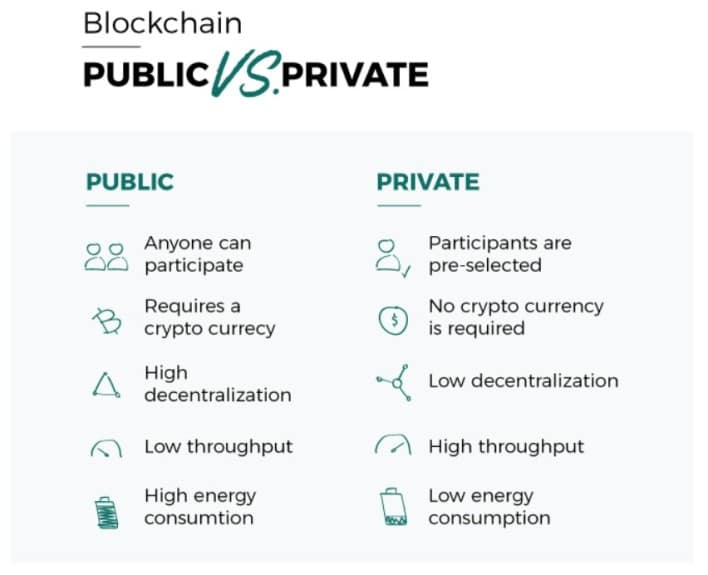
Quick comparison of public and private blockchains – Image source: Zigurat
In the previous section, we got a quick overview of Blockchain – what it is, how it functions, and its market significance. Now, let’s delve deeper into the various types of Blockchain and explore the professions that utilize them.
Public
Public blockchains embody the concept of decentralization, providing an inclusive network where trust is distributed among all participants. In this digital democracy, anyone with internet access can freely join and participate without needing permission. The structure of public blockchains ensures that no single entity holds control, and every transaction is openly visible to all network nodes. This concept was pioneered by the Bitcoin network, where each transaction is publicly accessible through a block explorer.
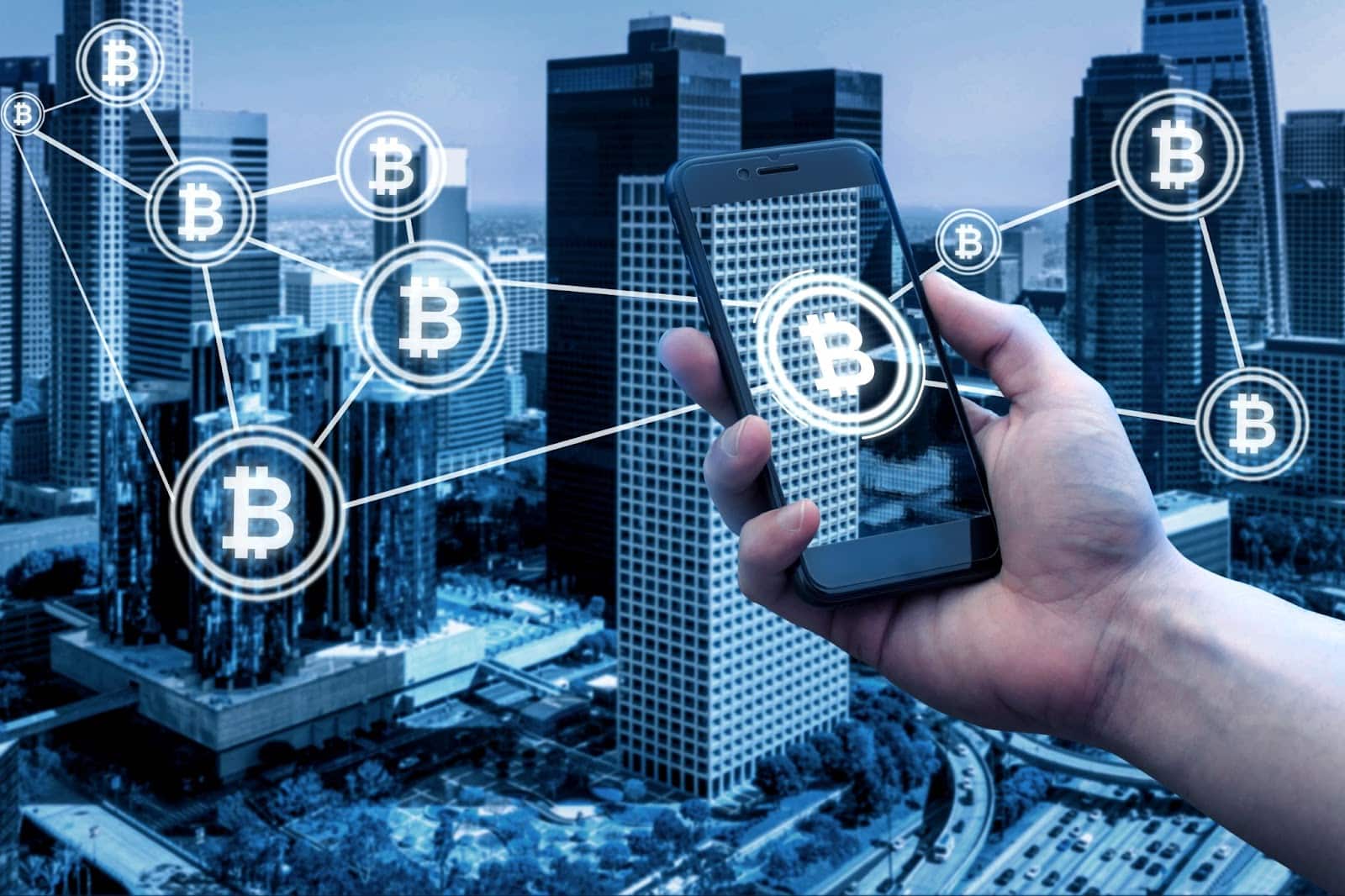
Bitcoin and blockchain are closely linked
While public blockchains reward participants with cryptocurrency for validating blocks and may impose fees for transactions, they offer only limited privacy. To maintain transactional privacy, users should share their public key solely with transaction counterparts. It’s this blend of openness and security that makes public blockchains a transformative force in the digital realm.
Private
Private blockchains, another type of blockchain, are controlled either by a single entity or a consortium of multiple entities. They offer a more restricted network environment compared to public blockchains. These networks rely on trust among known participants, ensuring that sensitive information is accessible only to those who are part of the network.
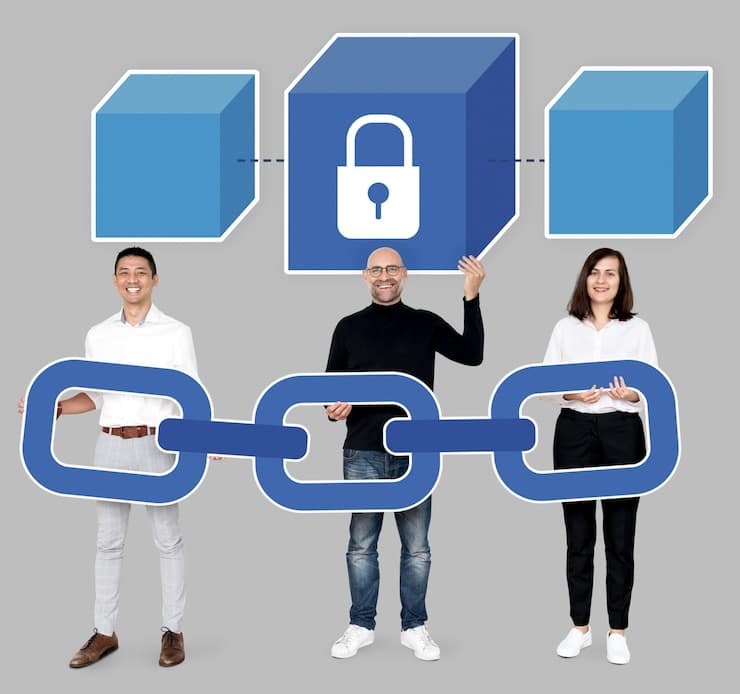
Blockchain Private Enhances Confidentiality: Leveraging Unparalleled Data Privacy and Security
In a consortium blockchain, authority is shared among pre-selected entities that work together in the network’s best interest. This arrangement maintains both privacy and a degree of decentralized governance. It’s particularly suitable for situations where transaction privacy is crucial.
For example, while all parties involved may be aware that a product has been shipped, the specific details of the shipment can remain confidential between those involved. This level of privacy is essential, especially when multiple competing entities are part of the same network. It enables them to carry out transactions without exposing sensitive data to others.
Blockchain protocols
Blockchain protocols serve as the cornerstone of the digital ledger landscape, establishing guidelines for data exchange and verification. Among these protocols, Bitcoin stands out as a pioneer tailored for cryptocurrency transactions, facilitating secure transfers of value without the need for trust between parties.
In contrast, Ethereum introduces a more expansive approach with its versatile protocol, enabling the execution of smart contracts that imbue transactions with layers of logic and code.
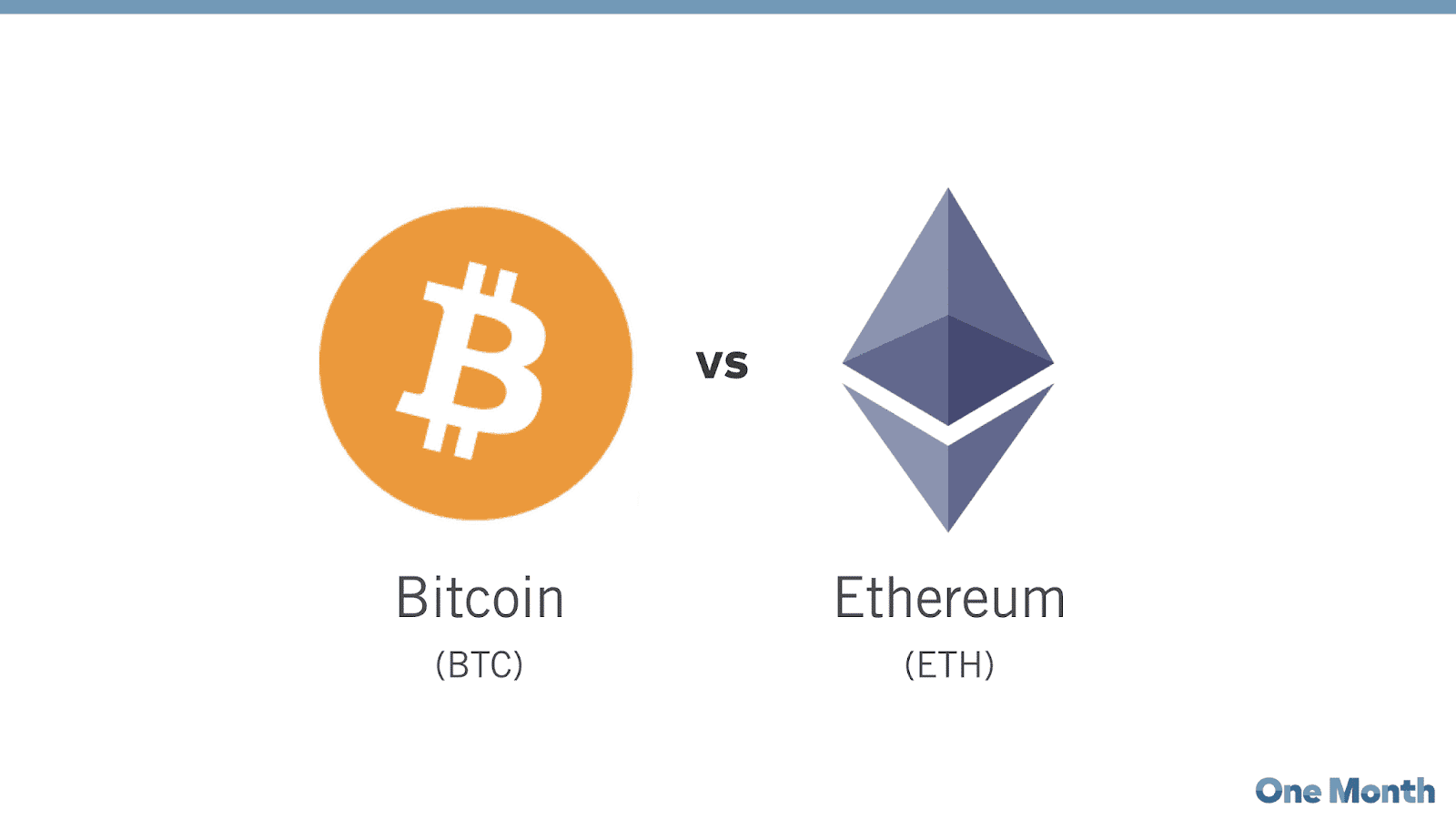
Cryptocurrency (Bitcoin) operates on its own blockchain network, while Ethereum (Token) offers greater flexibility – Image source: One Month
For those looking to leverage the potential of blockchain technology, protocols such as Ethereum and Hyperledger Fabric offer adaptable foundations. These programmable blockchains can accommodate diverse use cases by integrating business logic and state information into smart contracts. As a result, they open the door to a wide range of applications beyond simple value transfers.
Blockchain Application in Different Industries
As technology continues to advance swiftly, and with new possibilities for blockchain applications still unfolding in 2024, the list below offers some common examples of its use cases. While not exhaustive, it serves as a starting point to understand the potential of blockchain. For a deeper exploration into specific industry applications of blockchain, we invite you to explore our dedicated blog post on blockchain development use cases across various sectors.
Healthcare
In healthcare, blockchain technology is changing how patient records and pharmaceuticals are handled. By establishing a secure and unchangeable ledger for patient data, it boosts confidence in medical information systems. Its capacity to track drugs from manufacturing to distribution is pivotal in fighting counterfeit medications, guaranteeing patients get authentic products.

Blockchain technology’s application in healthcare offers substantial improvements over traditional methods, addressing various challenges effectively
As blockchain becomes more integrated into healthcare, it offers a promising future where patient care and pharmaceutical reliability are greatly enhanced in the digital healthcare realm.
Real estate

Benefits of applying Blockchain technology in real estate
For the realm of real estate, blockchain emerges as a game-changer, simplifying property transactions and notably curbing fraud. This innovative technology ensures the secure recording of property titles, accelerates ownership transfers, and introduces unprecedented transparency to the entire process.
Finance
We can envision that cryptocurrencies (like Bitcoin) and tokens (like Ethereum) are among the most well-known use cases of blockchain technology.
And in this finance, blockchain is driving innovation, enabling faster, cheaper, and safer payments. It revolutionizes international money transfers, surpassing traditional banking methods in both speed and cost-effectiveness. Furthermore, Decentralized Finance (DeFi) expands blockchain’s impact by providing services such as lending, borrowing, and trading directly on the blockchain, eliminating the need for traditional financial intermediaries. This transformation marks a new era in finance, where transactions are not only swifter and more economical but also more transparent and accessible.
Voting
Blockchain’s utilization in voting stands as a ray of hope for upholding electoral integrity. By registering votes on a decentralized ledger, blockchain guarantees that every vote is encrypted, traceable, and irreversible, ensuring transparency and security in the election process. This technology not only discourages manipulation but also strengthens the legitimacy of democracy itself.

Harnessing Blockchain for Voting Ensures Transparency, Security, and Inclusivity, Reinventing the Electoral Process for the Digital Age
Moreover, numerous instances worldwide showcase blockchain’s application in voting. For instance, the 2018 federal elections in West Virginia, USA, witnessed voting on the Voatz platform, which operates solely on blockchain technology. The platform employs a three-step voter authentication process, including fingerprint recognition, a live photo, and a one-phone, one-vote system, ensuring both security and integrity. Another notable example is Zcoin, utilized for a primary election in Thailand, where over 127,000 votes were cast.
Supply chain
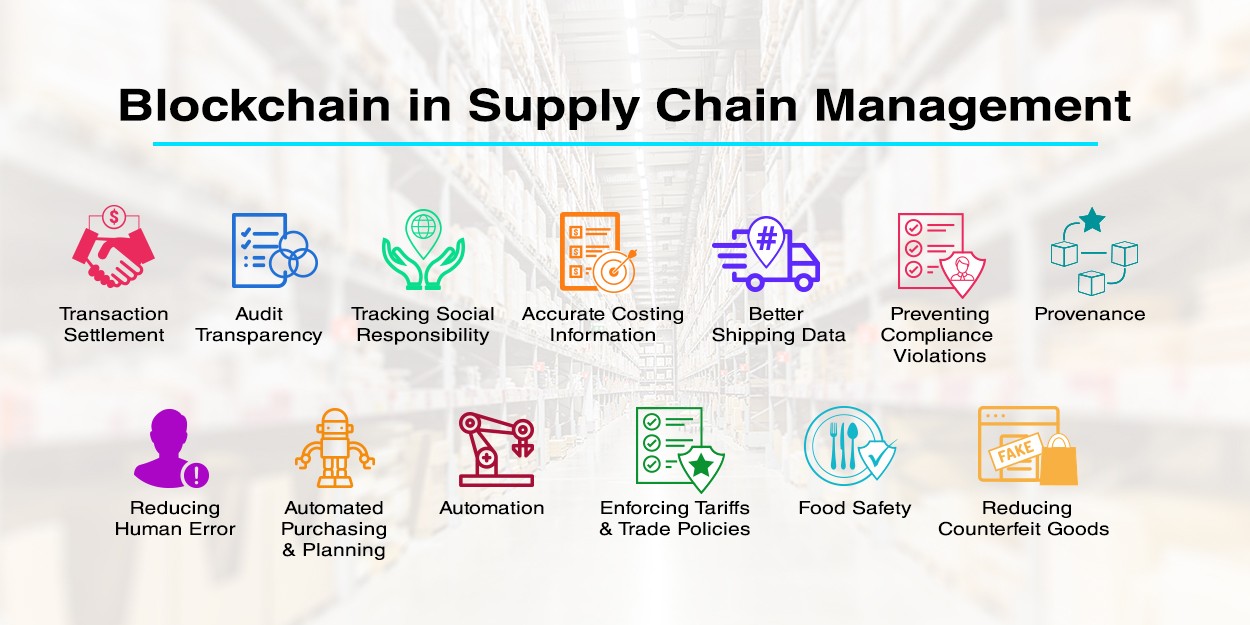
How Blockchain Transforms Supply Chain Management – Image Source: 3i Infotech
Blockchain is transforming supply chain management by improving transparency and traceability from the manufacturer to the consumer. Acting as a distributed ledger, blockchain documents every stage in the production, shipment, and receipt of products, creating an unalterable record that all stakeholders can rely on. This transparency is crucial in preventing counterfeit products from entering the market, guaranteeing consumers receive genuine goods.
Moreover, the incorporation of technologies like the Internet of Things (IoT) and smart contracts further simplifies the process, cementing blockchain as an essential tool in contemporary supply chain strategies.
Pros And Cons Of Blockchain Development
In the following section, we will assess the advantages and disadvantages of blockchain development. Our aim is to provide a fair evaluation to help you comprehend both the benefits and drawbacks of engaging in blockchain development.
Pros of Blockchain Development
Below are the 4 biggest advantages of blockchain development.
Better Transparency and Immutability
Blockchain’s architecture brings forth a new era characterized by transparency and immutability. In this system, every transaction is visible to all network participants and securely recorded. Once data is on the blockchain, altering it becomes exceedingly challenging, as it would require changing every subsequent block—a Herculean task due to the network’s consensus mechanism.
This shared and time-stamped documentation eliminates traditional vulnerabilities to fraud and corruption, as no central authority can unilaterally modify records. Consequently, trust is inherently embedded in the system, laying a solid foundation for secure and transparent digital interactions. Essentially, once data is recorded on the blockchain, it remains unalterable without changing all subsequent blocks, ensuring the utmost trust and security in the digital landscape.
Easy Integration With Existing Systems
Blockchain’s versatility is evident in its capacity to seamlessly integrate with existing business systems, bolstering not only security but also operational efficiency. This harmonious fusion can manifest in various forms, such as an application platform or Blockchain-as-a-Service (BaaS).
The former entails investing in the development of a platform to harness decentralized technology, whereas the latter offers businesses a direct conduit to blockchain networks. BaaS emerges as an especially advantageous option for businesses of all sizes, furnishing them with greater autonomy over their blockchain-related endeavors. Equipped with tools like Logic Apps and REST-based APIs, the integration process is streamlined, facilitating a seamless transition that complements and reinforces current systems.
Low Operational Cost
Blockchain development technology significantly reduces overhead costs by eliminating the necessity for centralized servers or intermediaries to conduct operations. Through the optimization of data management and transaction processes, it eradicates the requirement for intermediaries, decreases paperwork, and diminishes errors, resulting in substantial cost savings for businesses.
Easy Traceability
Traceability in modern supply chain management has undergone a revolutionary transformation, driven by the emergence of distributed ledger technology. Through the utilization of distributed ledger technology, each transaction is meticulously recorded on a decentralized ledger, establishing an unalterable audit trail. This meticulous documentation ensures transparency and traceability across every stage of the supply chain journey, from production through to delivery.
Unlike traditional databases, the immutable nature of this record-keeping simplifies the process of identifying and addressing discrepancies, making it an indispensable tool for optimizing efficiency and accountability within supply chains.
Cons Of Blockchain Development
Here are the 2 primary drawbacks of blockchain development.
Scalability
Scalability remains a significant challenge in blockchain technology. With the increasing demand for blockchain applications, networks like Bitcoin and Ethereum encounter congestion, causing slower transaction times and higher costs. The main issue stems from the limited capacity of each block, which is fixed at 1 MB in size, resulting in the inability to accommodate a large number of transactions.
This bottleneck poses a major obstacle for blockchain networks aiming to handle higher transaction volumes and gain wider adoption. To tackle this challenge, innovative solutions such as Layer 2 protocols and alternative consensus mechanisms are under development. These solutions aim to improve blockchain performance and efficiency, paving the way for smoother and more scalable operations.
Transaction Delays
Transaction delays pose a significant hurdle in blockchain technology. Unlike regular databases, blockchain relies on miners to verify transactions using intricate puzzles. While this method enhances security, it often leads to confirmation times lasting several hours, much longer than traditional payment systems. These delays worsen during network congestion, when a surge in transactions and more users strain the system, causing longer wait times and higher fees. This built-in delay emphasizes the importance of continuous improvements in blockchain infrastructure.
Looking For a Dedicated Team?
Looking to strengthen your manufacturing operations with state-of-the-art Blockchain technology? Look no further than Savvycom! With over 15 years of expertise in IT development, Savvycom specializes in providing customized Blockchain solutions to cater to the unique needs of your industry. Partner with us for expert Blockchain consulting, as Asia’s premier software outsourcing firm, and harness the power of innovative technology to streamline and secure your manufacturing processes. Let’s collaborate to enhance your operational efficiency and propel your business to new heights of success!
How To Become A Blockchain Developer

Key points to consider on your journey to becoming a blockchain developer – Image source: Moralis
So, with all these responsibilities, the question arises: how can we equip individuals with the skills needed to meet the challenges of blockchain development? Well, there are aspiring blockchain enthusiasts who are starting from square one, with no prior programming experience. Here are some key points to keep in mind if you’re aiming to become a blockchain developer.
Types of blockchain developers
- Front-End Developers: Think of them as the architects of the user experience. They craft the look and feel of blockchain applications, making them easy to use and navigate for everyday users.
- Back-End Developers: These are the behind-the-scenes wizards. They work on the server-side of things, ensuring that data flows smoothly and transactions are securely processed within the blockchain infrastructure.
- Full-Stack Developers: Picture them as the all-rounders. They possess a diverse skill set, seamlessly blending front-end and back-end expertise to create holistic blockchain solutions.
Understanding the Fundamentals of Blockchain
Understanding blockchain basics is essential for those interested in exploring this groundbreaking technology. At its core, blockchain operates on principles of decentralization and consensus, building trust within the network.
To grasp this concept, it’s vital to understand that blockchain acts as a distributed ledger, securely storing data in blocks. These blocks are linked together, creating an unchangeable ledger managed by a decentralized network.
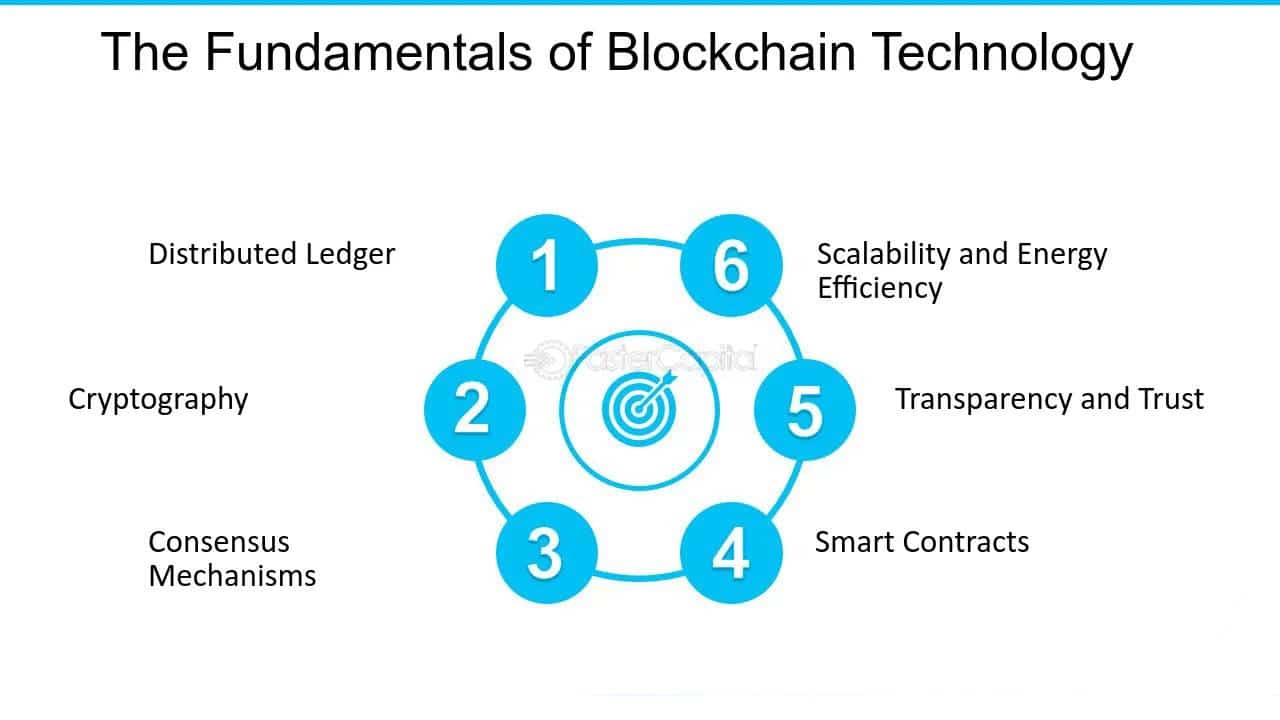
Understanding the fundamentals of blockchain technology is crucial when delving into this niche – Image source: Fastercapital
Blockchain is defined by its distributed, unchangeable, and decentralized structure, with each block containing a set of transactions. In summary, comprehending blockchain involves understanding decentralization, distributed ledgers, consensus mechanisms, smart contracts, and immutability.
Learning Essential Skills
Learning essential skills for blockchain developers is crucial for success in this rapidly evolving field. Firstly, mastering blockchain programming languages such as JavaScript, Python, and Go is essential for developing efficient blockchain applications capable of handling vast amounts of data and transactions.
Secondly, understanding cryptography and security protocols like hash functions and digital signatures is paramount to ensure data integrity and privacy. Additionally, proficiency in designing, developing, and testing smart contracts and DApps is necessary to automate processes securely and transparently.
Lastly, familiarity with networking and consensus algorithms like proof-of-work and proof-of-stake ensures transactions’ validity across the blockchain network. By acquiring these skills, blockchain developers can navigate the complexities of the decentralized ecosystem effectively and contribute to its advancement.
Blockchain Development Companies
If you have a blockchain project on the horizon, we’re eager to connect with you and guide you towards the best decisions. Savvycom, a software development company based in Vietnam, the US, and AU, brings over 15 years of experience, including expertise in blockchain technology.
With Savvycom’s blockchain development services, you can benefit from cost savings, enhanced flexibility, and access to high-quality tech talent. Our nearshore IT outsourcing solutions in APAC and the US, facilitated by strong partnerships, ensure seamless collaboration and top-notch results.

Explore Blockchain related categories provided by Savvycom
Learn more about our blockchain solutions and how they can align with your project needs by exploring our offerings further.
Final Thoughts
Blockchain development isn’t merely a passing trend; it represents a significant technological paradigm shift that is reshaping the landscape of digital transactions and data security. Whether you’re a developer aiming to specialize in blockchain or a business contemplating its integration, the opportunities are abundant and ready for exploration. As the blockchain ecosystem evolves, maintaining awareness and adaptability is crucial for harnessing its complete capabilities. We trust that our article will provide you with a clear understanding of what blockchain development entails. Best of luck on your journey!
Savvycom – Your Trusted Tech Partner!
Transforming Manufacturing with Cutting-Edge Blockchain Solutions with Savvycom, Asia’s Premier Software Outsourcing Provider, has been leading digital innovation since 2009. Drawing on our extensive experience, we specialize in developing cutting-edge Blockchain solutions customized to your requirements. Whether it’s supply chain optimization, smart contracts, or decentralized applications, we offer comprehensive solutions to revolutionize manufacturing processes. Partner with us to harness the power of Blockchain technology and drive innovation in your industry.
Savvycom is right where you need. Contact us now for further consultation:
- Phone: +84 24 3202 9222
- Hotline: +84 352 287 866 (VN)
- Email: contact@savvycomsoftware.com
Frequently Asked Questions
What do you need for blockchain development?
To get started as a blockchain developer, you’ll require a solid grasp of programming languages such as Solidity, Java, or C++. Understanding data structures and algorithms is also key, along with familiarity with blockchain platforms like Ethereum or Hyperledger. Additionally, you’ll need to dive into cryptography, smart contracts, and decentralized applications (dApps).
Why are blockchain developers needed?
Blockchain developers are indispensable in crafting, executing, and upkeeping blockchain systems. They are instrumental in establishing secure and transparent networks that facilitate a myriad of applications, spanning from cryptocurrencies to supply chain management. Their expertise ensures the effectiveness, security, and operability of blockchain technology.
How hard is blockchain development?
Delving into blockchain development can be intricate due to its complexity and the requisite understanding of decentralized systems, cryptography, and consensus mechanisms. Nonetheless, with commitment and access to appropriate resources, budding developers can grasp these concepts and attain the essential skills. Similar to any specialized field, staying abreast of evolving technologies demands continuous learning and adaptability.
]]>Despite traditional banking methods having a centuries-long history, cryptocurrency represents a relatively new concept that has gained considerable momentum over the past decade. Here’s how cryptocurrencies might influence the banking industry, particularly in the realm of software development services.

Photo by Kanchanara on Unsplash
Limited Obstacles to Entry
Cryptocurrencies provide a more accessible entry point, necessitating only a smartphone or internet connectivity, as opposed to the requirements of traditional banking services. This implies that individuals excluded from conventional banking services due to economic or geographical limitations can still participate in cryptocurrency. For instance, an individual in a remote region lacking bank facilities can employ cryptocurrencies for BTC to USD transactions, eliminating the need for extensive travel.
From Centralized to Decentralized Finance
Traditional banking systems have dominated the financial industry for centuries. These centralized systems rely on a network of intermediaries to facilitate transactions, manage risk, and ensure financial stability. However, the presence of cryptocurrency causes a fundamentally different approach: decentralized finance (DeFi).
Cryptocurrencies operate on blockchains, distributed ledgers that record transactions across a vast network of computers. This erases the need for central authorities, creating a more open and transparent financial system.
Speed and Efficiency
Traditional bank transfers can be slow and troublesome. International transactions, for instance, may take several days to settle due to the complex network of intermediaries involved. Cryptocurrency transactions, on the other hand, can be completed near-instantaneously and at a significantly lower cost thanks to the peer-to-peer nature of blockchain technology.
This efficiency could revolutionize cross-border payments, making it easier for businesses and individuals to conduct international transactions. Imagine a future where sending money to family overseas happens as quickly and effortlessly as sending a text message.
Systems for Clearance and Settlement
The three-day duration for an average bank transfer, as previously mentioned, is largely attributed to the design of our financial infrastructure. This process isn’t only inconvenient for the customer and poses a massive logistical challenge for the banks. Today, a basic bank transfer (moving funds from one account to another) must navigate a complex network of middlemen.
This includes correspondent banks and custodial services before it finally arrives at its intended destination. The two bank balances must be reconciled across a vast global financial system comprising a diverse network of traders, funds, and asset managers.
Accessibility and Financial Inclusion
Cryptocurrency has a lower barrier to entry than traditional banks. Opening a bank account frequently involves considerable documentation, a minimum balance, and physical proximity to a branch. This may exclude a large segment of the global population, particularly those in developing nations with limited access to traditional financial services.
Cryptocurrency wallets, on the other hand, may be made with only a smartphone and an internet connection. This allows the unbanked and underbanked communities to engage in the financial system, possibly increasing financial inclusion and economic empowerment.
Fundraising
Securing funding through venture capital can be a grueling task. Entrepreneurs must compile presentations, attend countless meetings with partners, and undergo extensive negotiations over equity and company worth to trade a part of their business for financial investment.
Conversely, some firms are sourcing capital through initial coin offerings (ICOs), facilitated by public blockchains like Ethereum and Bitcoin. Projects trade tokens or coins for funding in an ICO, usually as bitcoin or ether. Theoretically, the value of these tokens is linked to the success of the blockchain enterprise. Investing in tokens offers investors a direct way to gamble on usage and value.
Securities
Buying or selling assets such as stocks, debt, and commodities necessitates a system to track ownership. The current financial markets achieve this via:
- A convoluted network of brokers
- Exchanges
- Central security depositories
- Clearing houses
- Custodian banks
These various entities operate within an archaic system of inefficient paper ownership and prone to errors and deceit. For instance, if you decide to buy a share of Apple stock, you would likely place an order through a stock exchange, which then pairs you with a seller. In the past, this transaction would involve handing over cash for a physical certificate indicating your share ownership.
However, things become significantly more complex when attempting to carry out these transactions electronically. The day-to-day management of assets (such as swapping certificates, keeping books, or handling dividends) is something we prefer to avoid.
As a result, we entrust our shares to custodian banks for secure storage. But, because not all buyers and sellers use the same custodian banks, these custodians must depend on a trustworthy third party to safeguard all the physical certificates.
Challenges and Considerations
While cryptocurrency presents a compelling vision for the future of finance, there are significant challenges to overcome:
- Volatility: Cryptocurrency markets are notoriously volatile, making them a risky investment for some.
- Regulation: The regulatory environment surrounding cryptocurrency is still in its early stages. Clear and consistent regulations are needed to protect consumers and prevent illegal activities.
- Scalability: Current blockchain technologies may struggle to handle large volumes of transactions. Scaling solutions are being developed, but their effectiveness remains to be seen.
- Energy Consumption: Proof-of-work, the consensus mechanism used by some blockchains, consumes a significant amount of energy. Sustainable alternatives are needed for wider adoption.
Endnote
Although the emergence of cryptocurrencies is definitely disruptive, traditional banking does not have to disappear as a result. The two industries might work together in the future. Blockchain technology might be incorporated by banks to provide quicker and more effective services. Companies that deal in cryptocurrencies and banks might collaborate to offer custodial services and guarantee legal compliance.
In the end, a hybrid financial model that incorporates the best features of cryptocurrencies and conventional banks may hold the key to the future of finance. We may anticipate seeing a more connected financial system that is more inclusive, efficient, and secure as rules become clearer and technology advances.
The emergence and growth of digital currencies have marked a notable shift in the financial landscape over the last ten years, characterized by an upsurge in market values. This surge in digital currency usage can be attributed to a heightened interest in decentralized systems, an escalating acknowledgment of these currencies as a viable store of wealth and medium of exchange, and an expanding acceptance amongst both private individuals and commercial entities.
Since 2009, Savvycom, a software development company, has been utilizing digital technologies to support businesses, mid to large enterprises, and startups across various industries. Specializing in Tech Consulting, End-to-End Product Development, Cloud & DevOps Services, we excel in creating top-notch software solutions and products, alongside offering a diverse array of associated professional services.
Savvycom is right where you need. Contact us now for further consultation:
- Phone: +84 24 3202 9222
- Hotline: +1 408 663 8600 (US); +612 8006 1349 (AUS); +84 32 675 2886 (VN)
- Email: contact@savvycomsoftware.com
]]>
If you’re reading this guide, chances are you’re a company looking to enter the space. You’ve come to the right place! We’ve created this guide to provide you with all the information you need to succeed with your model.

Financial Software Development
The Rise Of Financial Software Development
Financial software development involves creating solutions that improve digital transaction security, optimization, and simplification. This field has become highly profitable and is essential for modern entrepreneurs who aim to manage their finances efficiently.
It is expected that the global finance market will reach a value of around $234 billion by 2026. This growth is attributed to several factors, such as digital finance, mobile apps, customer convenience, and emerging technologies.
1. The growth of digital finance
The utilization of digital cash is becoming increasingly widespread, with not only millennials and Gen Z but also earlier generations embracing its convenience. Modern technology has made it possible for anyone to manage financial transactions with ease, whether it’s paying bills, transferring funds, or obtaining loans, all accessible through a mobile device.
2. Huge mobile app space
FinTech has become increasingly popular with the emergence of FinTech companies and banks providing mobile apps. Consumers can use their mobile devices as digital wallets to easily store and conduct transactions. Additionally, mobile devices serve as a crucial tool for tracking past and future spending.
3. Priority for customer convenience
Many customers are now turning towards the new bank and FinTech options and relying on modern financial service providers for help instead of sticking to traditional banking systems. This change in habit is happening alongside the emergence of financial software that offers users greater convenience.
4. Impact of innovative technologies
Although new companies have tackled some of the issues in FinTech, there is still a lot of room for innovation. It’s important to note that not every outdated banking process has a corresponding app or program, and new use cases are constantly arising. It’s hard to believe that virtual currencies could eventually be more profitable than traditional fiat money, but the potential for creating new business models in FinTech is truly limitless.
2. Types Of Fintech Apps
In order to understand the fundamentals and select the best fintech app type for your company, let’s look at the most popular financial software development categories.
Banking Apps
During pandemic restrictions, the use of banking applications surged since they allowed users to transact money securely and contactless. It acts as a conduit between customers and banks, opening up financial services to anyone with a smartphone and a reliable internet connection.
To begin using these apps, users must first download the relevant app from the app store. Once installed, customers can access various functions, such as paying bills, making reservations, viewing account balances, and more.
Benefits:
- Better finance control
- Instant money transfer
- 24/7 access to banking services & support
- Improved data security
Lending platforms
Customers are growing interested in the ability to apply for loans and obtain funding without physically visiting a bank. A money lending platform is the solution, accelerating the loan application process.
Utilizing digital lending platforms to swiftly find and assess new borrowers can help banks reduce costs and enhance back-office operations. As a result, lending platforms assist financial institutions in overcoming these challenges by serving as a central hub for managing every step of the loan process for each individual consumer.
Benefits:
- Reduce costs for the lending process
- Enhance the overall operation
- Faster closes loans
- Build deep client relationships
Customer finance
A user’s budget can be greatly improved with specialized personal finance software. This application simplifies the management of financial affairs and provides clients with speedy and efficient financial services.
The consumer financial software development supports customers with monitoring, budgeting, accounting, and cost tracking while also providing vital insights into money management. Furthermore, this platform provides users with many investment alternatives, helpful tax advice, valuable insurance insights, and a reliable security system.
Benefits:
- Offer effective financial management
- Support data-informed decisions
- Provide an all-in-one financial platform
Insurance software
Insurance finance software development provides a centralized online portal for all insurance-related tasks for policyholders and claimants. Mobile apps help to simplify operations and improve user experience.
Furthermore, this type of fintech app optimizes support costs and shrinks operating expenses, increases data collecting and audience insights, automates claims processing and other business processes, improves user engagement, and raises insurance agency revenue.
Benefits:
- Automate tasks
- Reduce time and cost involving insurance purchase and claim processes
- Allow users to track insurance progresses
Investment apps
More clients are now investing with diverse portfolios of equity, debt, gold, and virtual currencies.
With the help of an investment app, you can stay updated on the latest developments at publicly traded companies. Keeping a close eye on the present situation of the investment market allows you to make the most of the readily available information at your disposal.
Benefits:
- Manage all investments in one place
- Stay alert to financial news
- Explore more investment opportunities
3. Key Features For Financial Software Systems
The features that will eventually be included in your FinTech application will be determined by the model you selected in the previous section.
So, based on our expertise, we will list the top features that generally make it to the list of every FinTech software. Let’s take a look.
- Secure authentication
Every FinTech app requires authorization to ensure it is secure. This involves utilizing various forms of authentication, such as email verification, phone number verification, OTP-based registration, and biometric authentication. Through implementing these measures, your account is further safeguarded against any fraudulent activity or unauthorized access.
- Know your customer (KYC) compliance
KYC is an essential concept in FinTech as it is compulsory for all financial institutions. It enables financial institutions to identify their clients, check if they are on any criminal lists, and verify if the client has been approved as a platform user.
- Model-specific functions
The core features of your product will be based on the specific model. If you are creating a personal finance app, it may include features like connecting to multiple accounts, a dashboard showing spending and income summaries, AI-based suggestions on cutting expenses, a section for recurring payments, and more. On the other hand, a stock trading app will have a different set of features.
- Digital payments
Digital payments are required for any fintech app. Users can securely and quickly pay for products and services using them. Fintech companies may streamline online purchases by providing digital payment options. This software development finance element may increase the app’s and its supplier’s sales and income.
The model determines how you give that service. You can add a QR code, make a bank-to-bank transfer, pay using an in-app wallet, etc. The possibilities for adding this capability are endless.
- Dashboard
With an in-app dashboard, users can easily access all their revenue and expense data, market updates, and upcoming transactions in one place. The dashboard feature also allows for the generation and download of reports, giving users a comprehensive view of their finances.
- Notifications
To ensure maximum app usage, FinTech companies maintain consistent communication with their clients through customized notifications. These notifications provide subscribers with updates on credit or debit, changes in investment rates, bill payments, new offers, loan application status updates, and other issues.
- Integrations
To provide customers with a complete range of services, a FinTech app needs to be connected with third-party software, including bank, security, notification, and payment software. By integrating with the appropriate APIs, users can easily perform tasks such as making purchases, finding nearby bank locations, and tracking their funds across multiple accounts.
4. Stage Of Financial Software Development
While each financial software is unique, the development process is somewhat similar.
Stage 1. Analyze the app’s goal and requirements
Every business owner wants something special for their company, and no one needs the same software as everyone else. So, before you even think about designing financial software, consider the following:
- What are your goals for using this software? In other words, what issues or challenges do you aim to address with your app?
- The software’s target audience. This can be decided by many factors, including potential clients’ age, gender, locality, income, and education level.
- Analyze your competitors. Learn from their successes and failures, improving your own app and creating a better user experience.
- Monetization models you’d like to implement. Consider a subscription, freemium, or pay-as-you-go approach.
All of this will assist you in describing the product’s objectives and goals to your IT partner. You’ll save time and boost the efficiency of your talks this way. Consider where to discover such a financial service technology provider.
Stage 2. Find A Reliable Software Development Partner
Designing a secure banking application with an easy-to-use interface for the fintech industry can be challenging and complex. It’s important to have knowledge and experience in this area. However, finding a suitable technical partner to help design financial software may seem overwhelming. Many financial institutions have faced this challenge before.
- Research on professional websites: On platforms like Clutch and Goodfirms, you can find useful information about a company, such as a brief description, their portfolio, links to their website and blog, number of employees and projects, industry and functional expertise, client reviews, and overall rating.
- Compile a Request for Proposal (RFP): By sending the RFP to chosen organizations, you can find a compatible technology partner and establish connections with them. It provides ample information for potential outsourcing bidders to comprehend the client’s future expectations and requirements.
- Ask people in your network: They might recommend a trustworthy financial software development partner.
After deciding which tech partner to work with, you should submit your application with some basic information about the software you intend to create. We’ll go over the stages your financial application will go through using our software development lifecycle as a reference.
Stage 3. Develop The Project Roadmap
Once you have submitted a request on our corporate website, it will be processed by our managers, and you will be required to sign an NDA before the Solution Design phase begins. We will discuss the features, technology, and other necessary details during this phase.
Some activities that we will cover during this stage include:
- Create a feature list
- Help you choose the software architecture and tech stack
- Analyze business processes and develop diagrams
- Brainstorm a design concept and UX map
- Solve regulatory compliance issues
Once we have all the required data, we will create a project scope that outlines all of the project’s milestones and deadlines.
Stage 4. Design Your App
The designs will be created by the UI/UX team after the precise requirements have been decided upon. They’ll take into account things like typefaces, colors, and styles when accomplishing this, among other things. The fintech app design map aims to ensure the product is easy to use and understand.
You make any necessary changes and then approve the version to ensure your product retains the desired aesthetic. We also offer a style guide with all the information a designer or developer could need, including using colors, gradients, and fonts properly.
Step 5. Develop and QA
In the development stage, developers encode a pre-defined list of functionalities. Depending on the platform chosen for your mobile app, you may collaborate with iOS, Android, or web developers (front-end and back-end).
The QA engineers take responsibility for overseeing the project from beginning to end. They assess the functionality built during each sprint to ensure that your app runs seamlessly. After testing both the backend and front end, the QA team reports any issues to the software engineers.
Stage 6. Launch & Maintain The App
Our team works diligently to make the necessary final modifications to ensure that your product is ready for release. We support launching your finance app on either the Apple App Store or the Google Play marketplace. If a web app is developed, we will upload everything to the live server on the release day. Once you confirm that the product meets your expectations, we will send the project materials.
We also offer technical assistance and maintenance services and continuously upgrade your solution with new features based on early user feedback. We thoroughly test it for any issues to ensure that it runs smoothly.
5. Average Cost Of Developing Financial Software
The cost of developing a FinTech application might range from $30,000 to $500,000. However, there is no conclusive answer to the cost of financial services software development. It would be determined by a variety of criteria, including the sort of app, the team working on it, and the location of the financial technology business (if you chose to collaborate with one).
Conclusion
The financial software development market is experiencing tremendous growth, driven by the increasing demand for digital financial solutions. This guide has equipped you with the essential knowledge to navigate this exciting landscape, from understanding the different types of financial apps to the development process itself.
Savvycom – Your Trusted Tech Partner!
Drawing from over 25 years of expertise, Savvycom has harnessed digital technology to propel businesses to success across diverse industries. Our offerings encompass top-tier technology consulting, comprehensive end-to-end product development, and software development consultancy, all geared towards optimizing the potential of software development companies.
Savvycom is what you need. Contact us now for more consultation:
- Phone: +84 24 3202 9222
- Hotline: +84 352 287 866 (VN)
- Email: contact@savvycomsoftware.com




